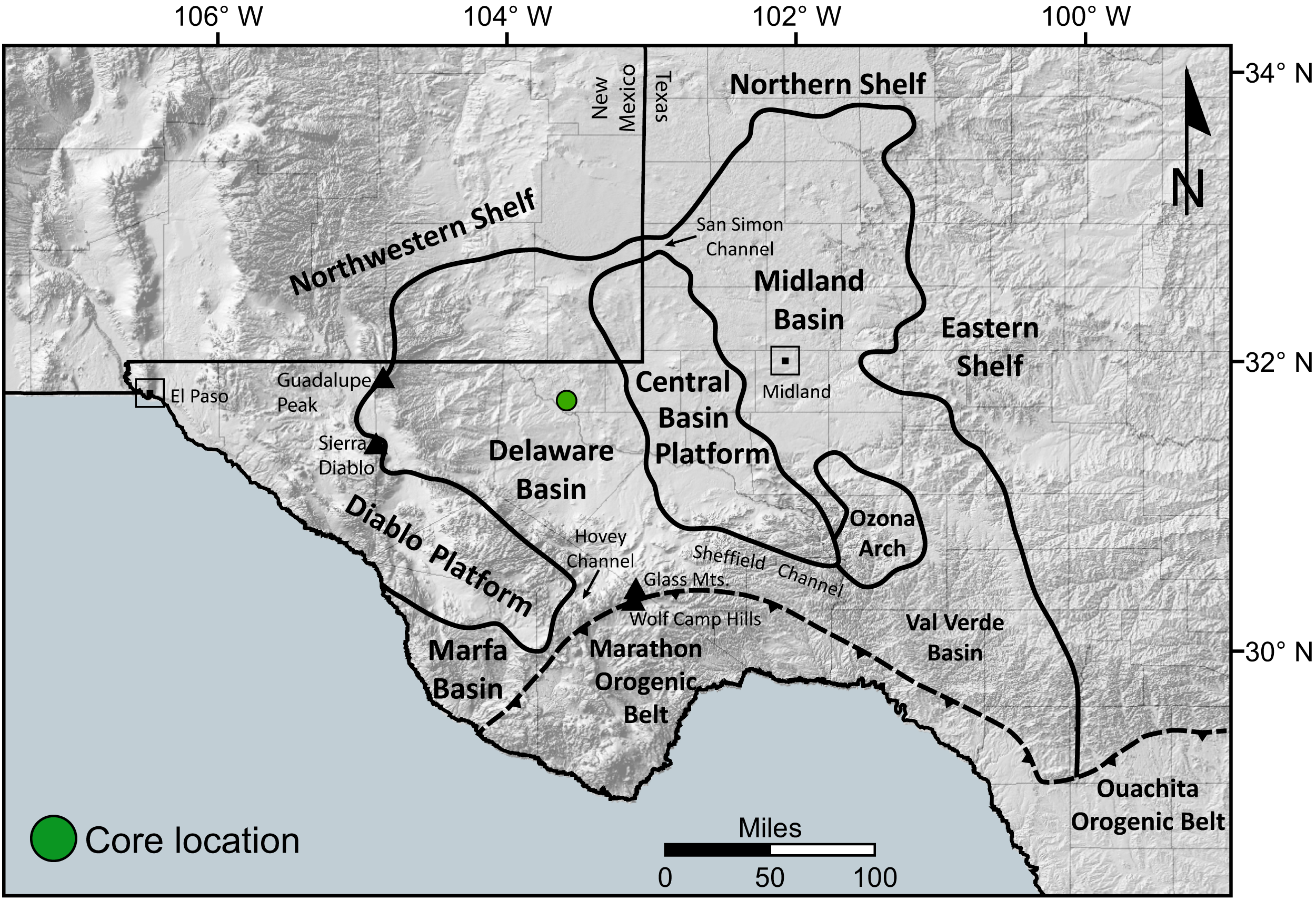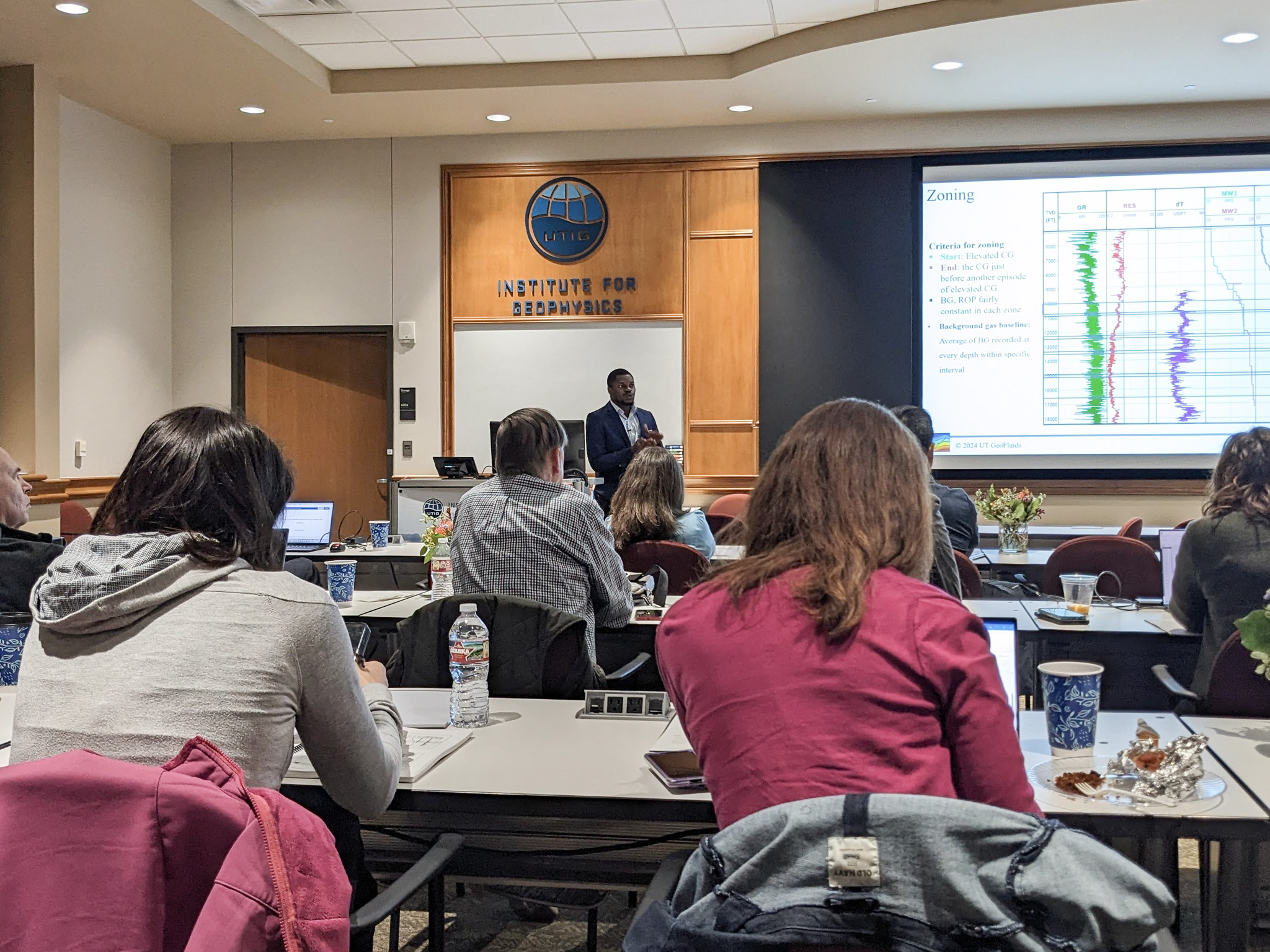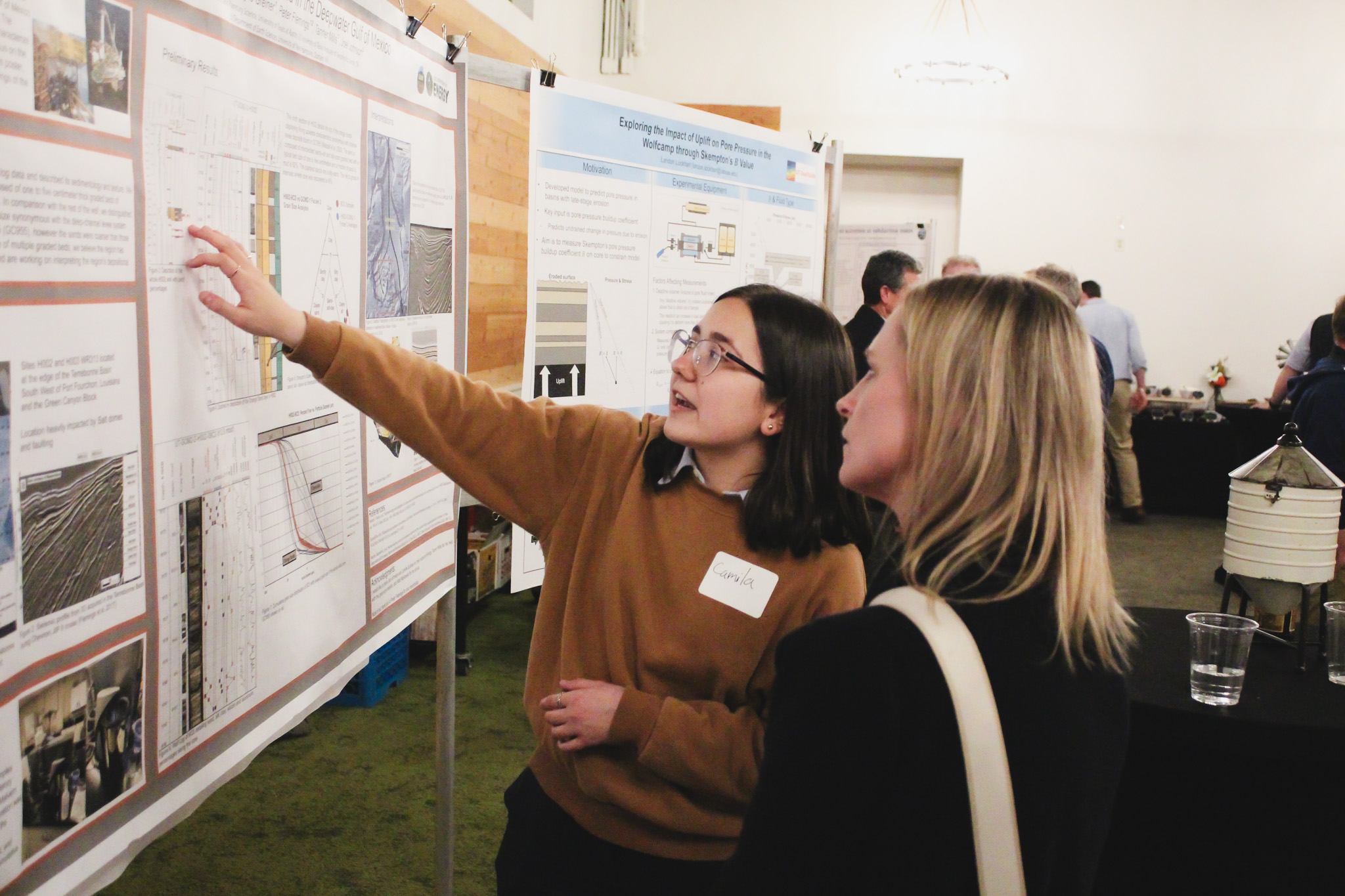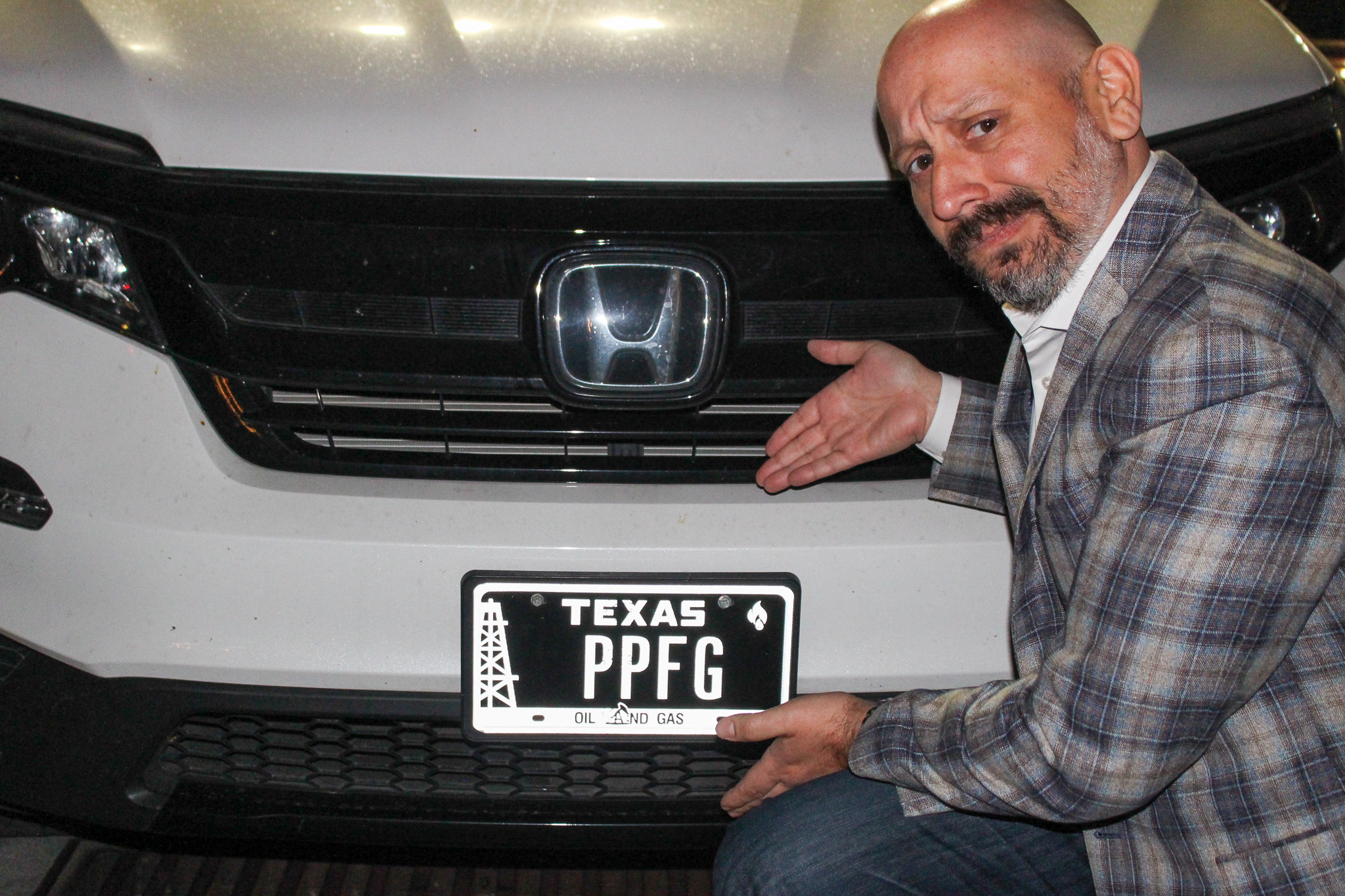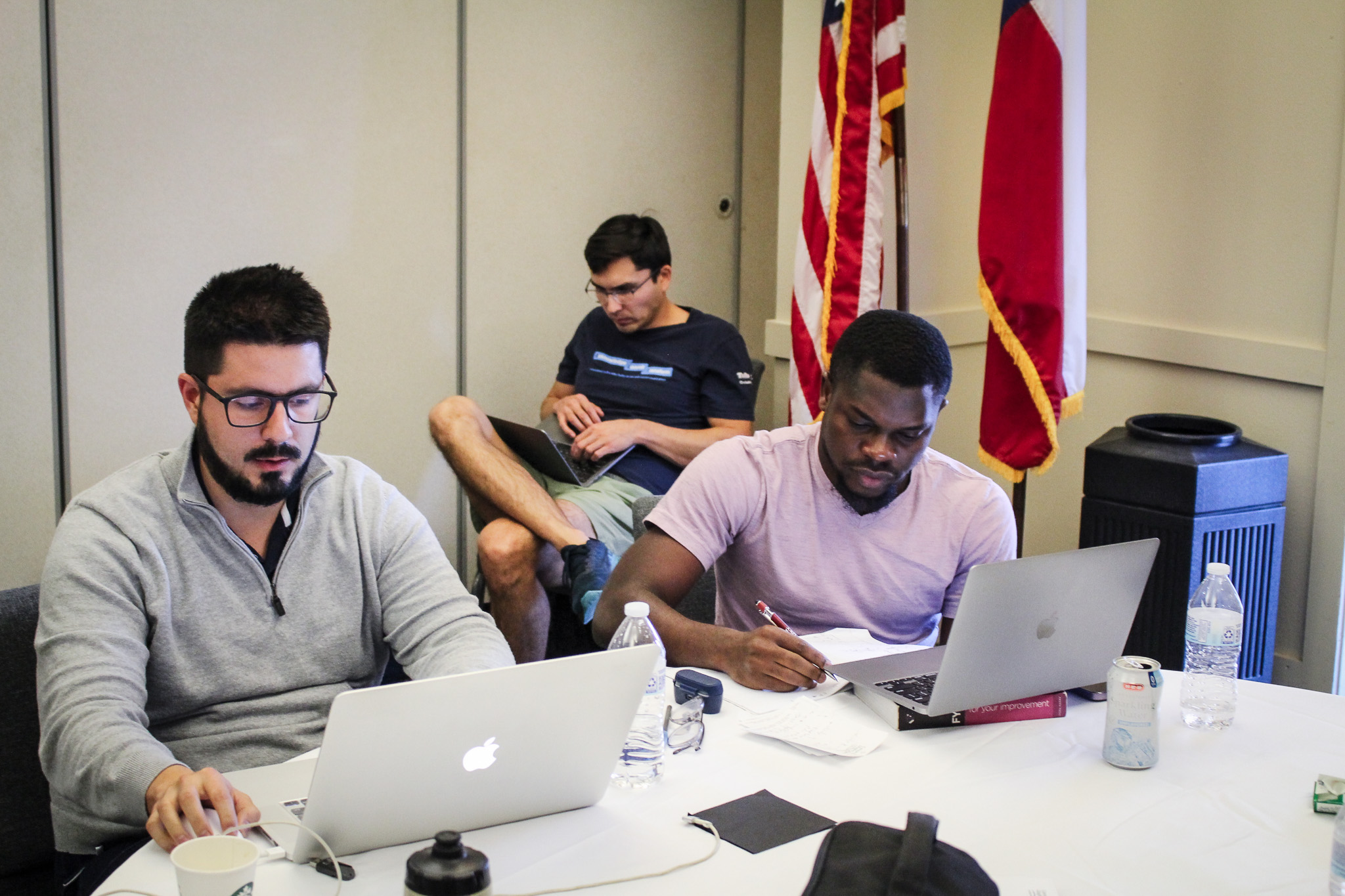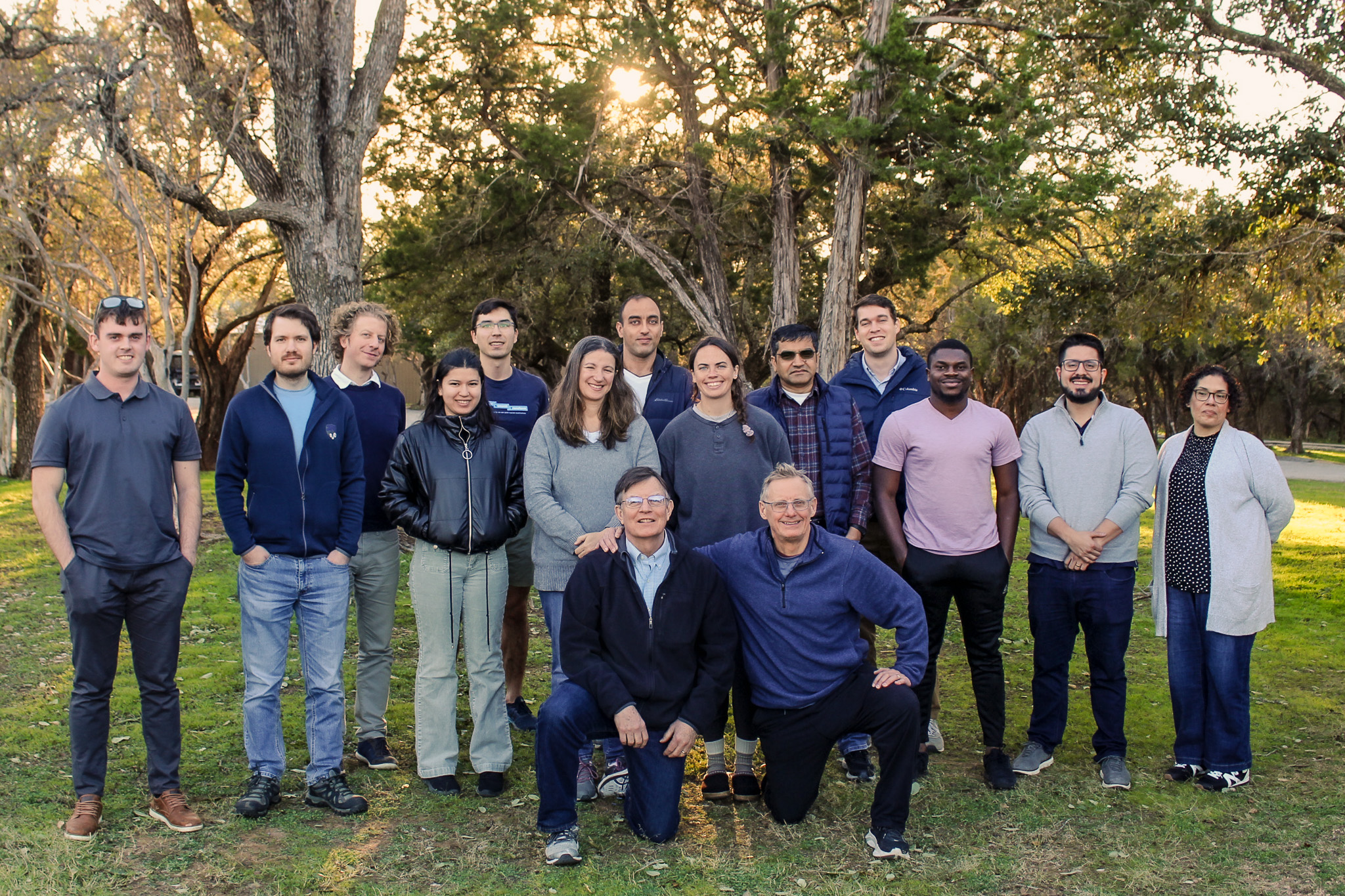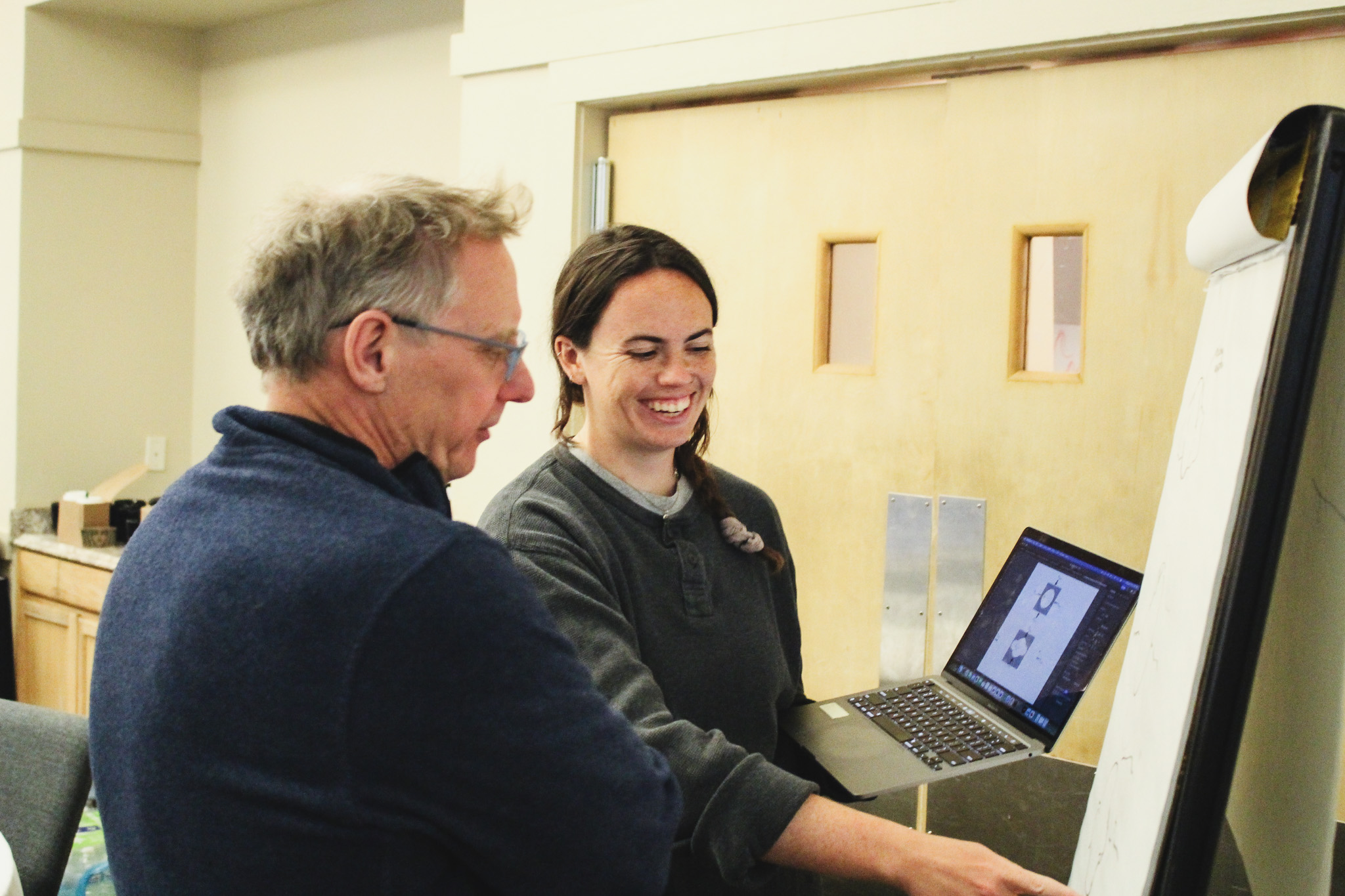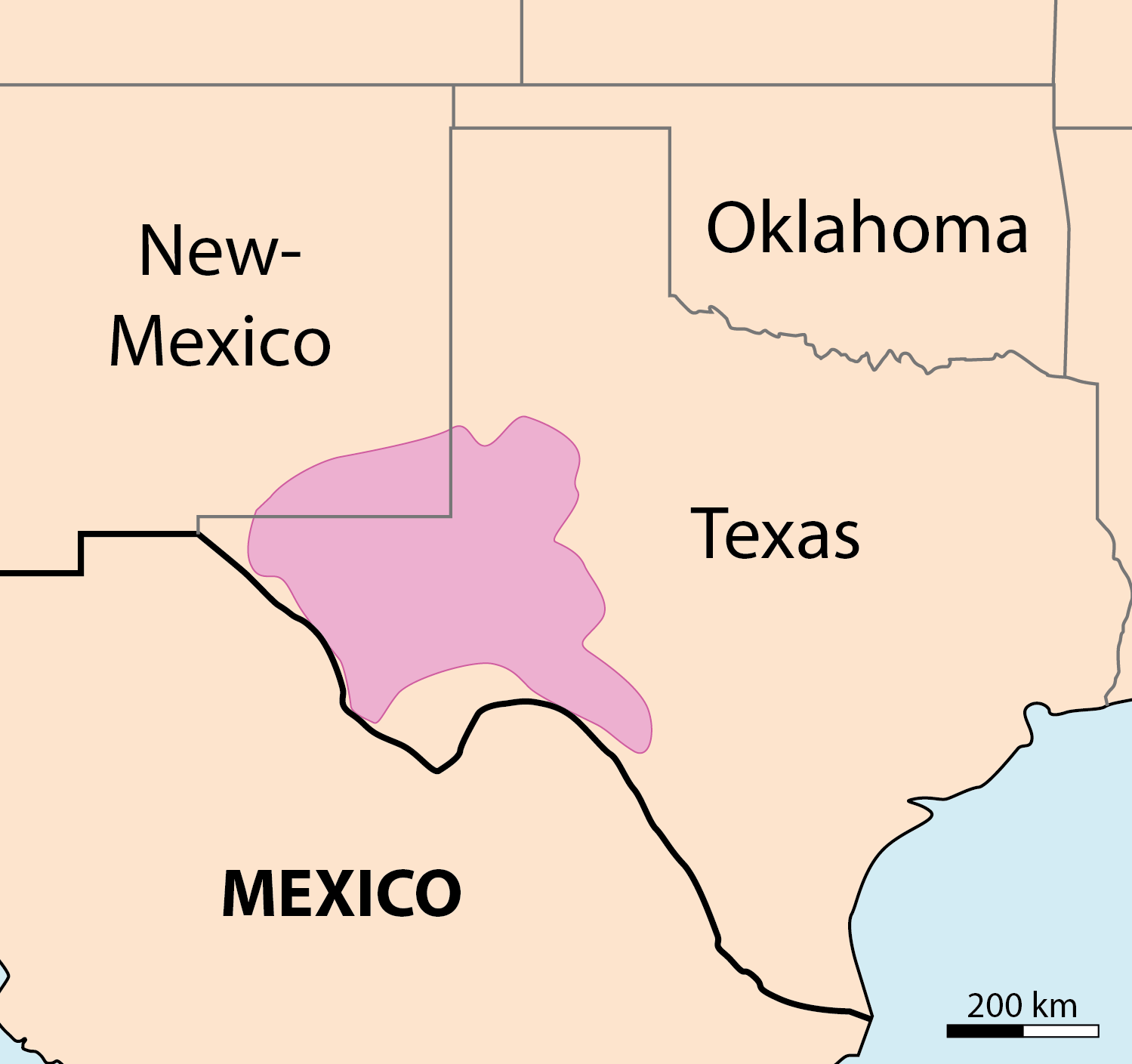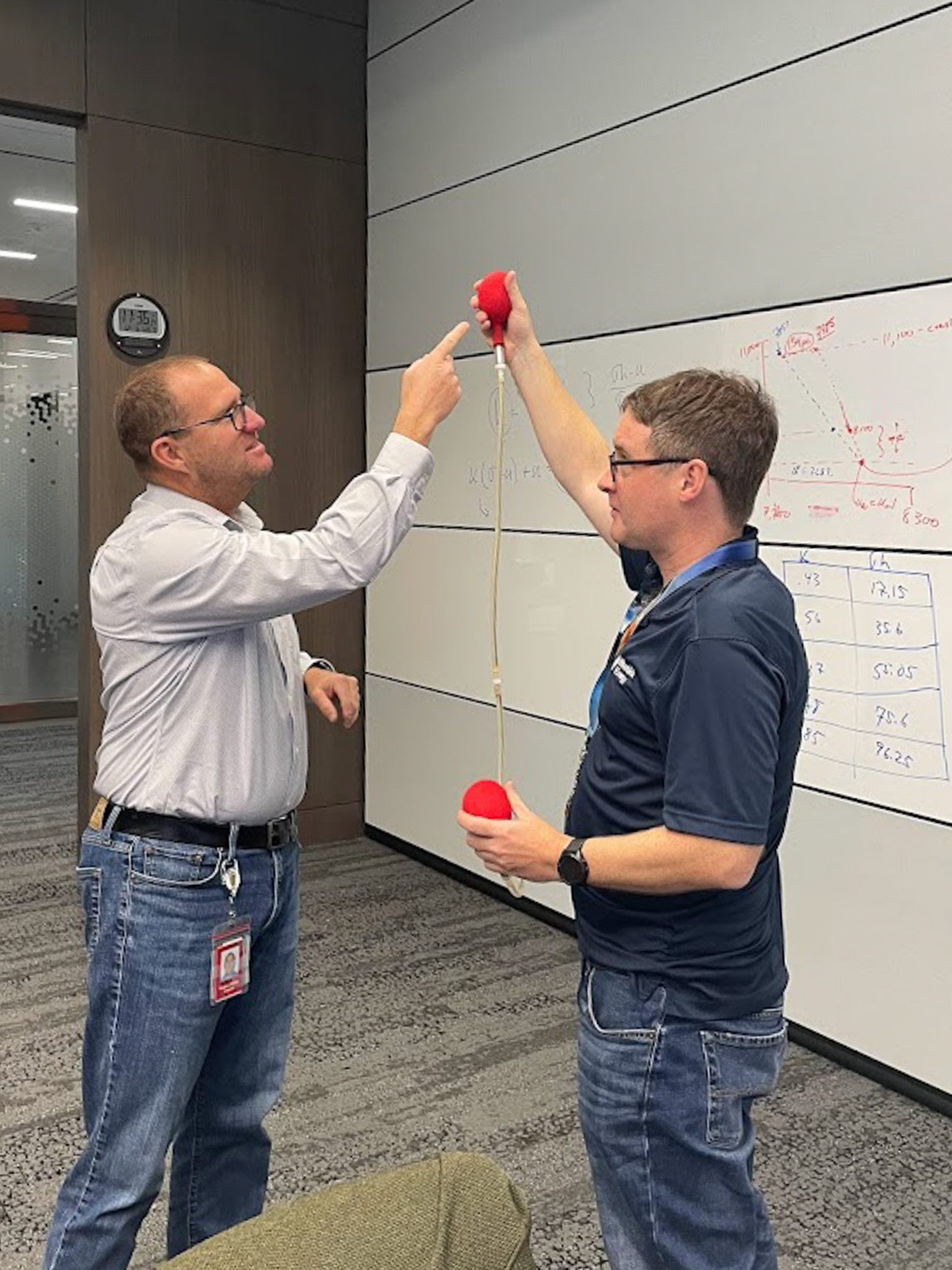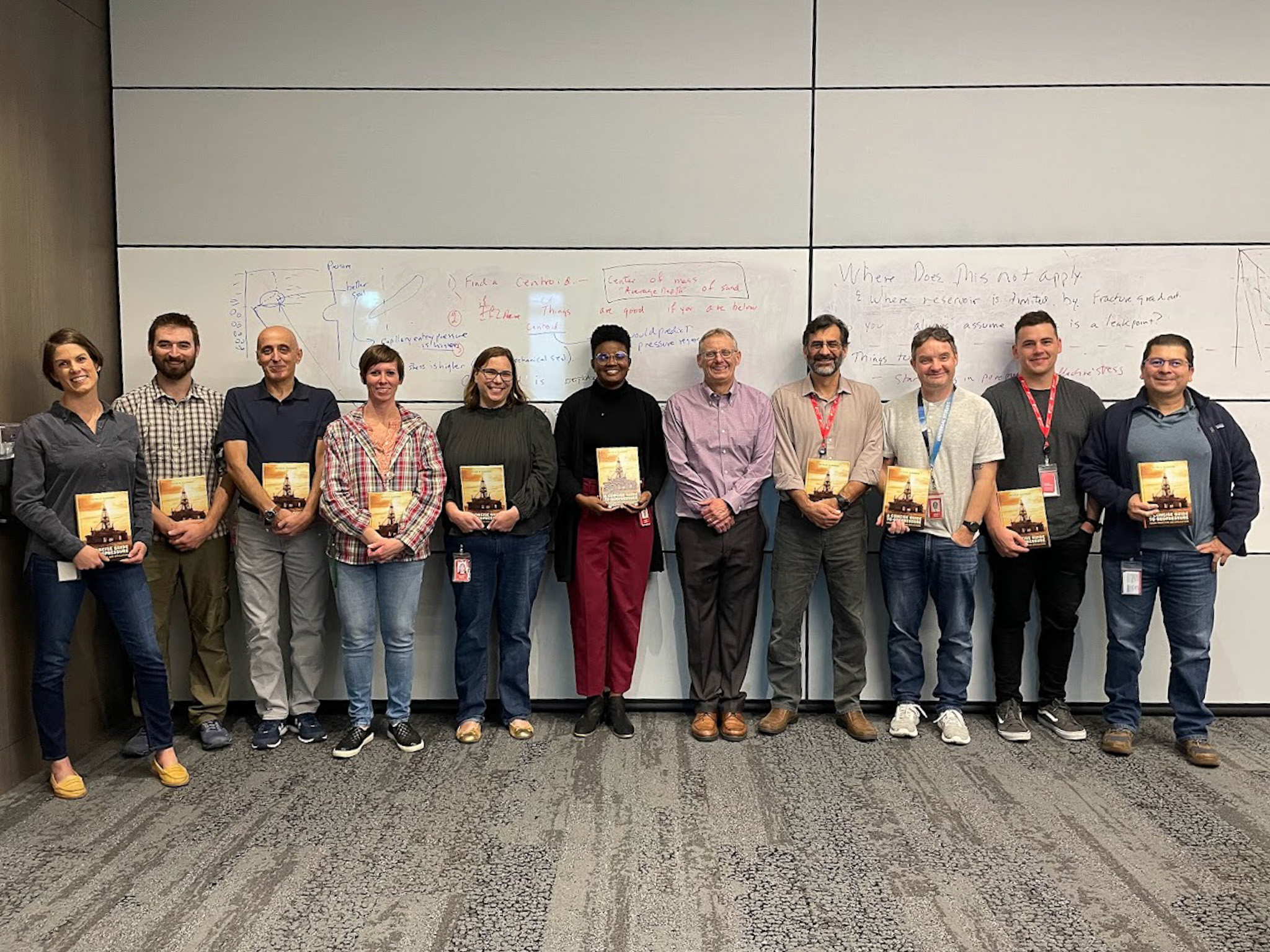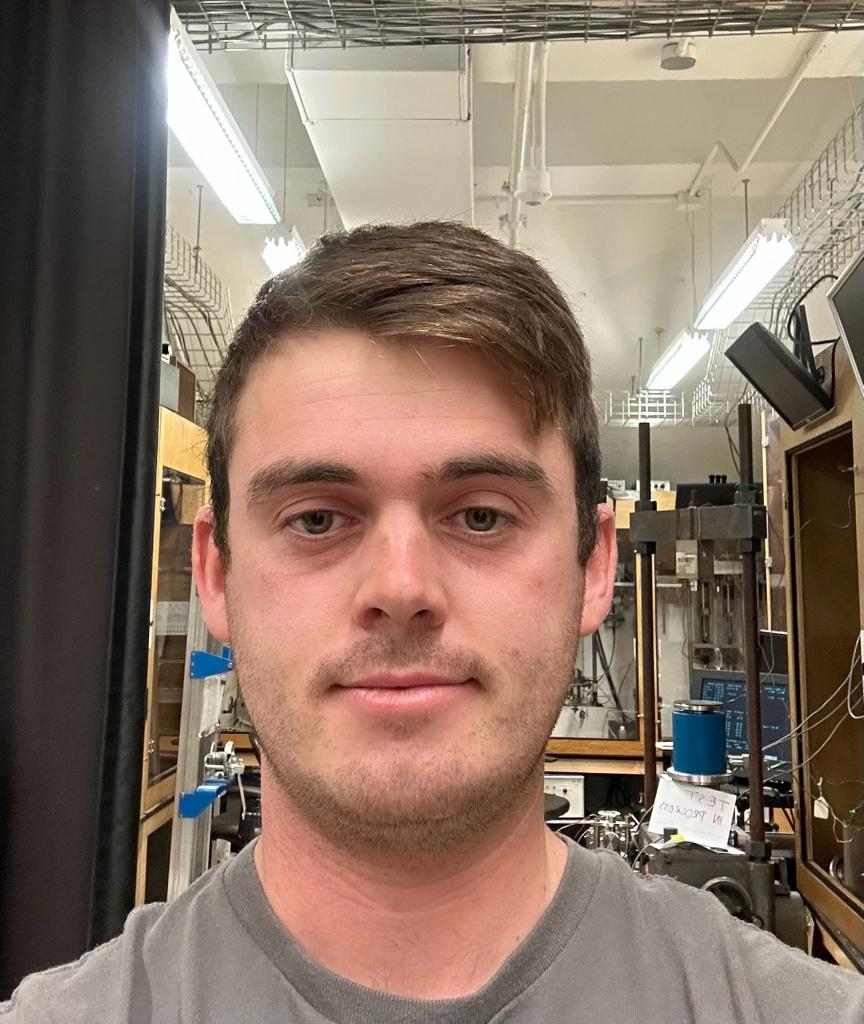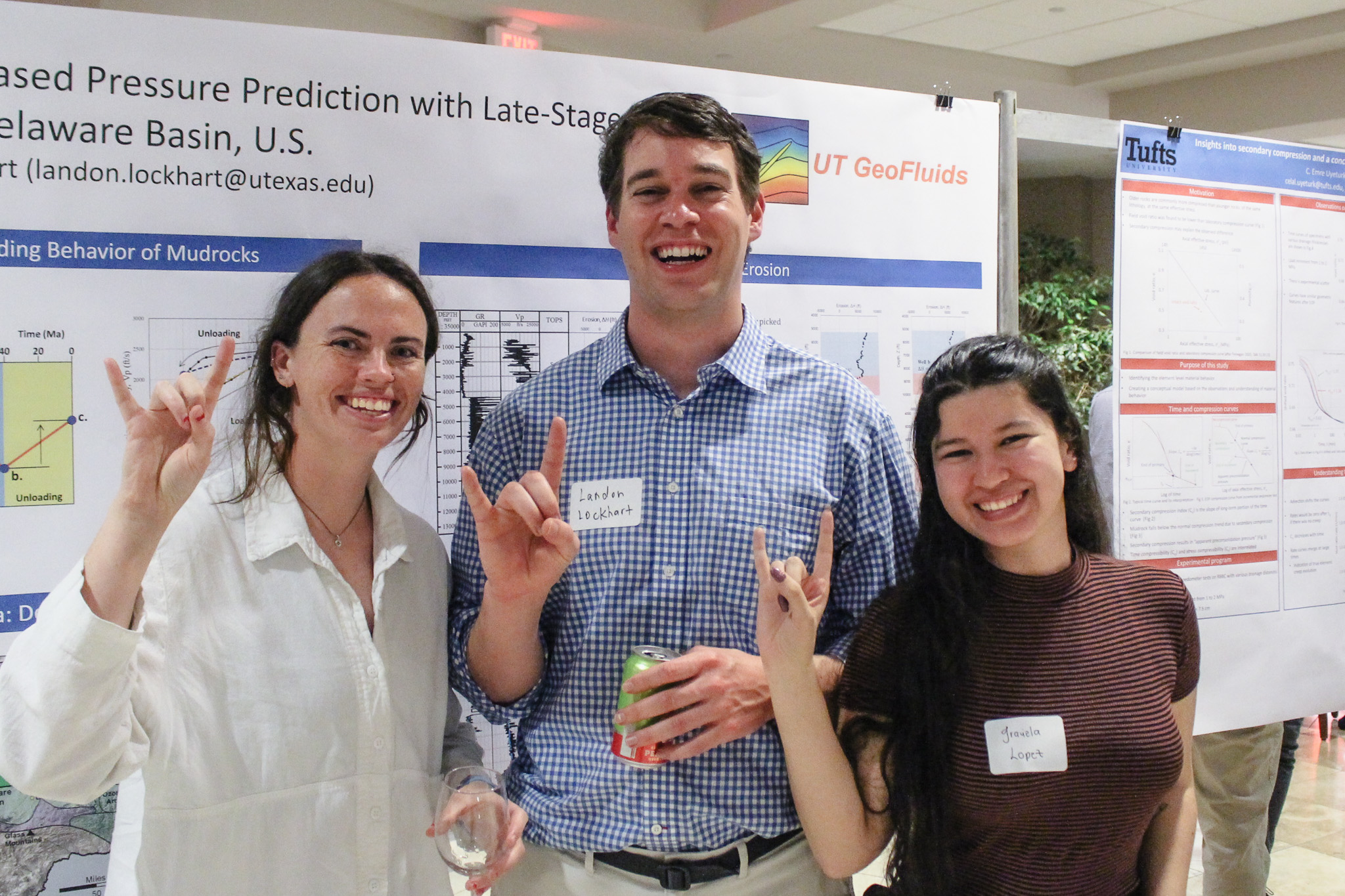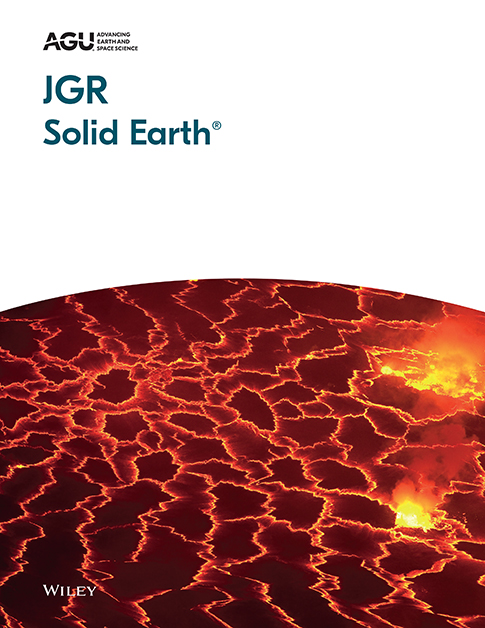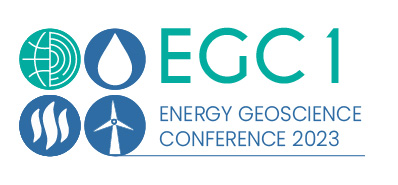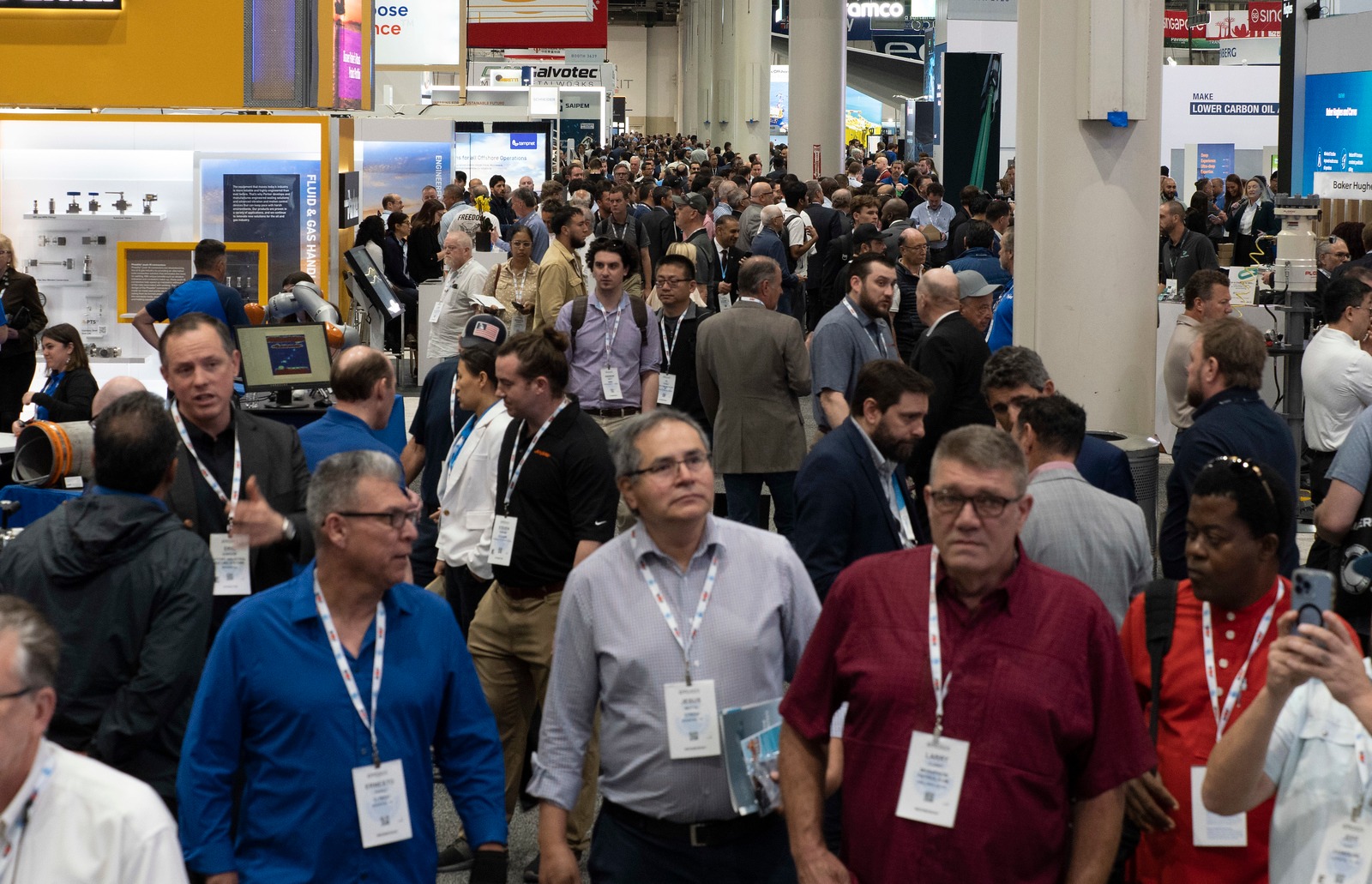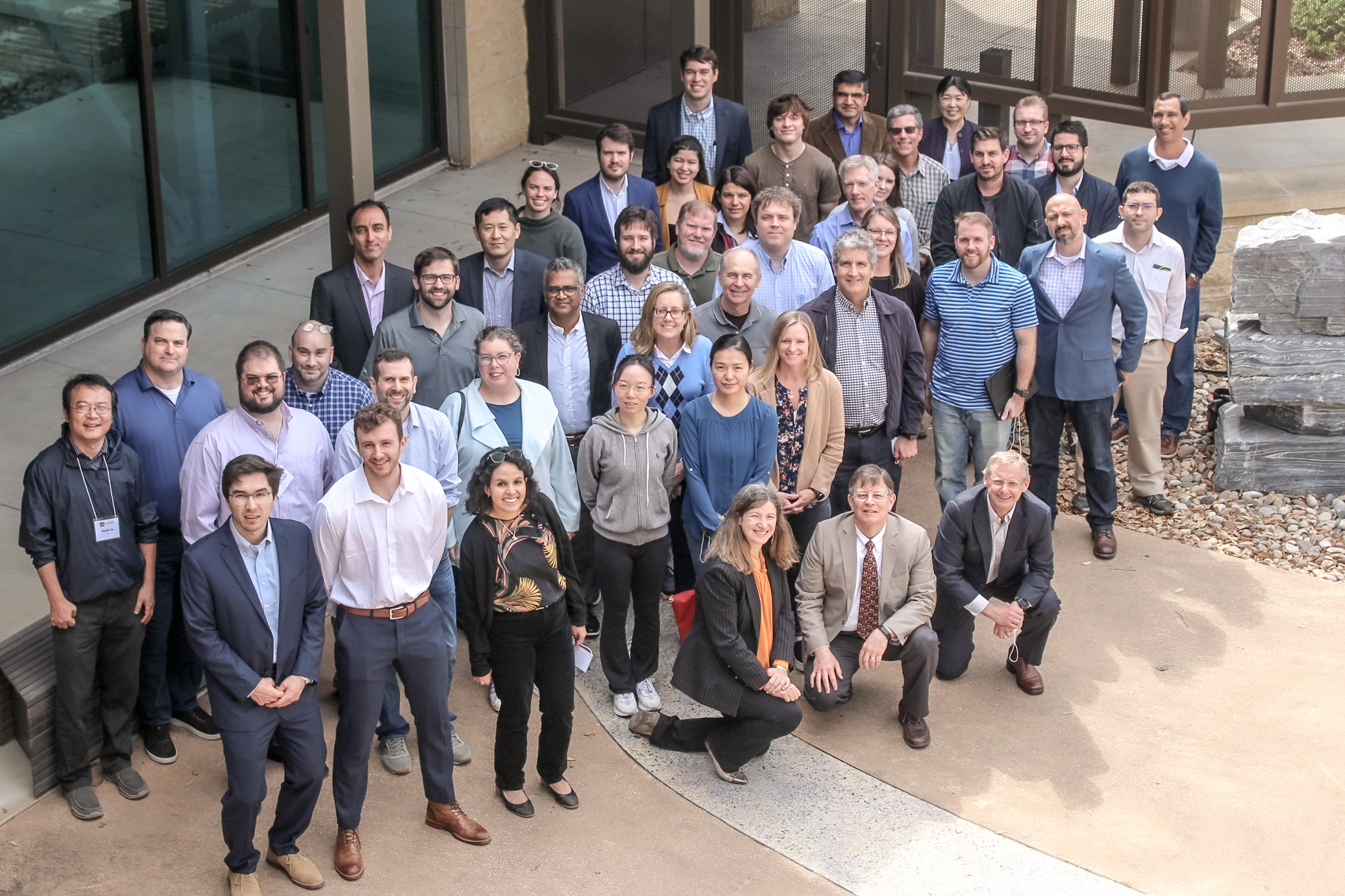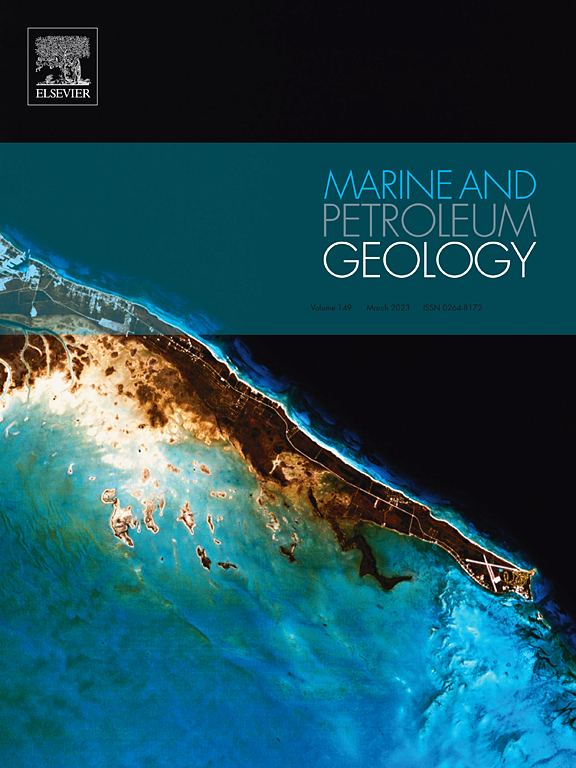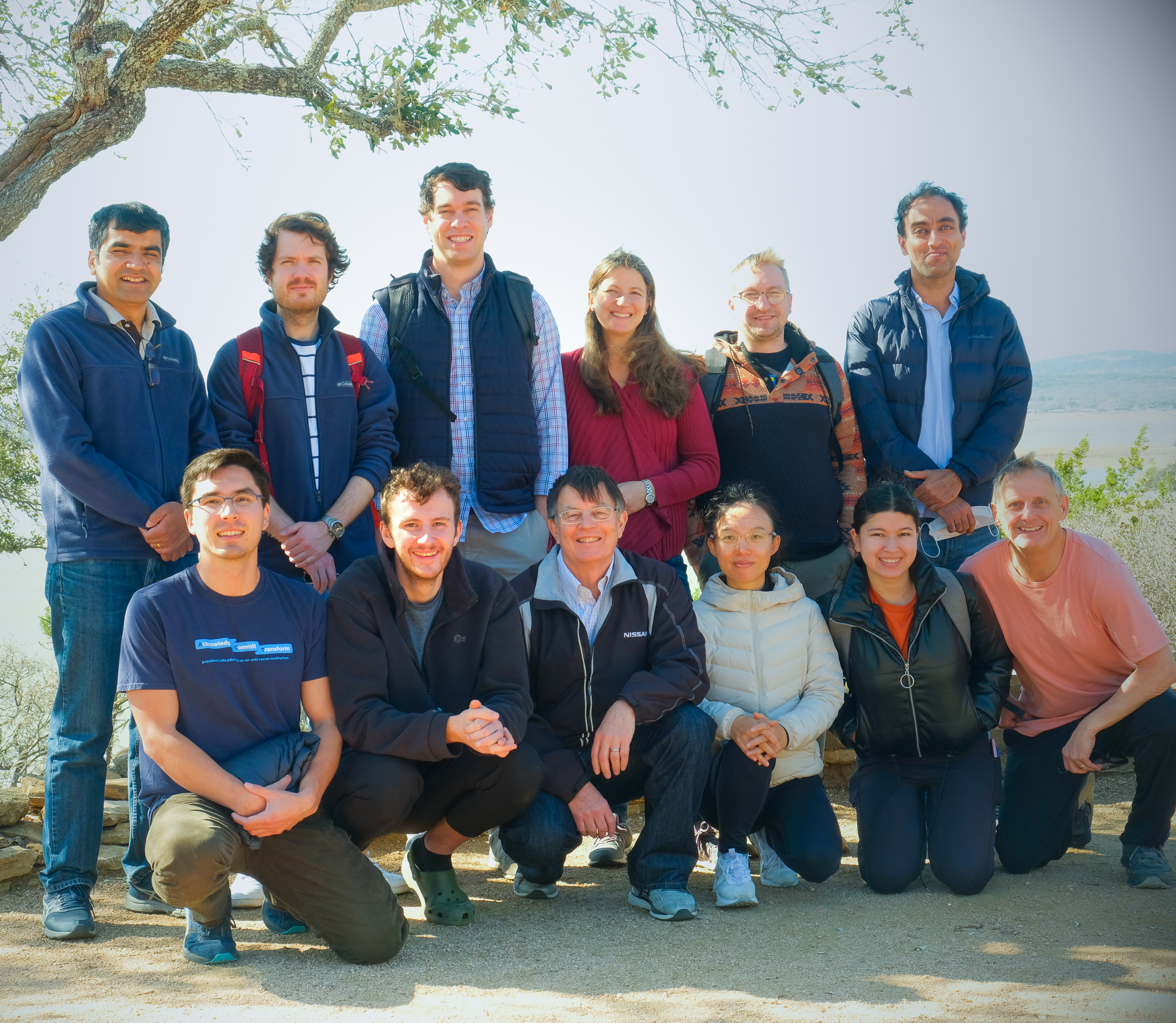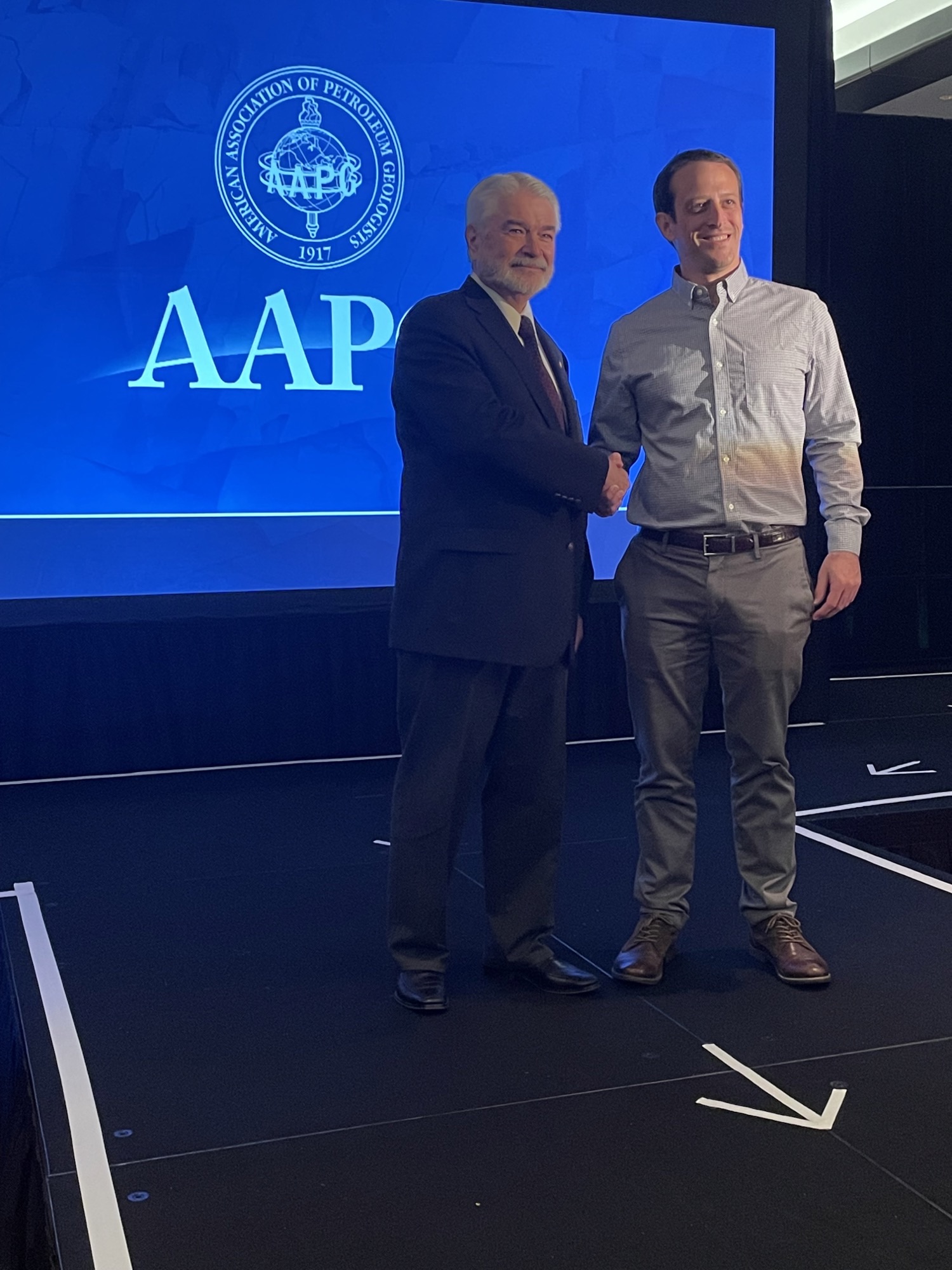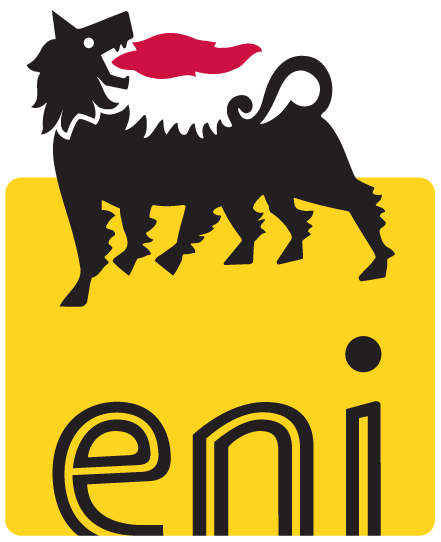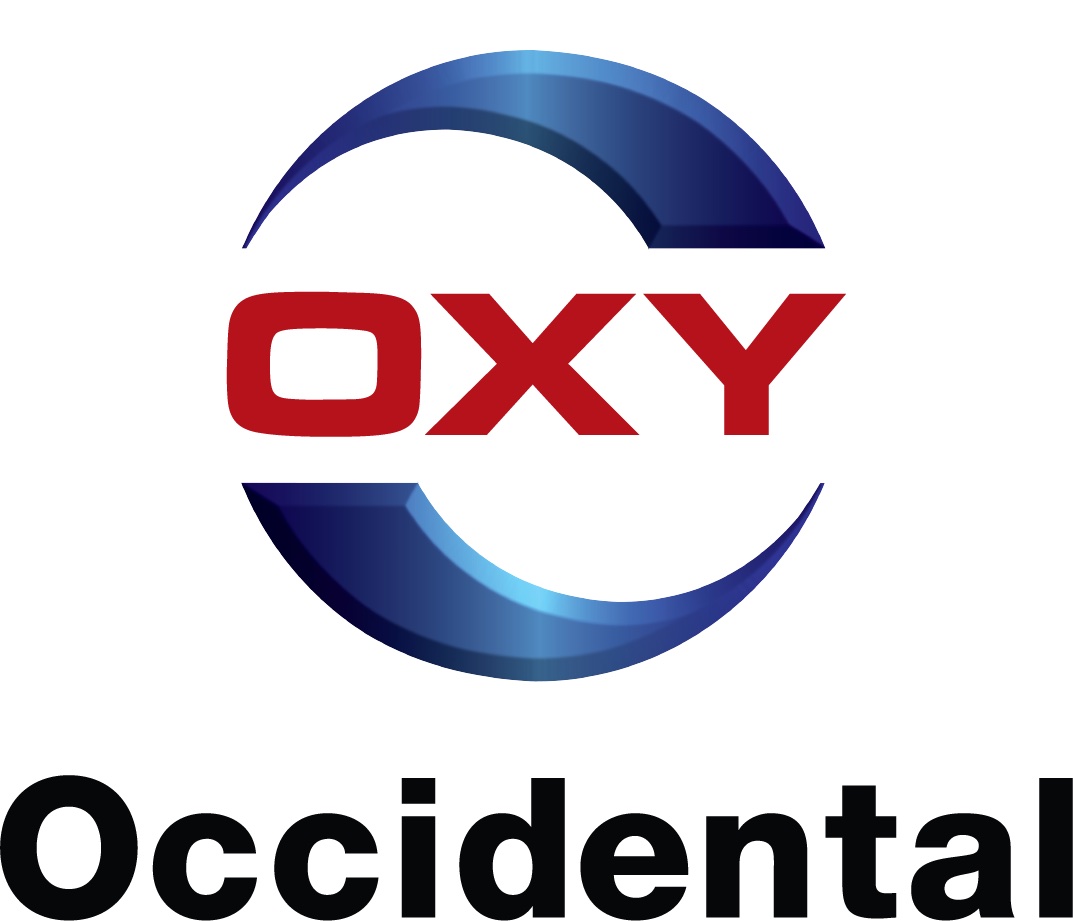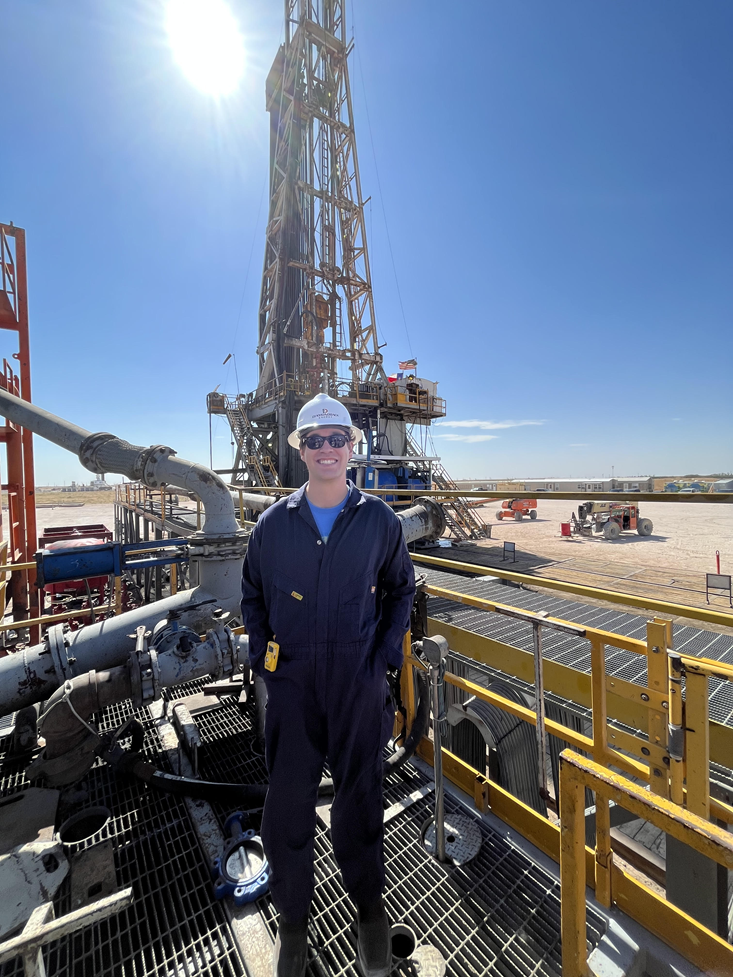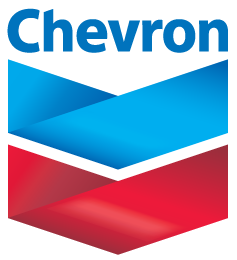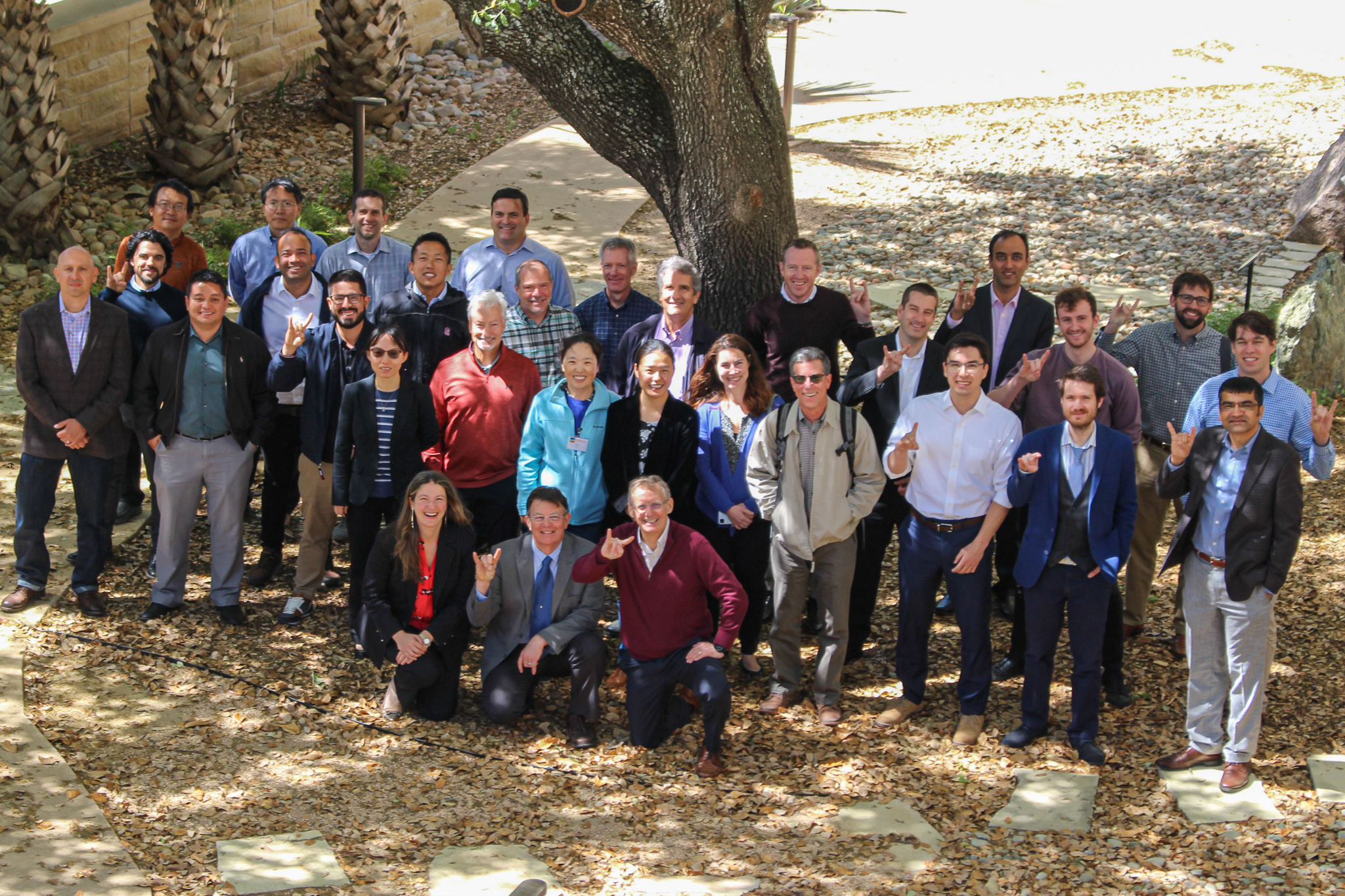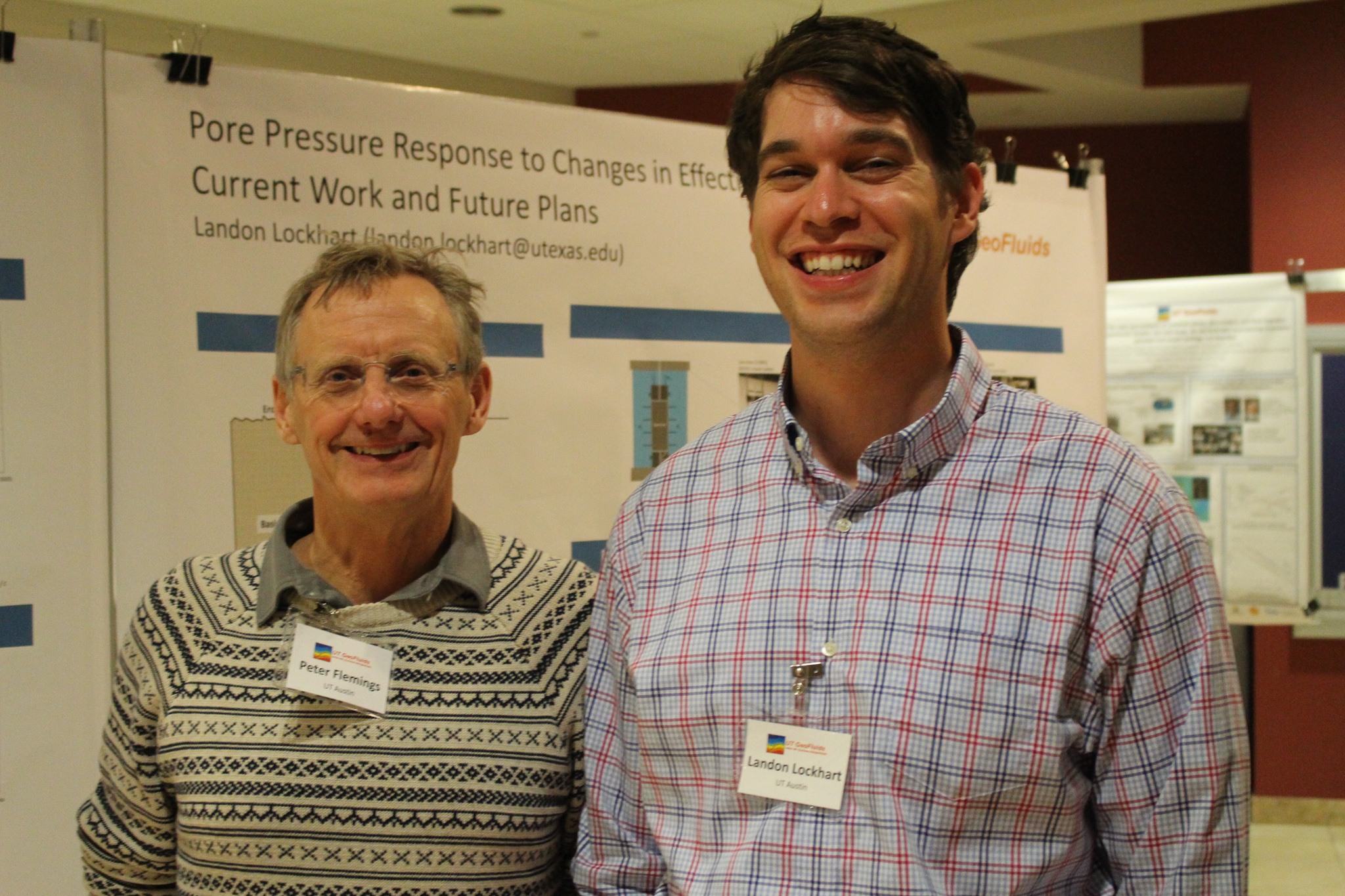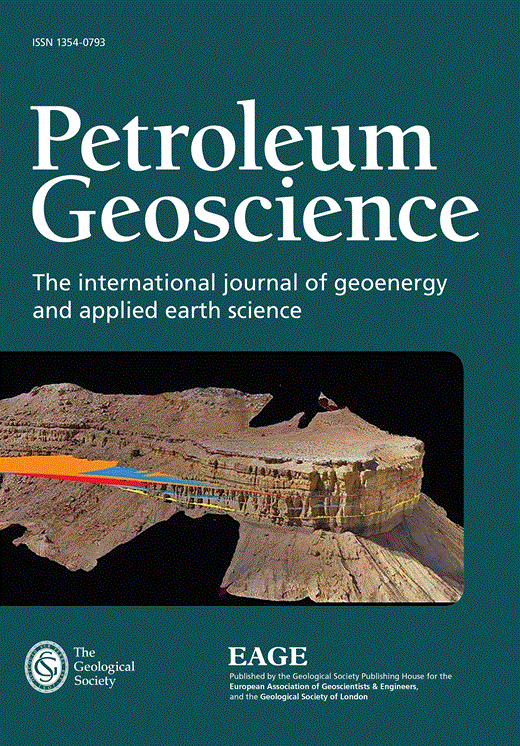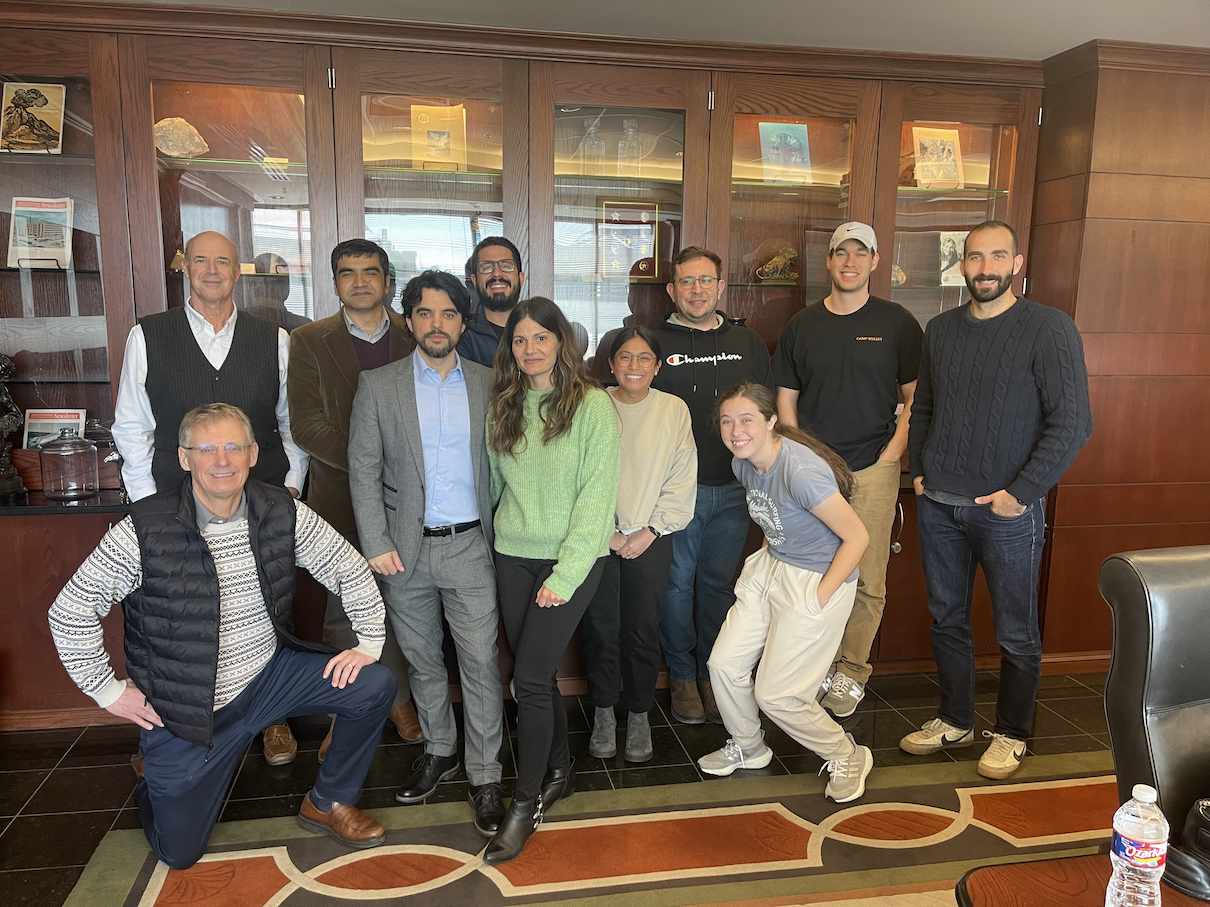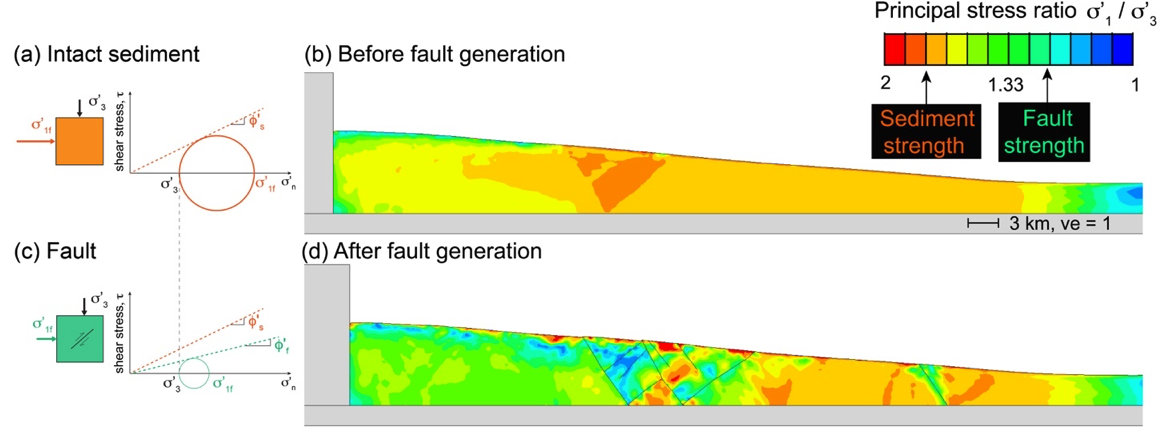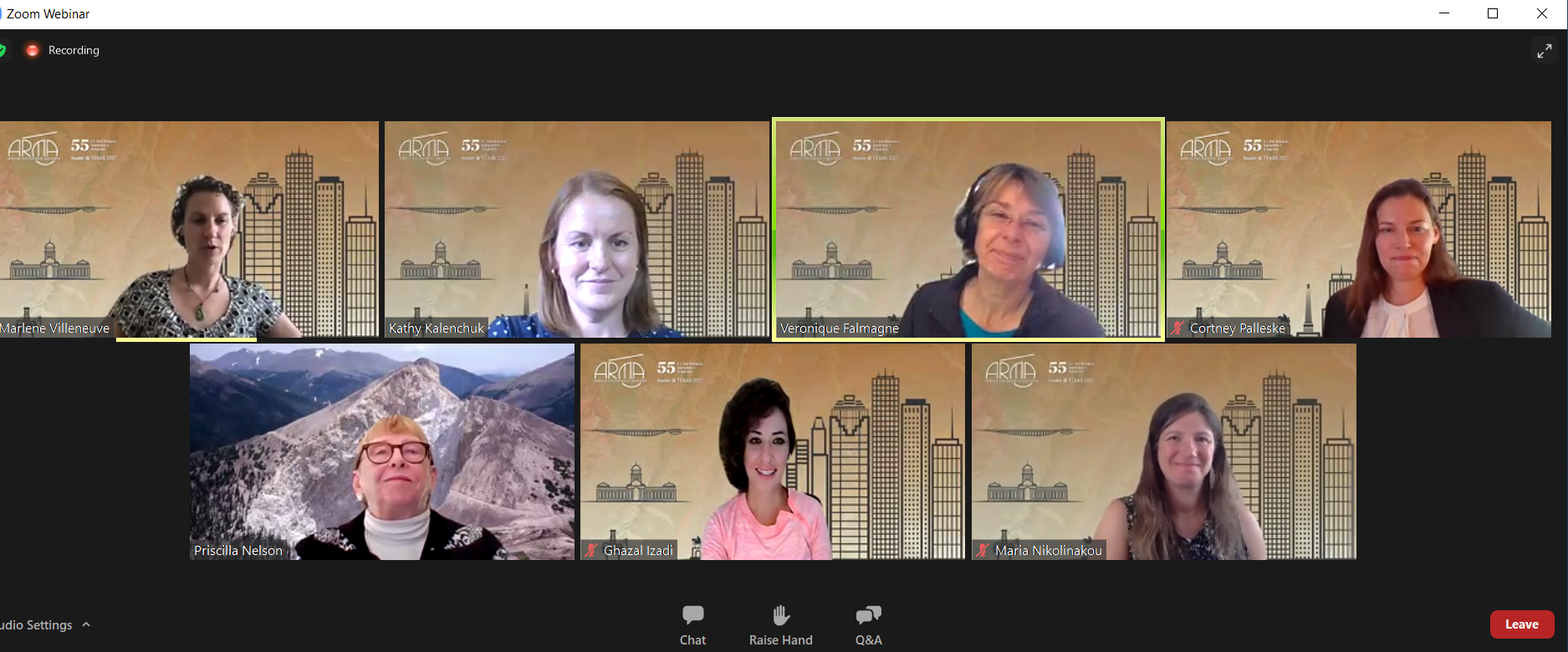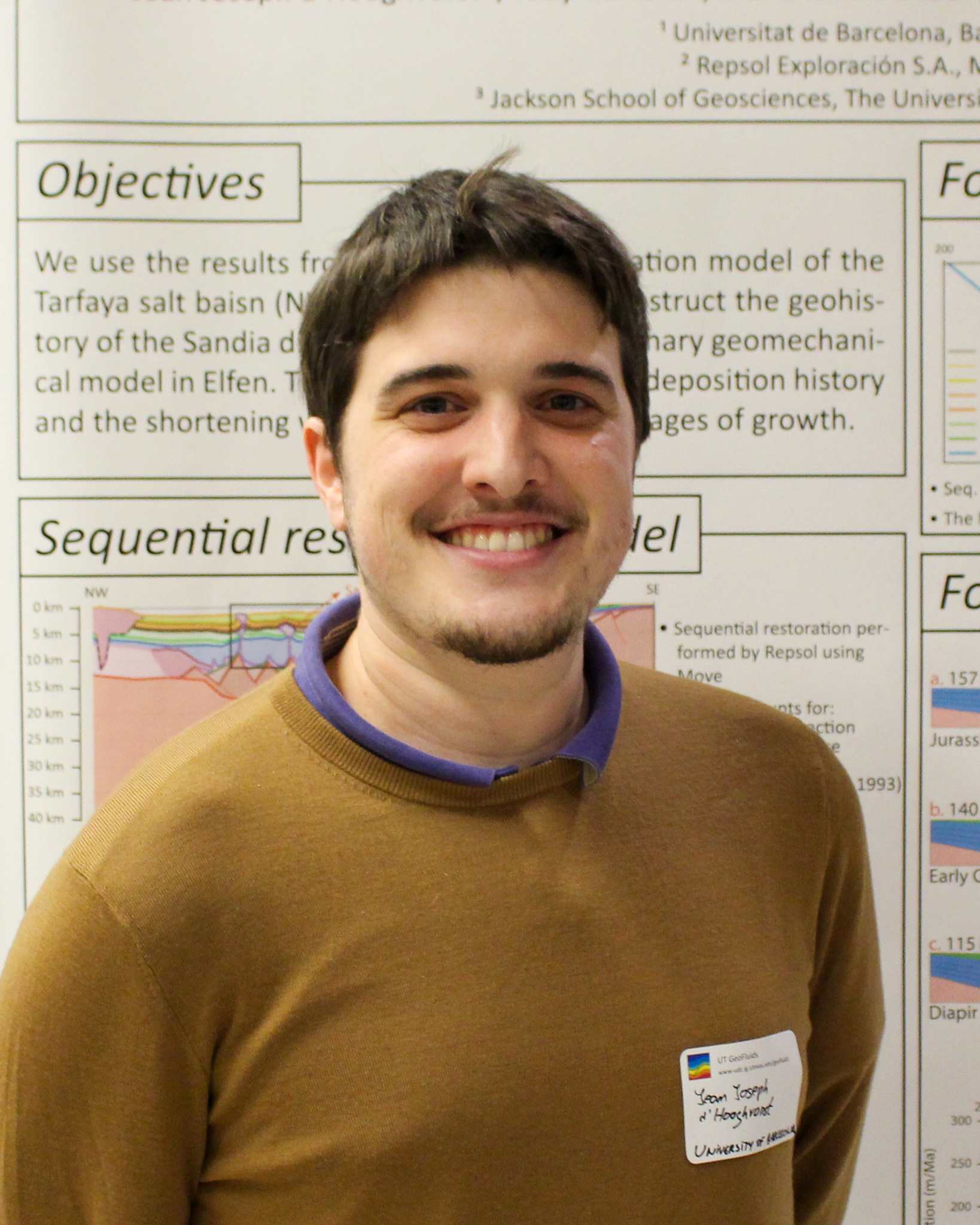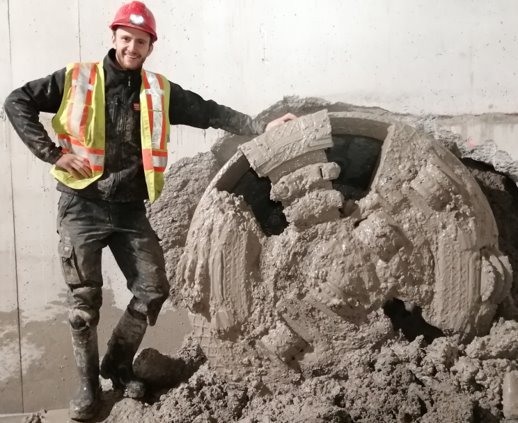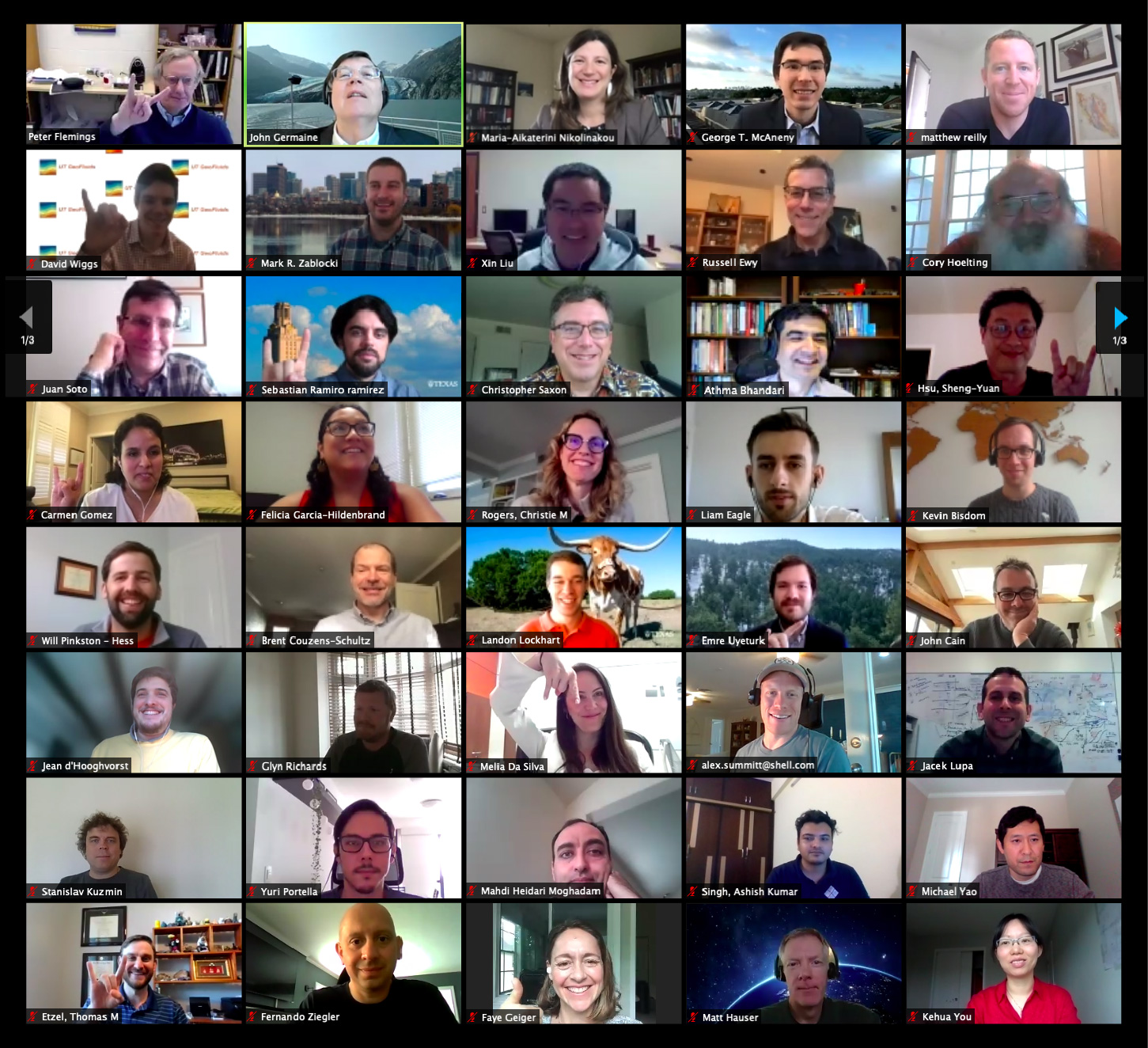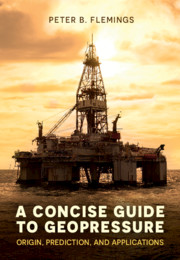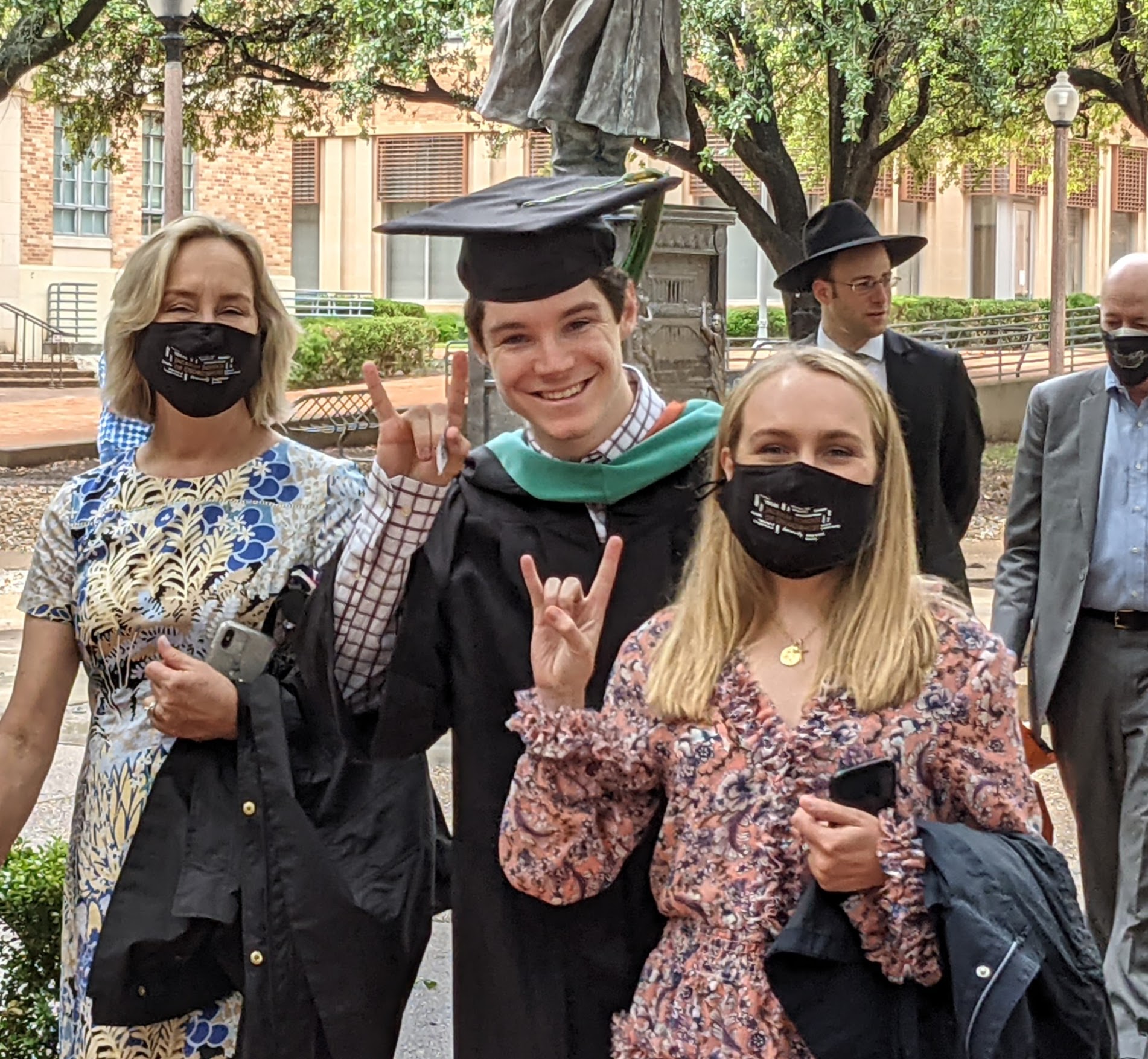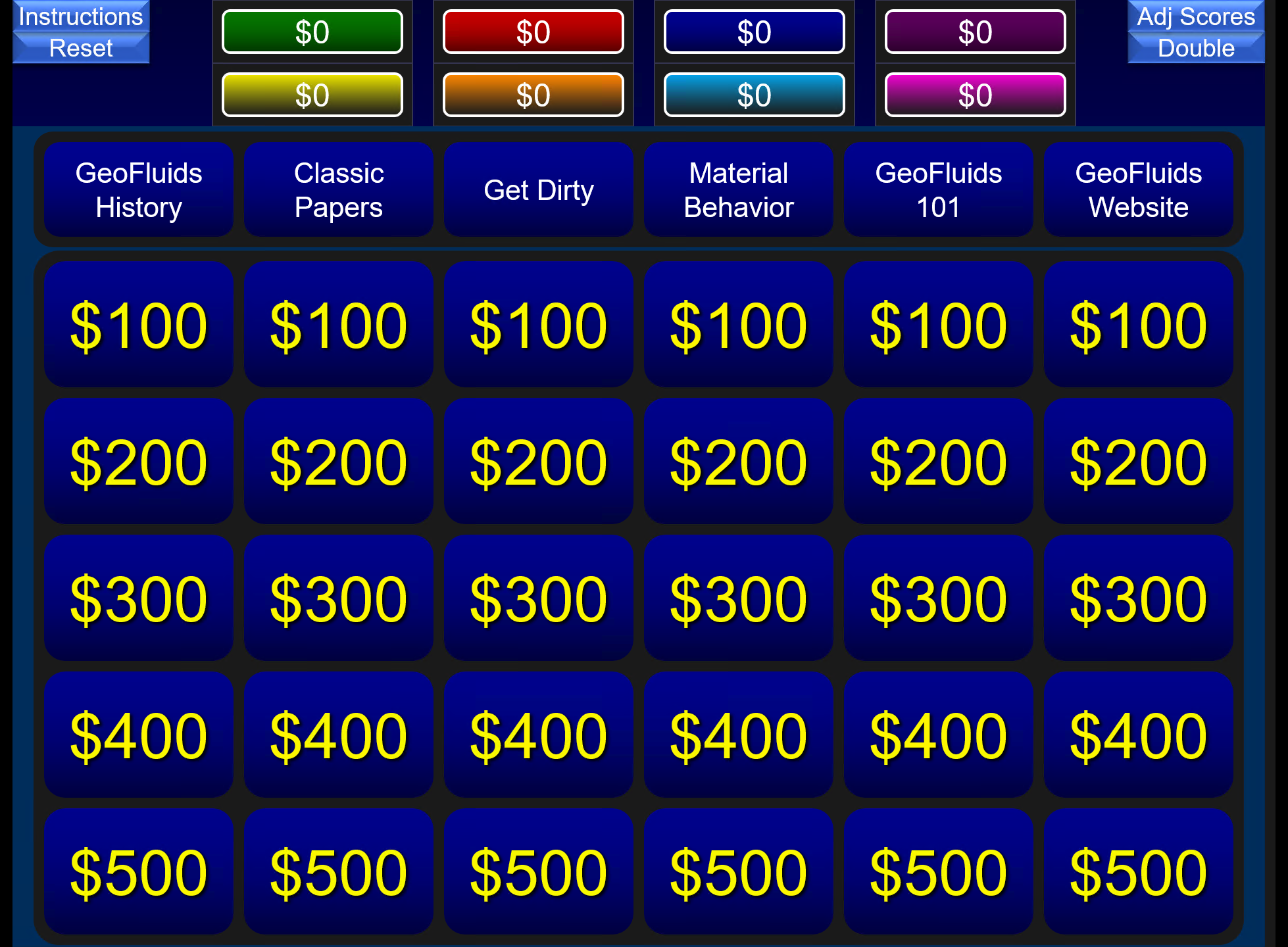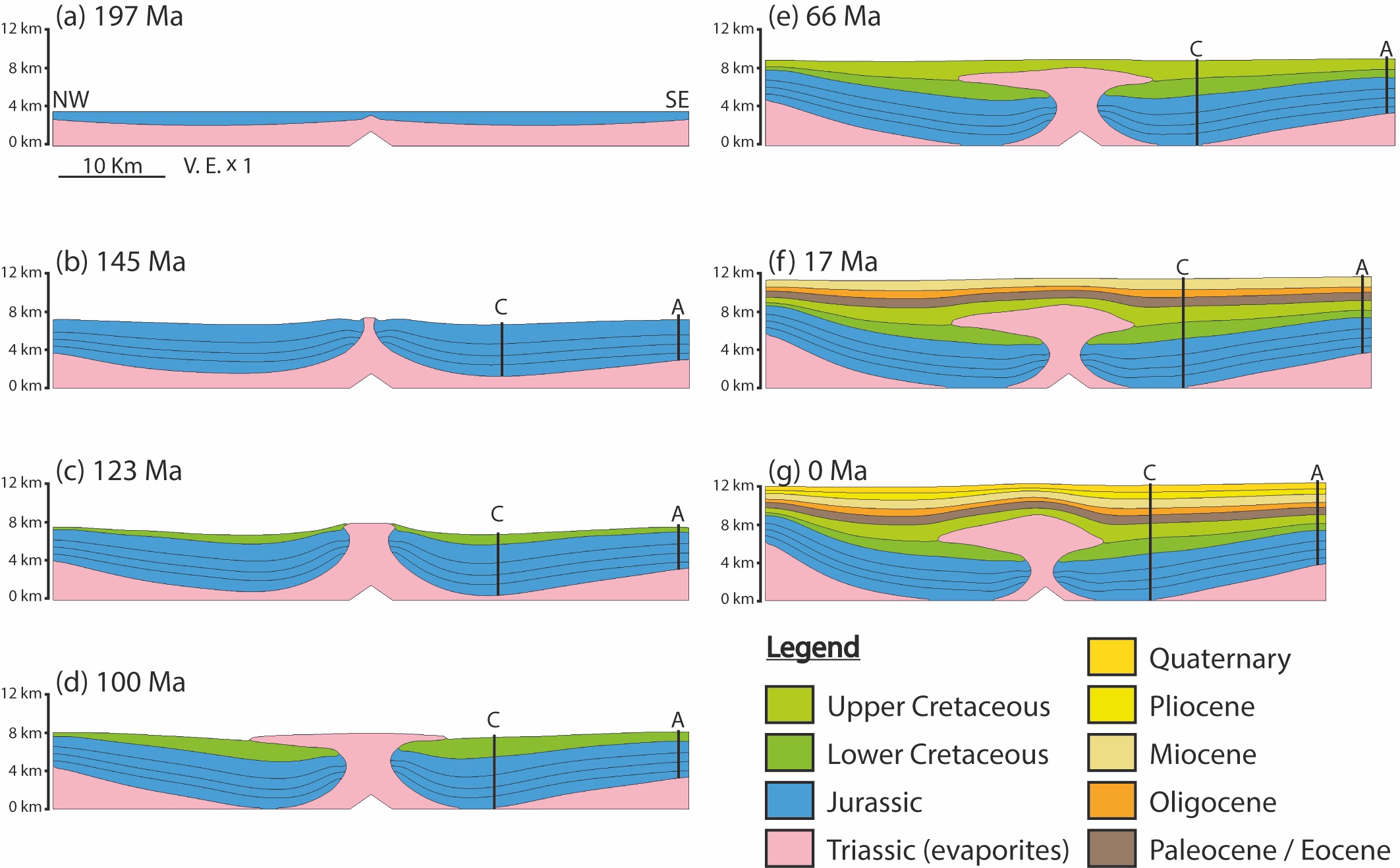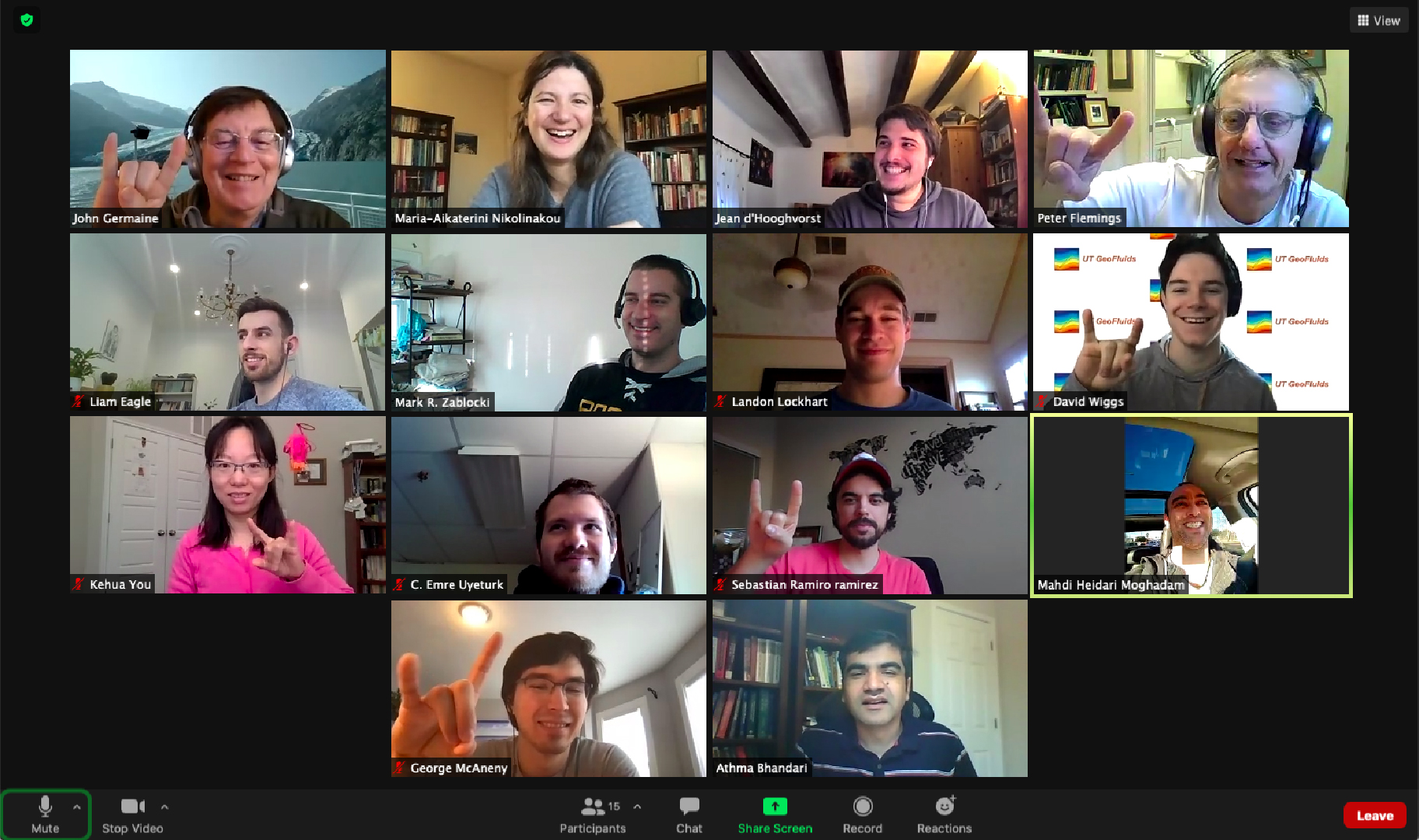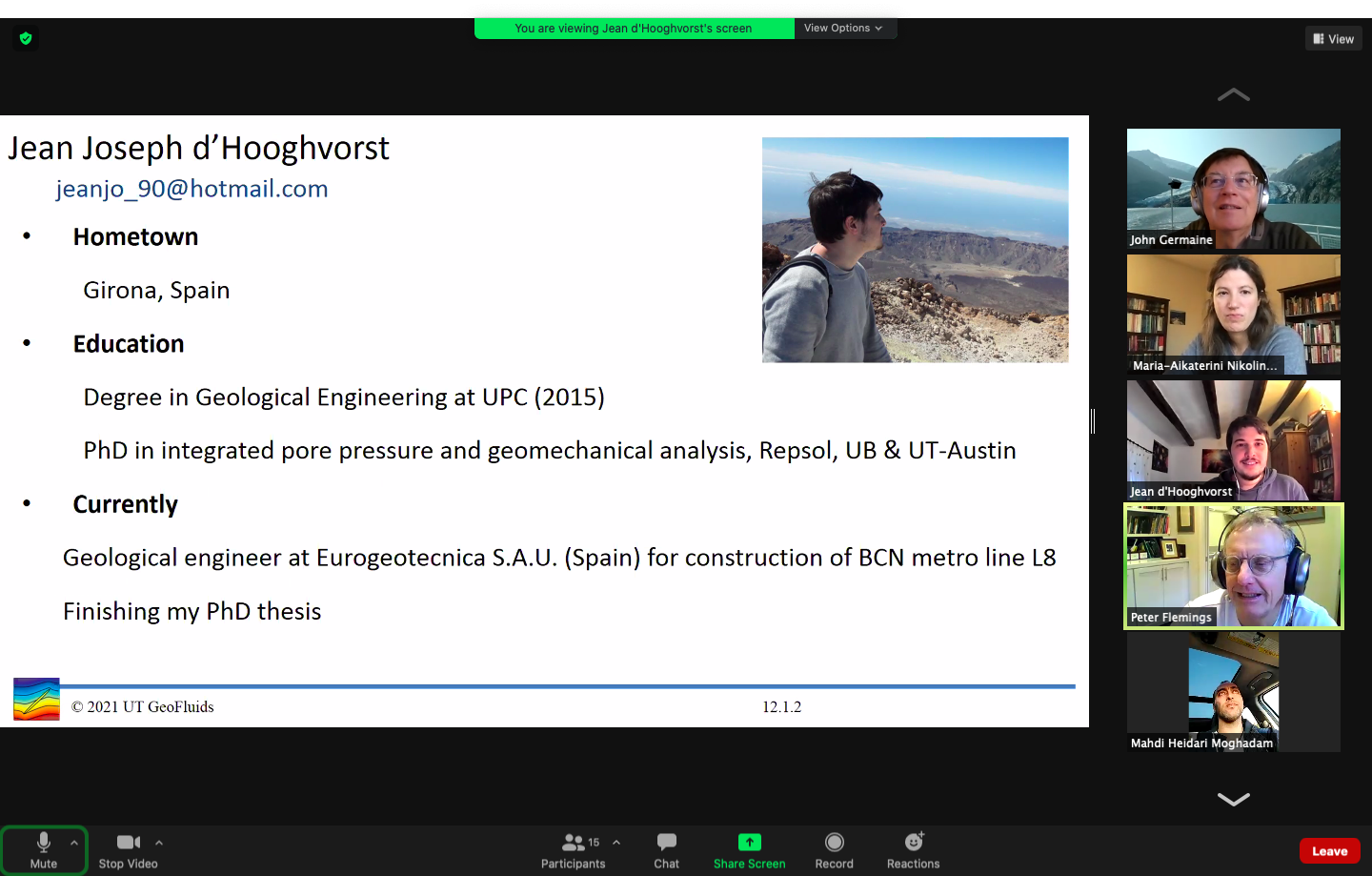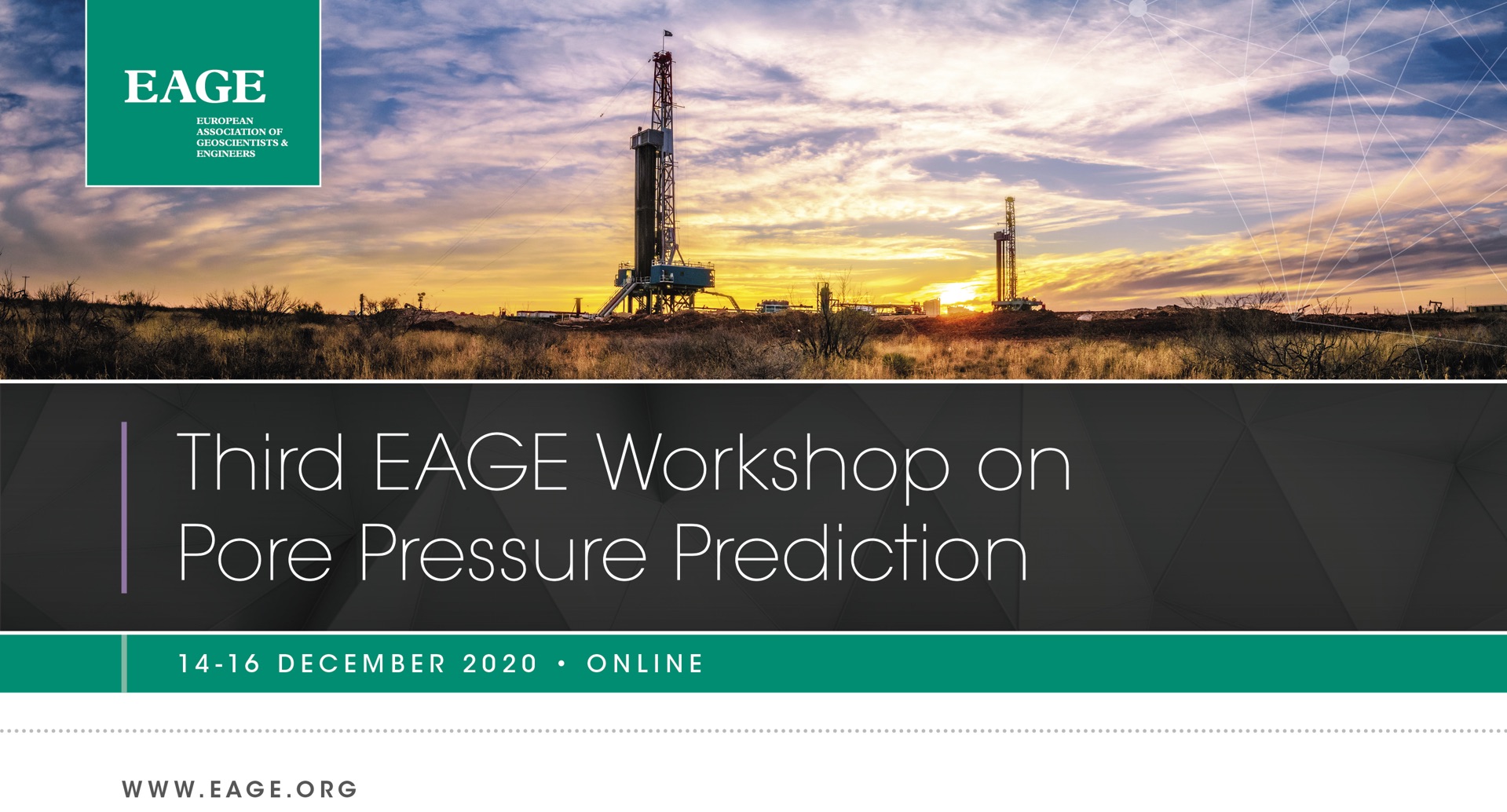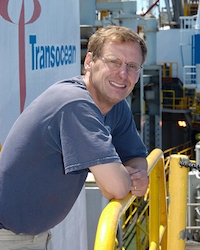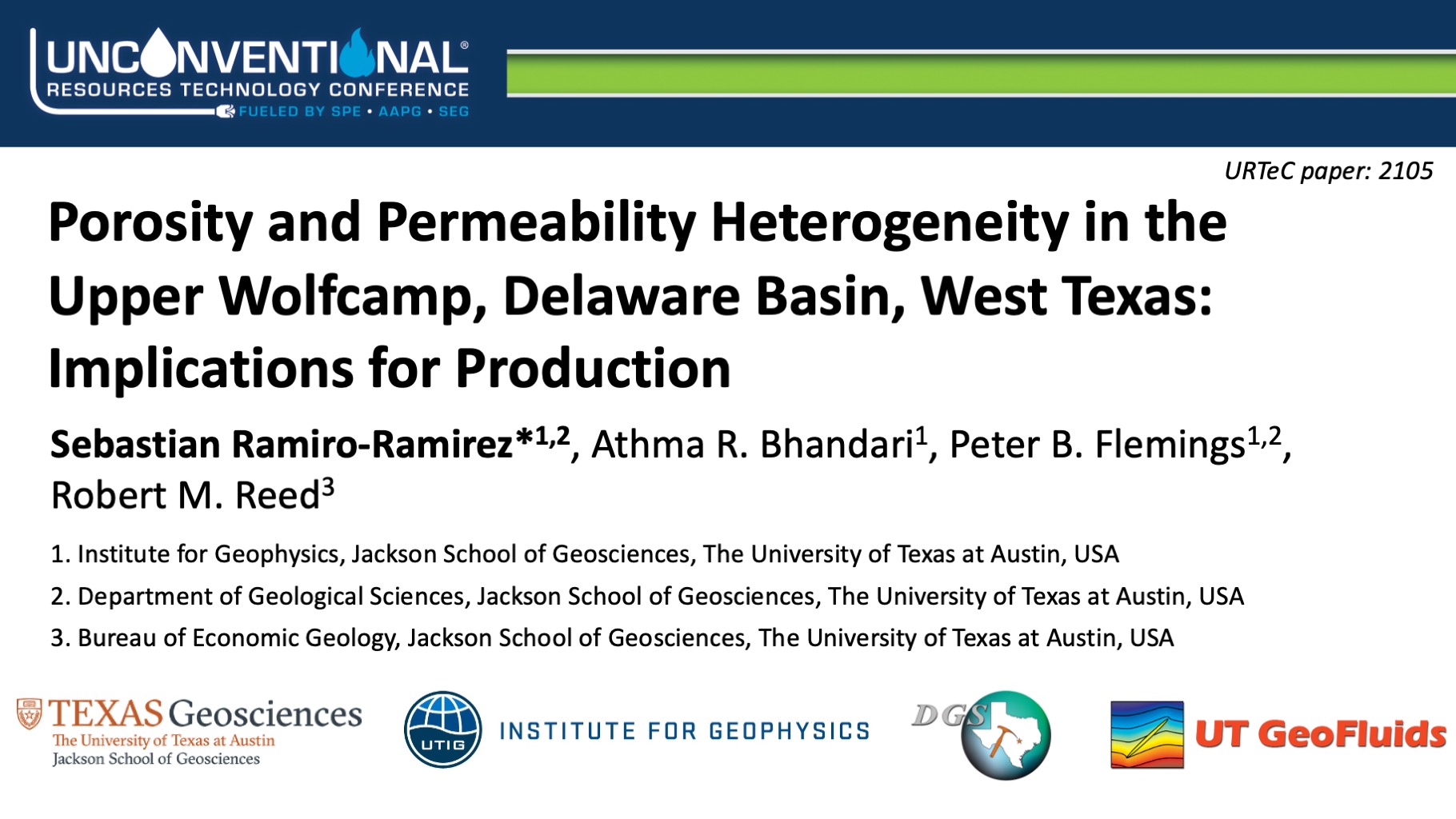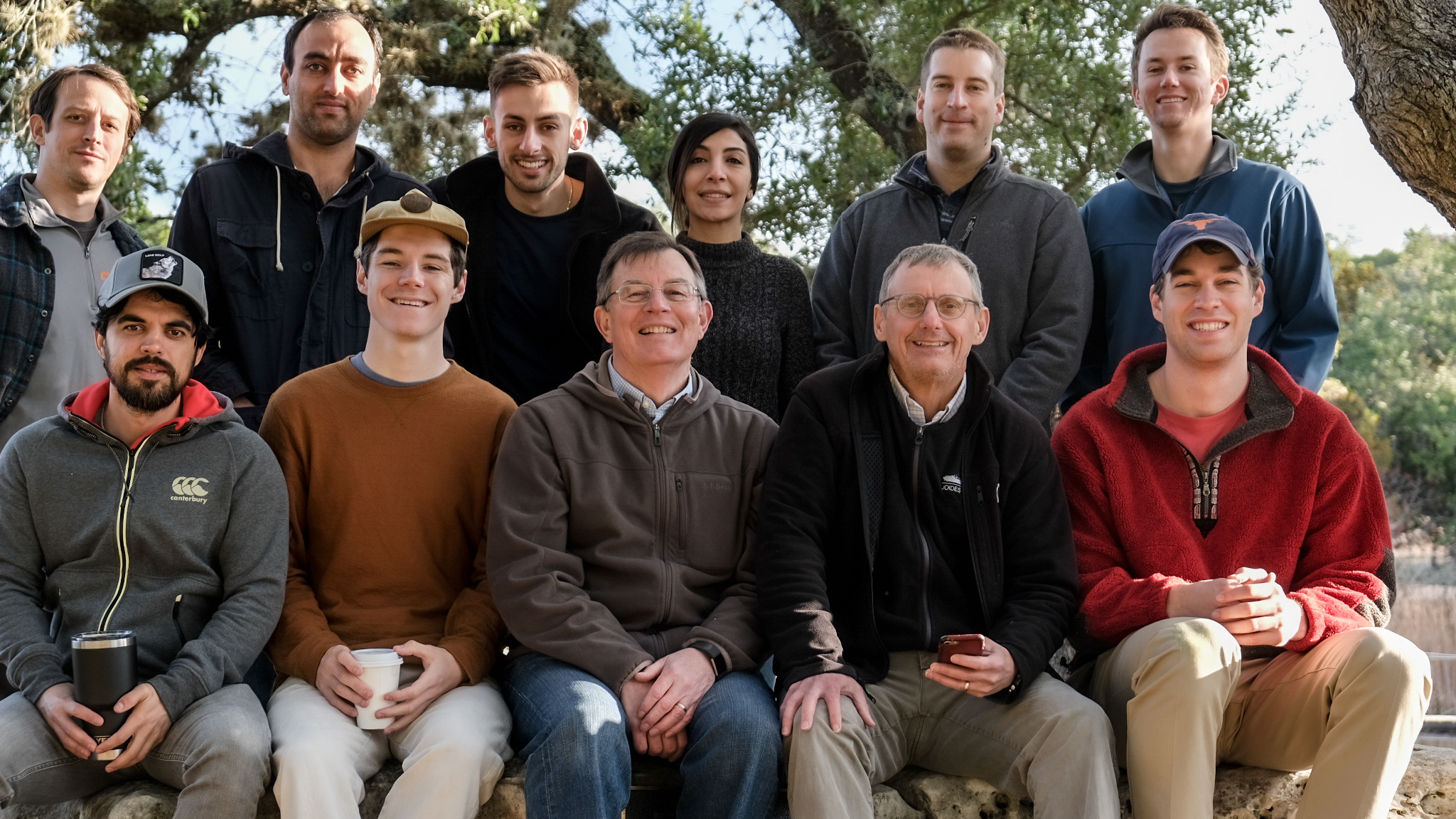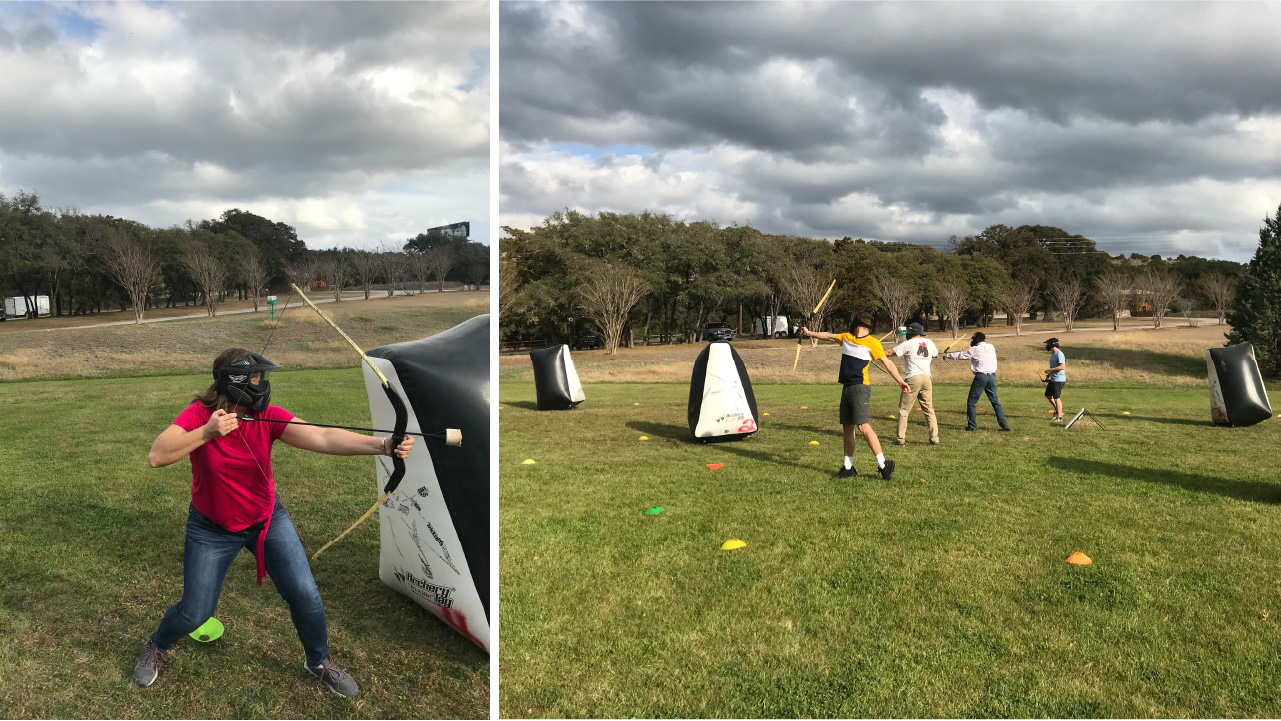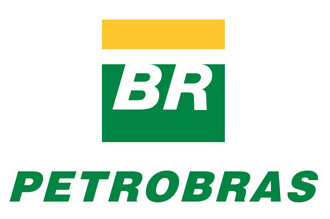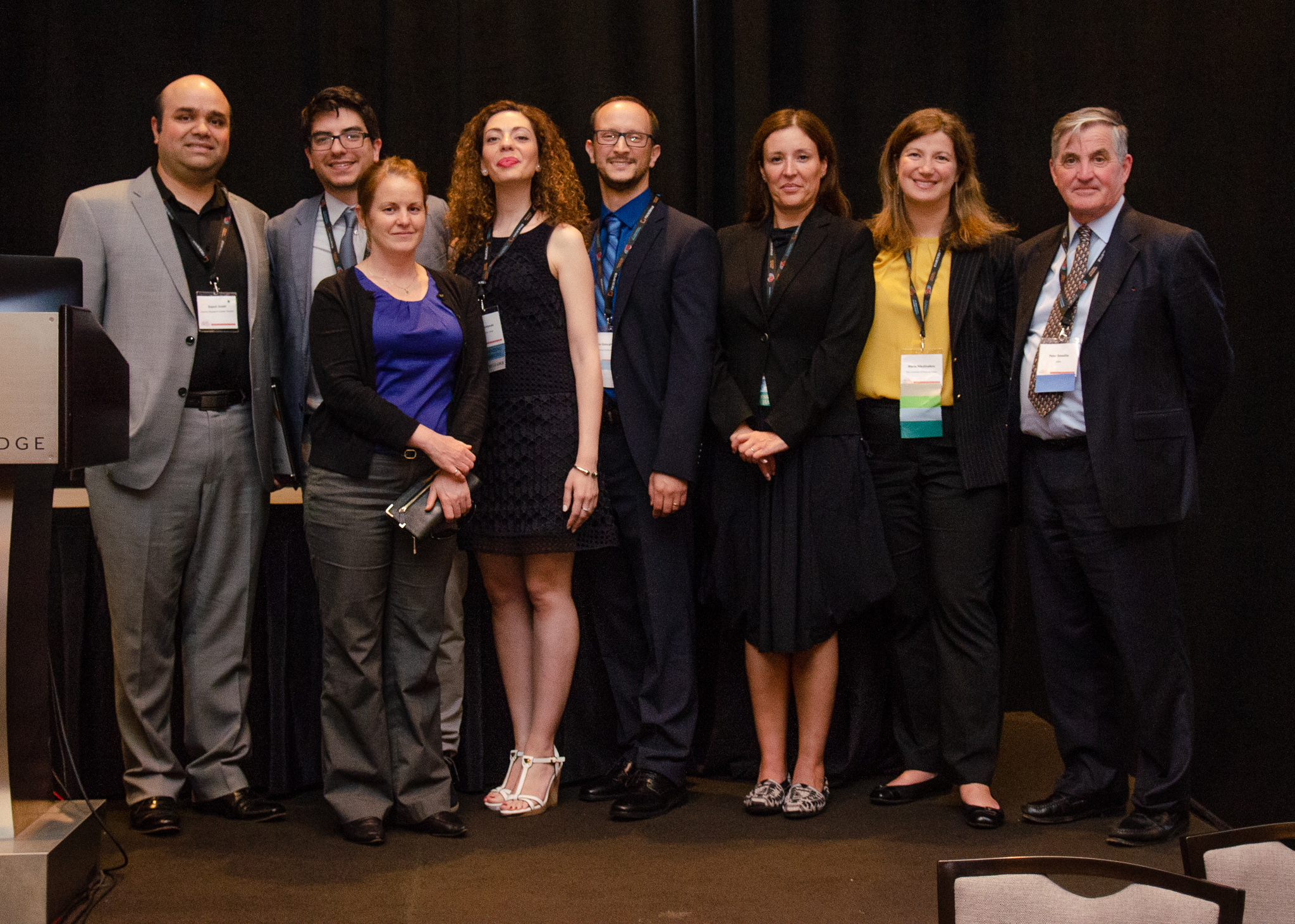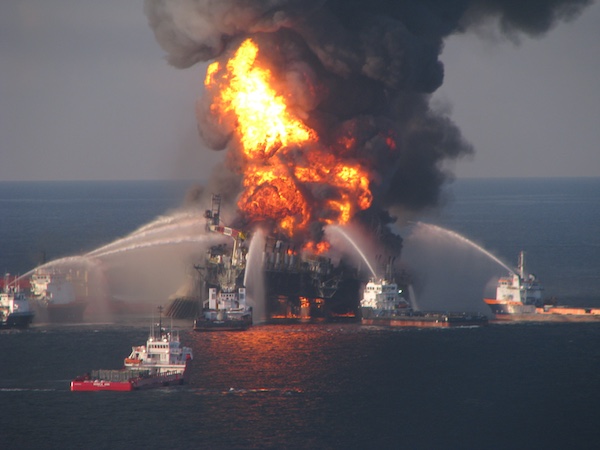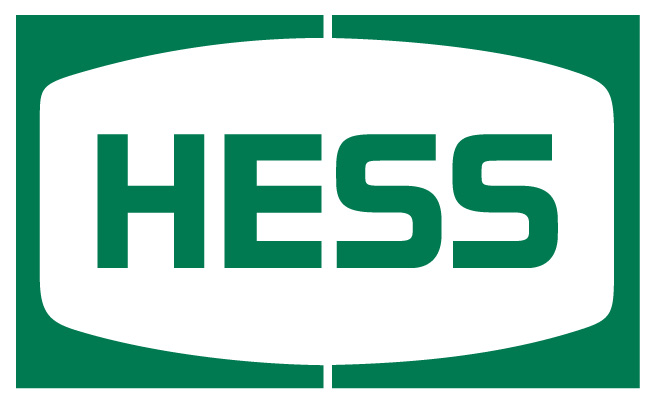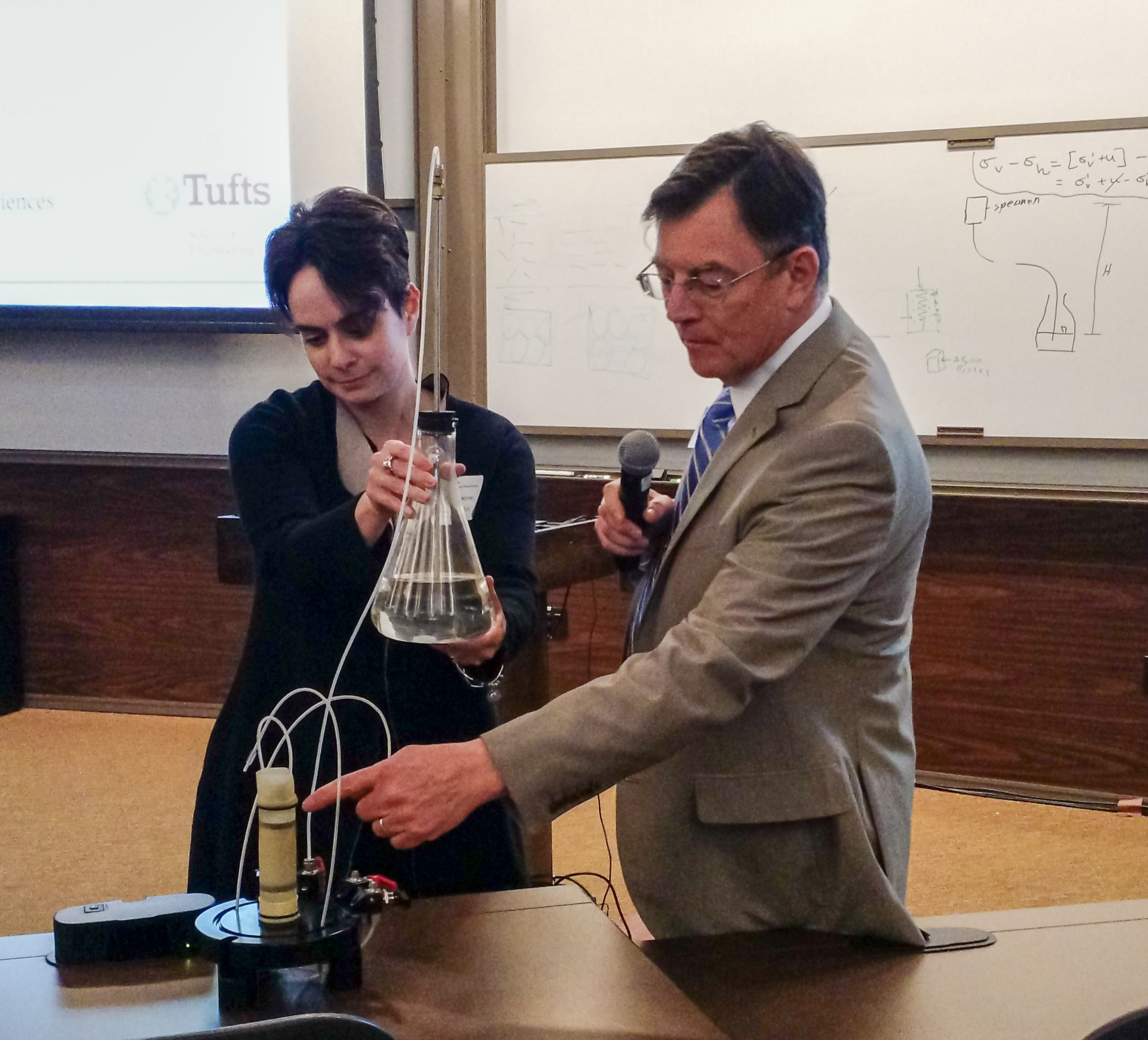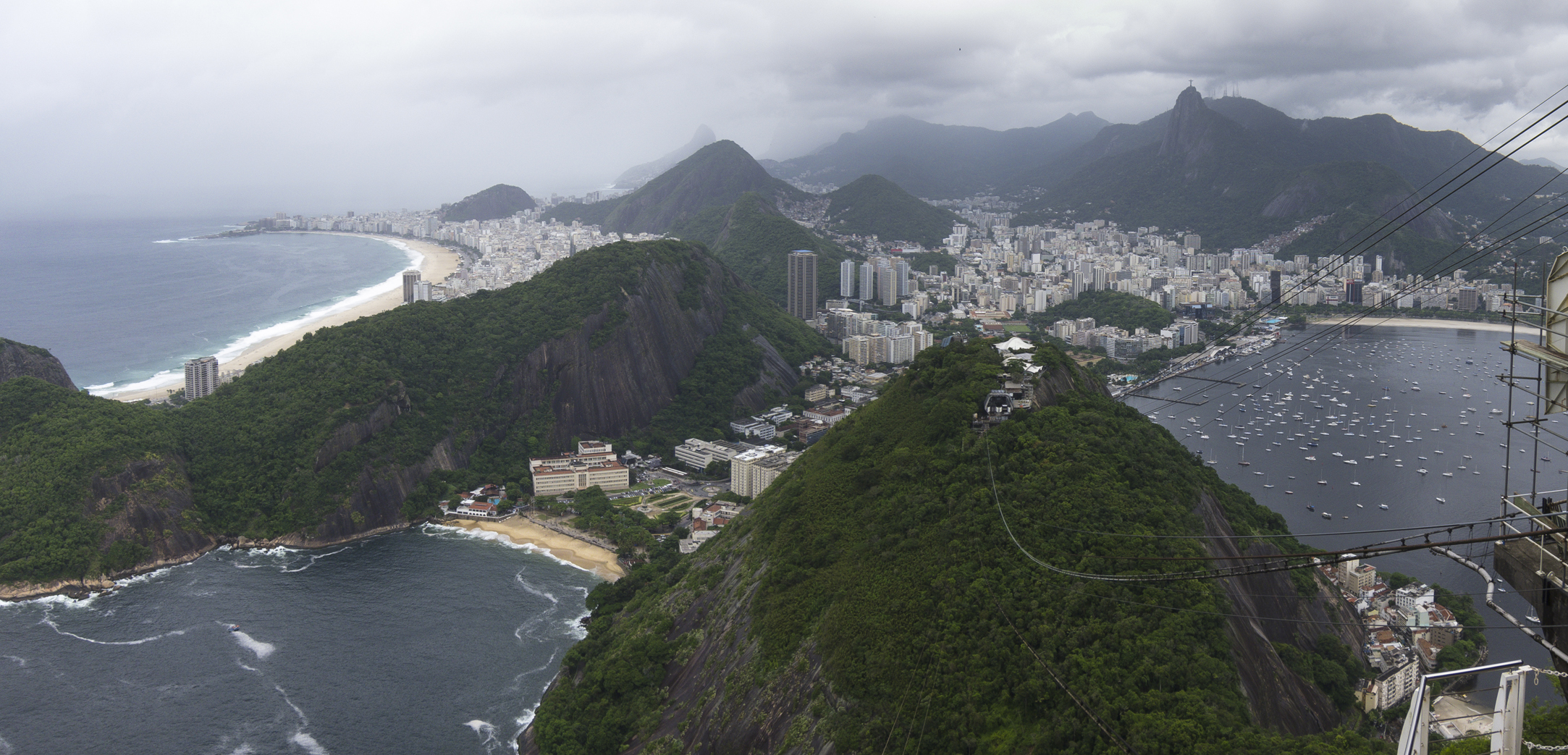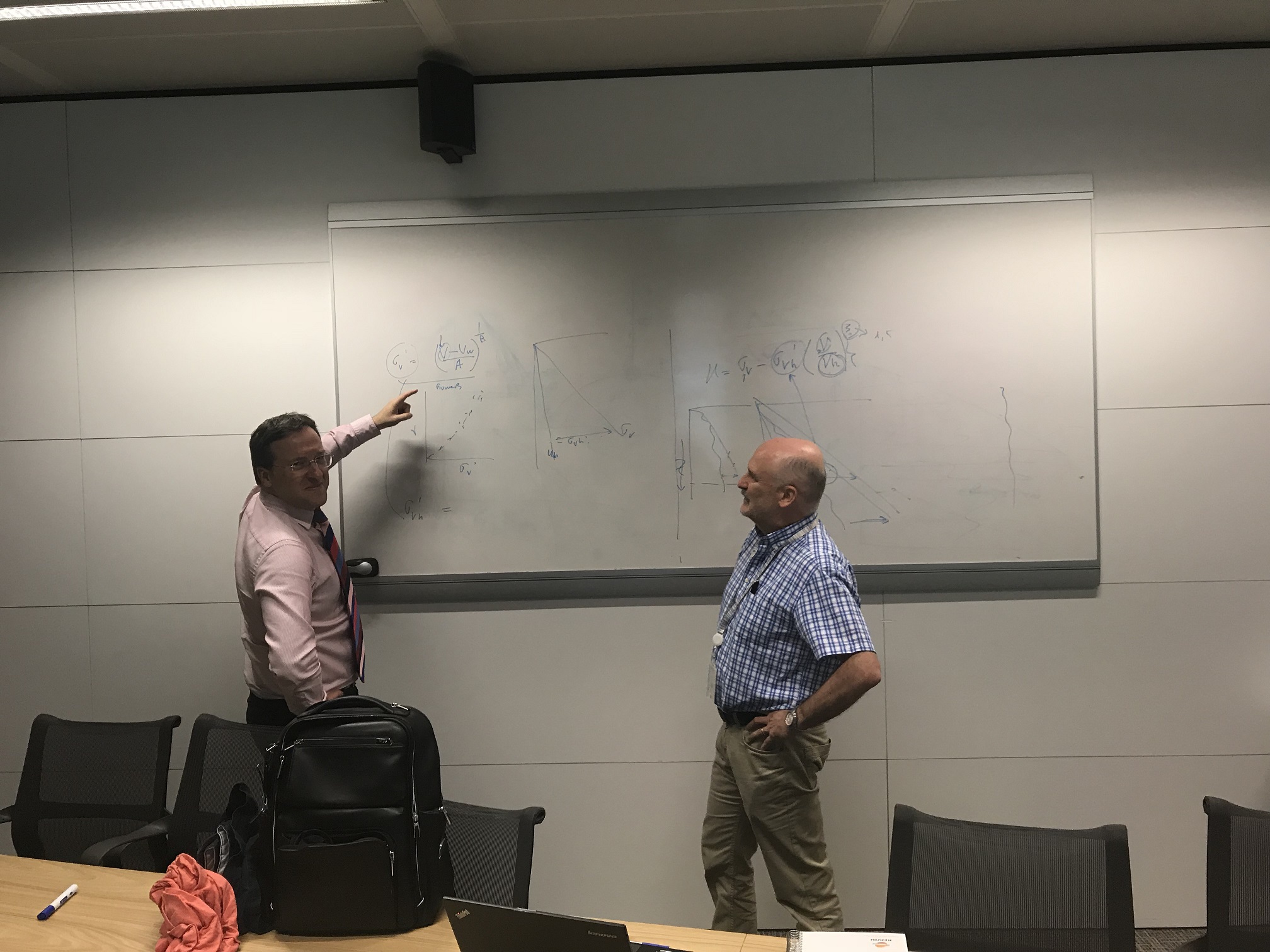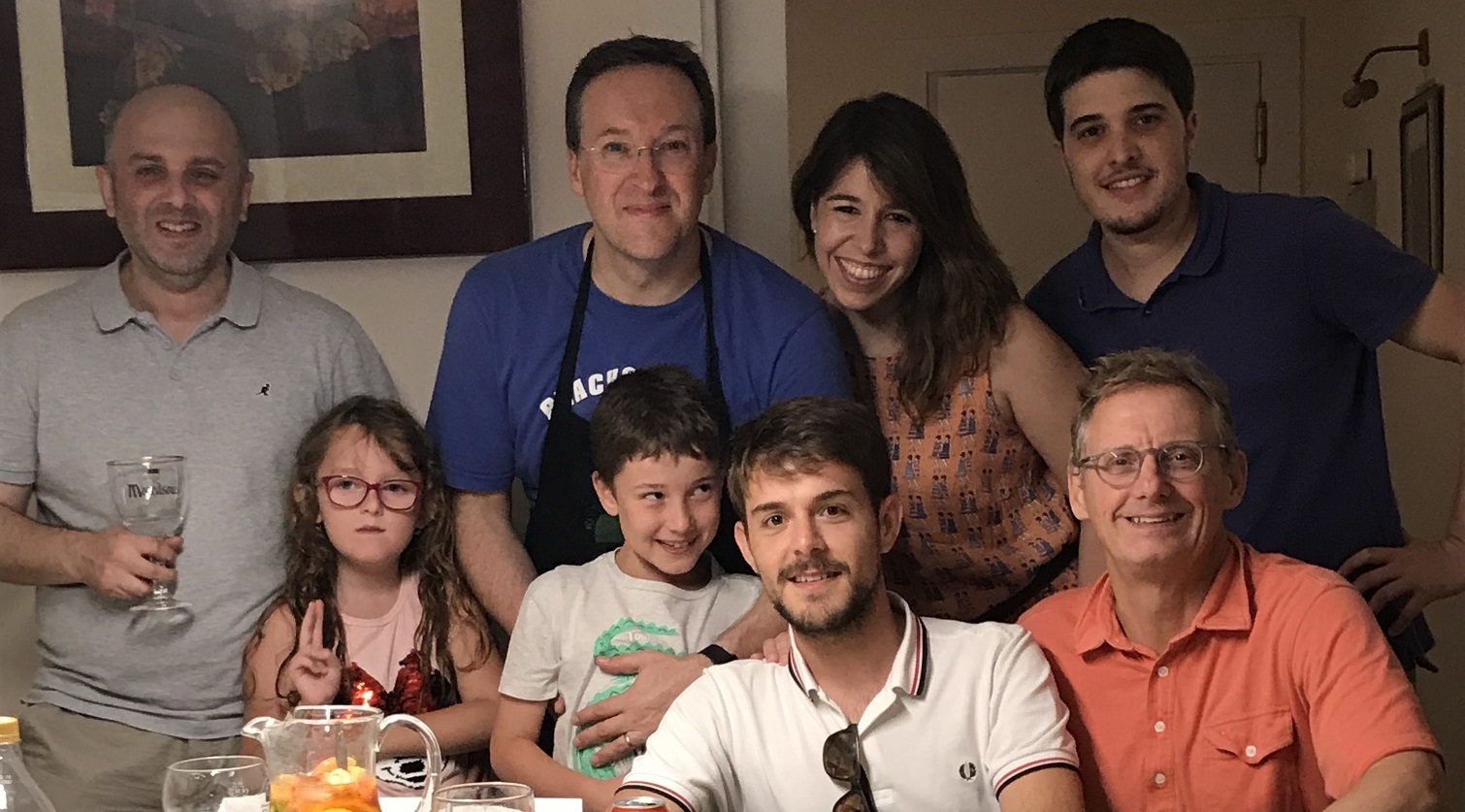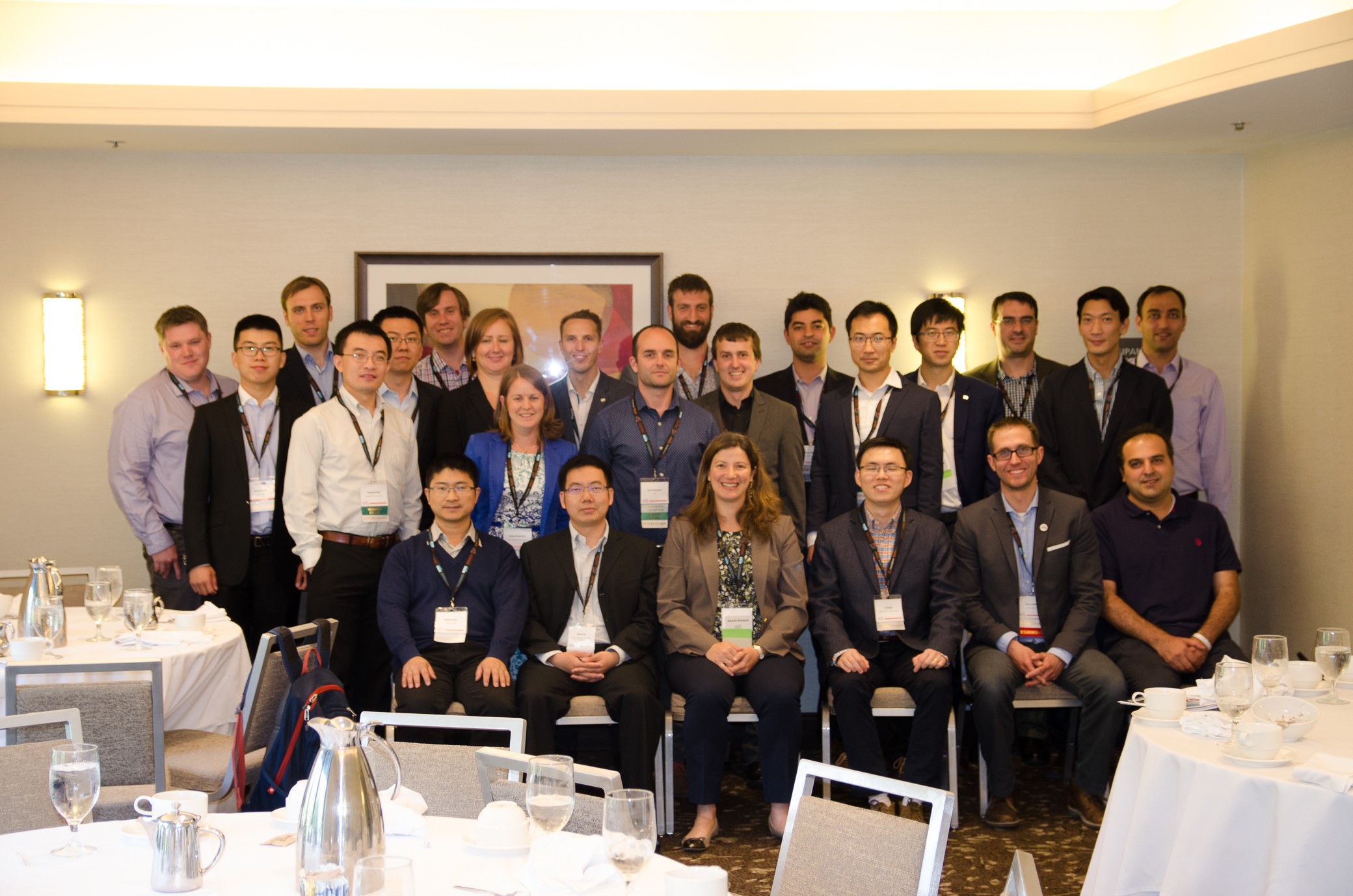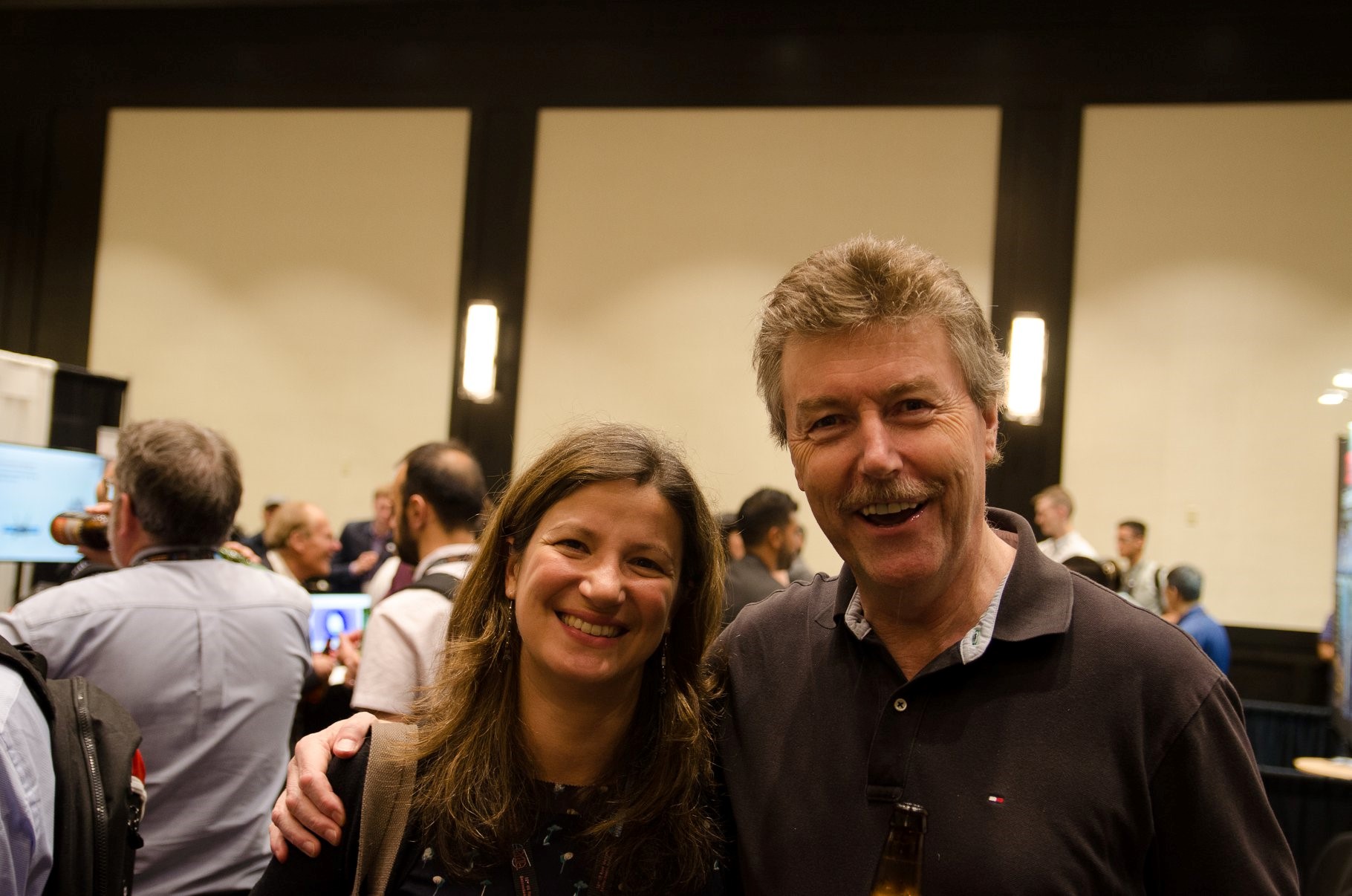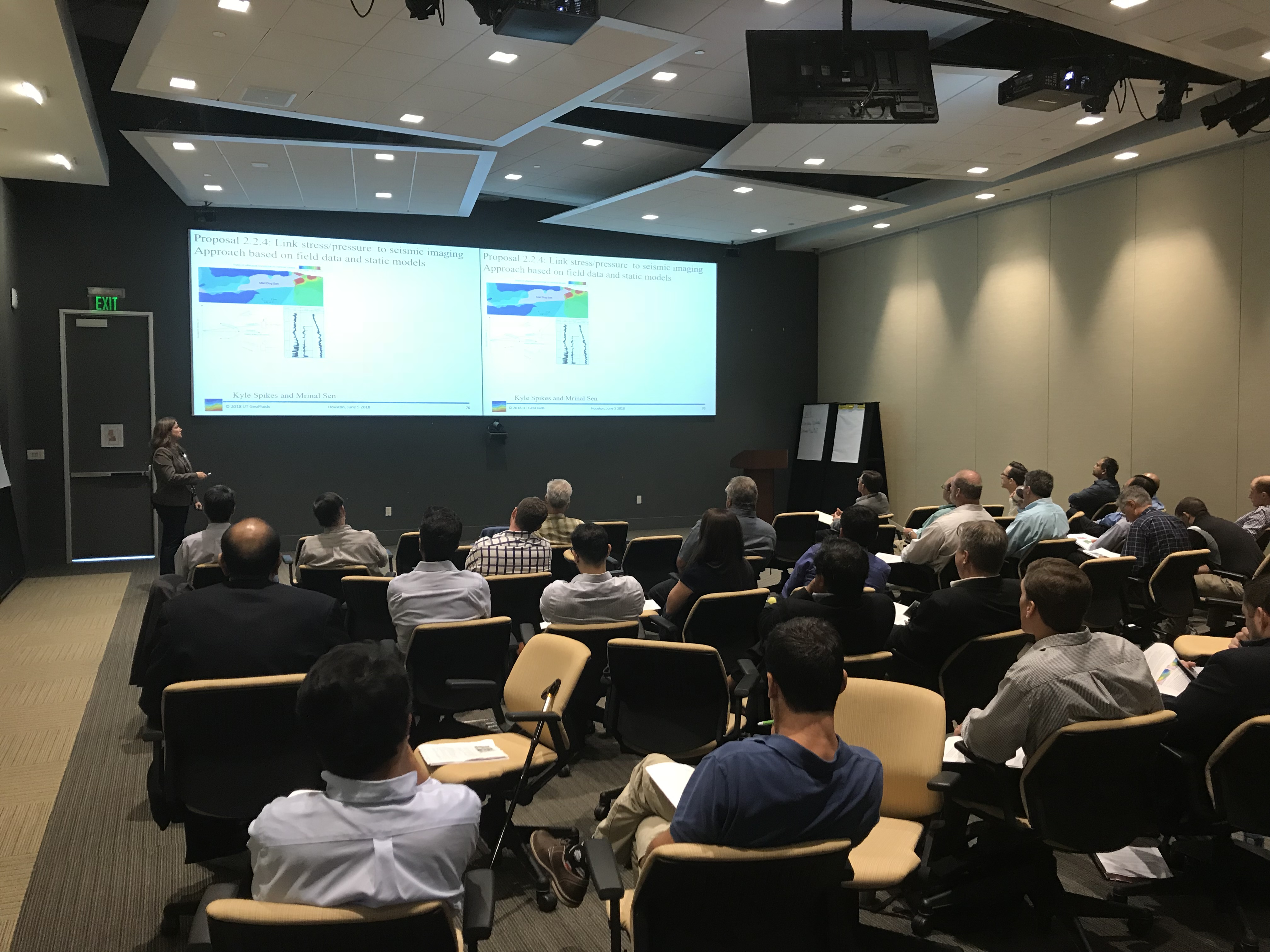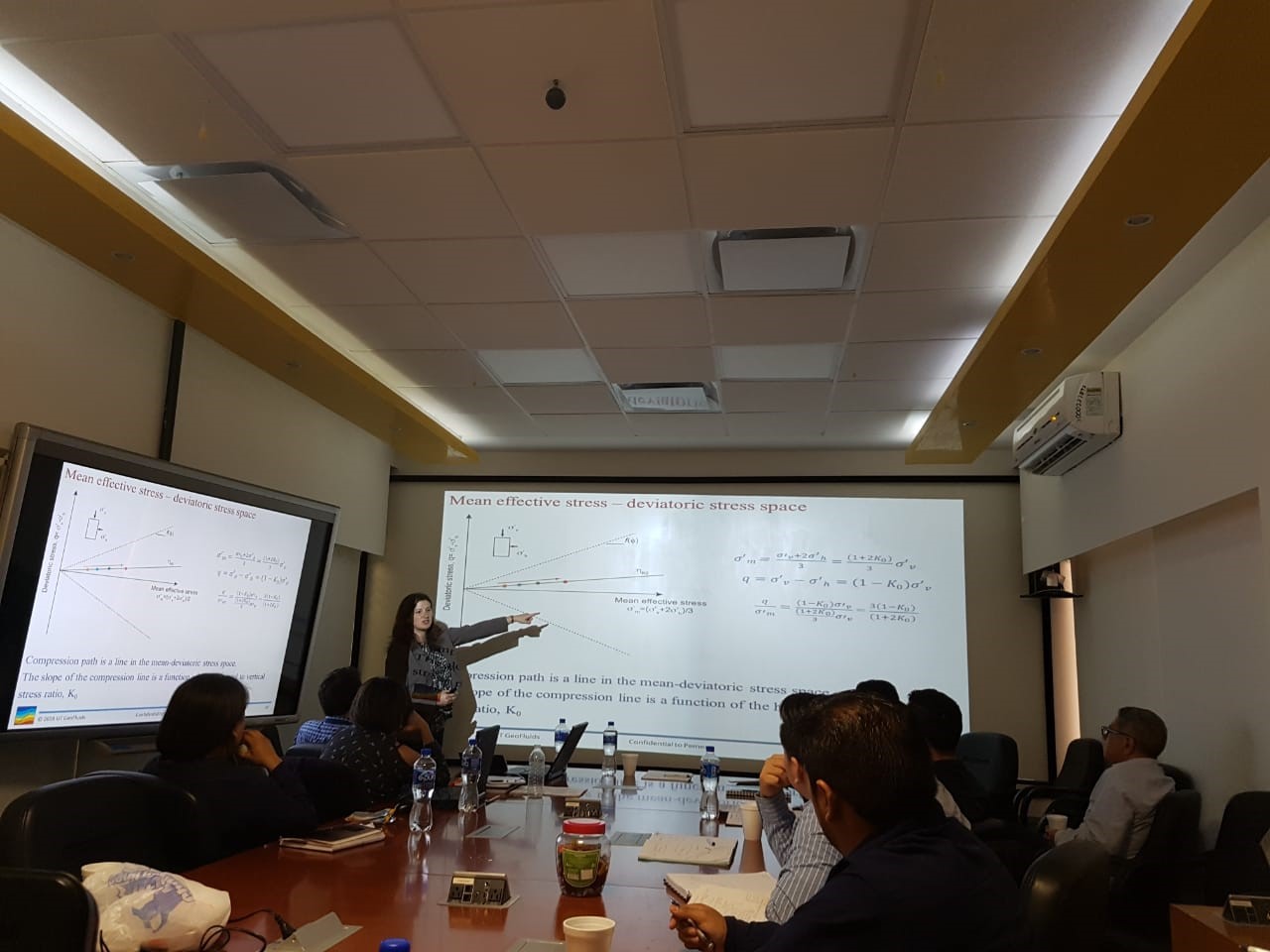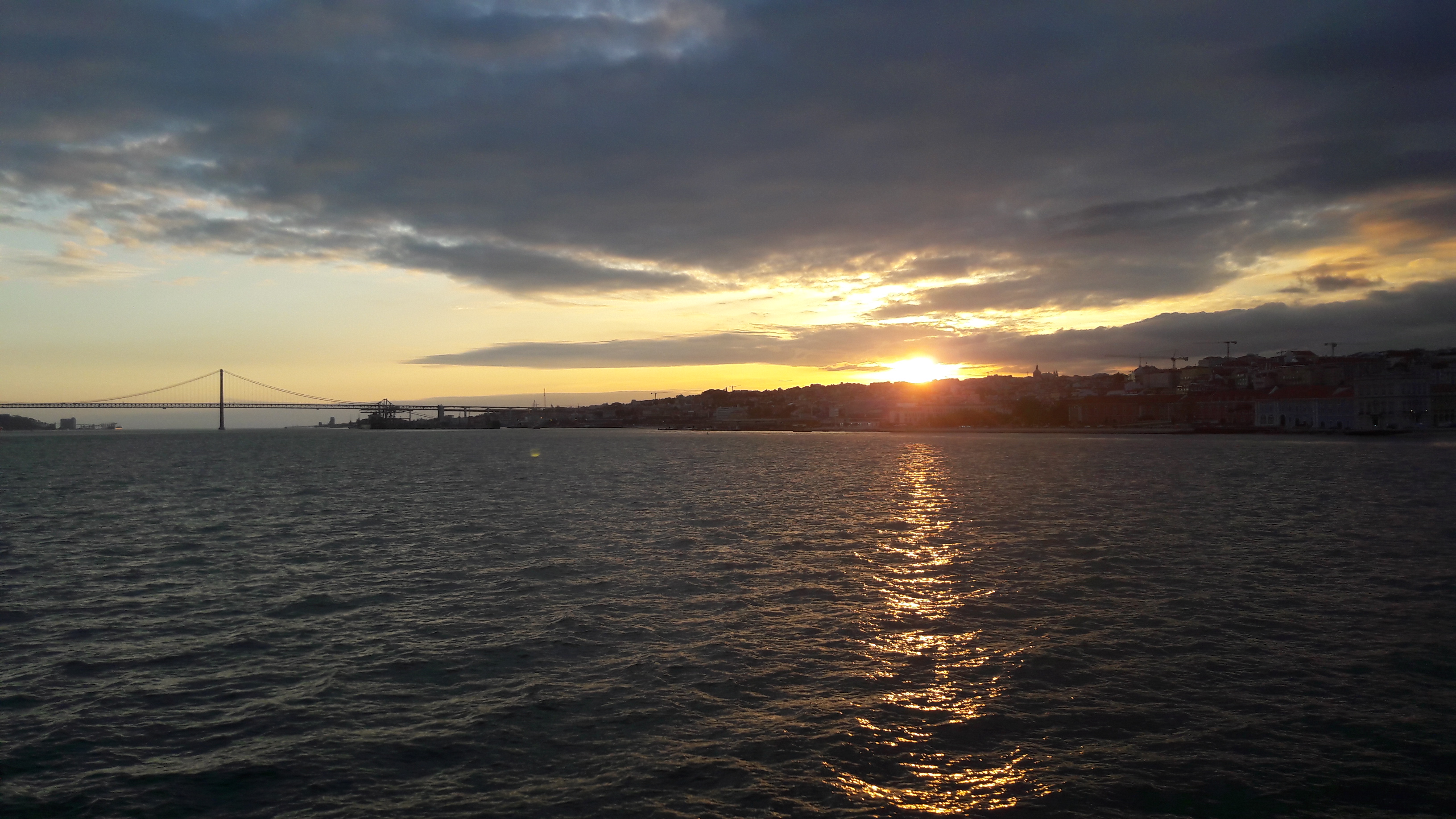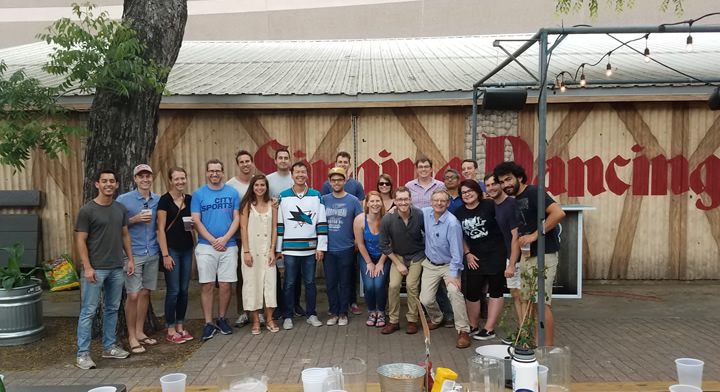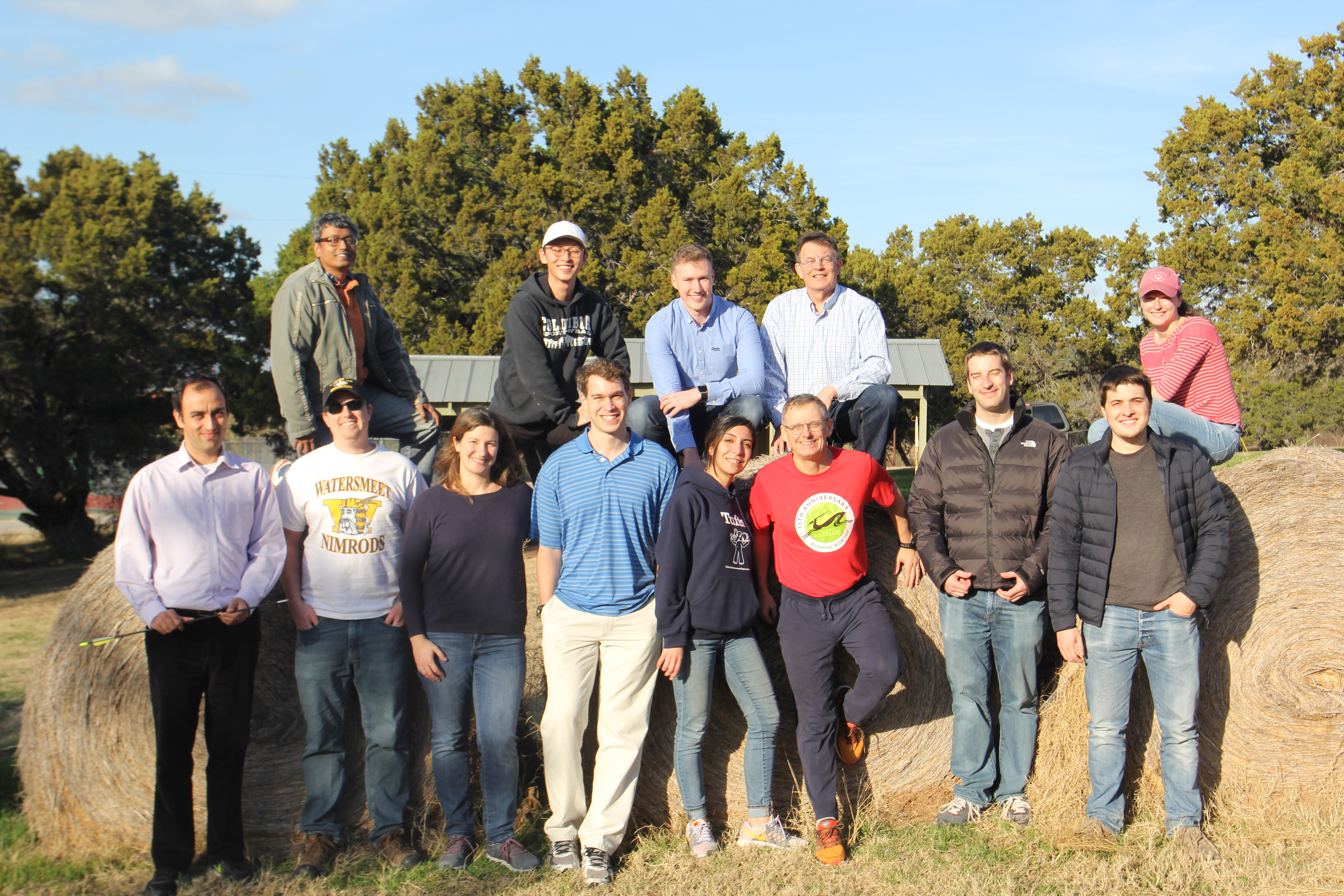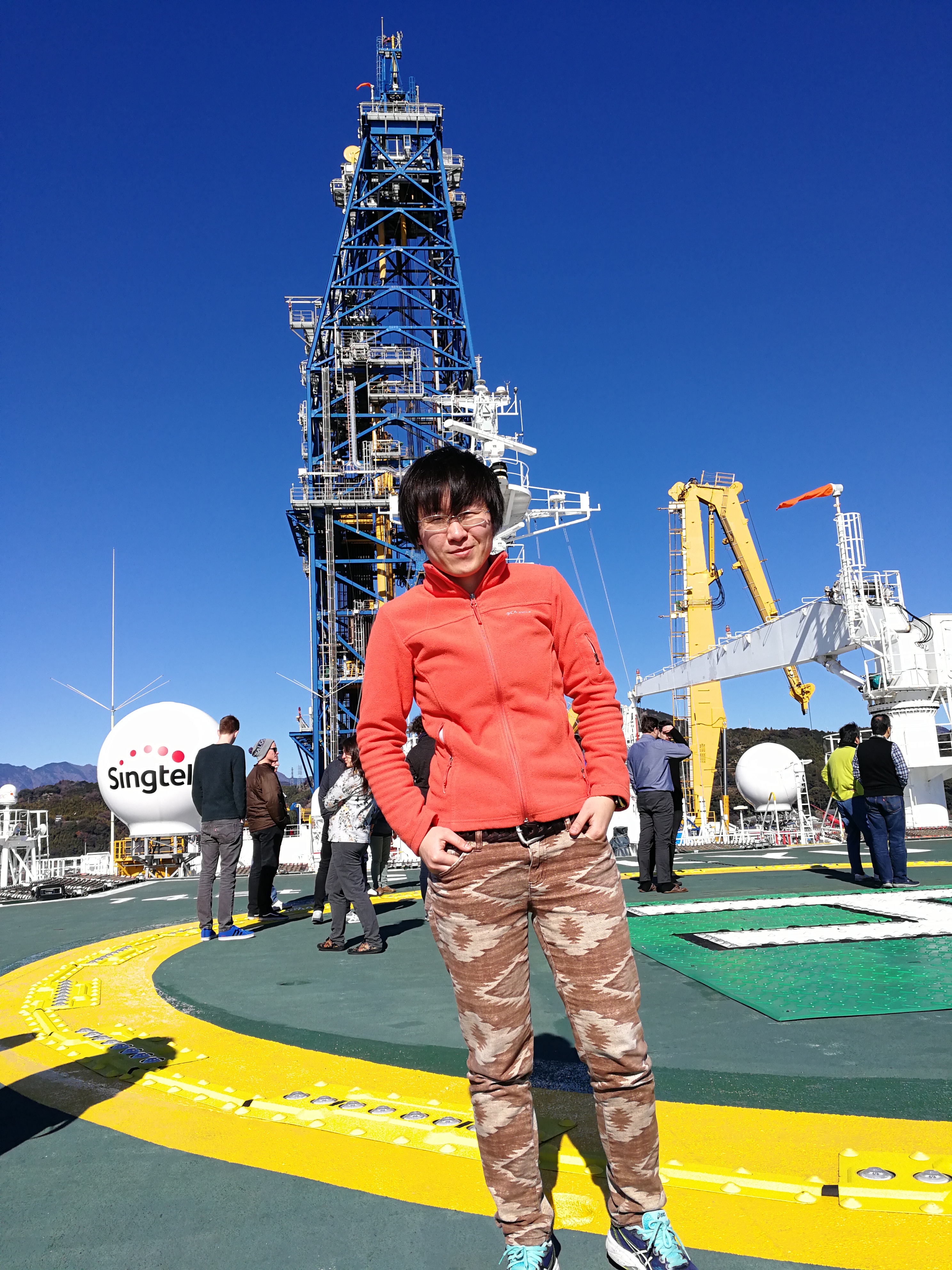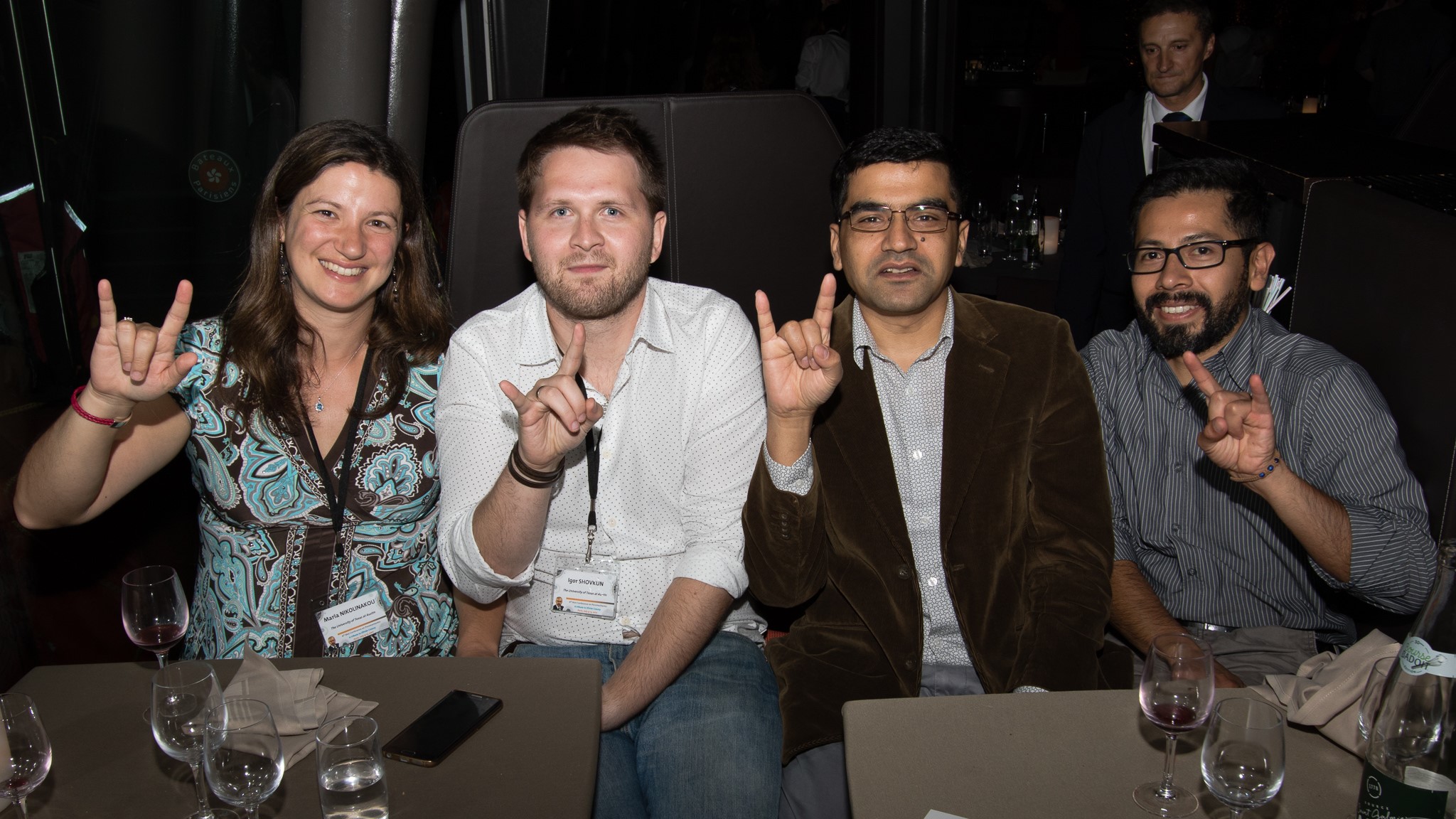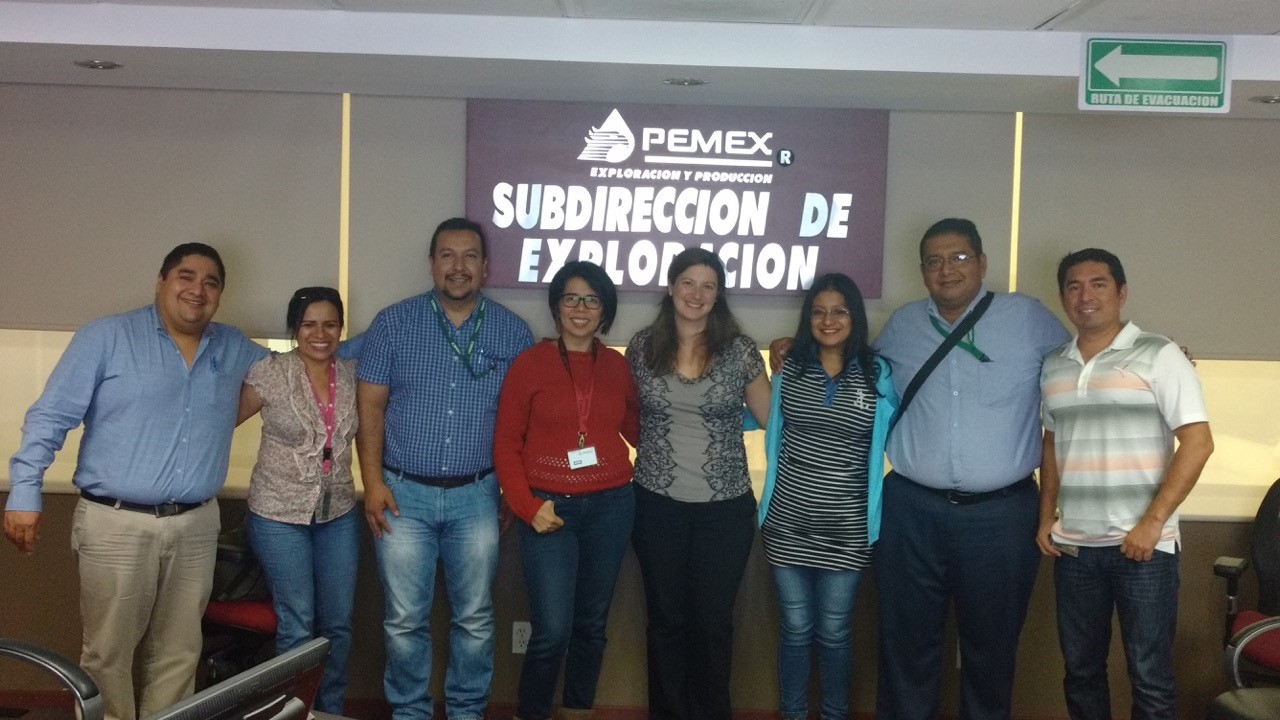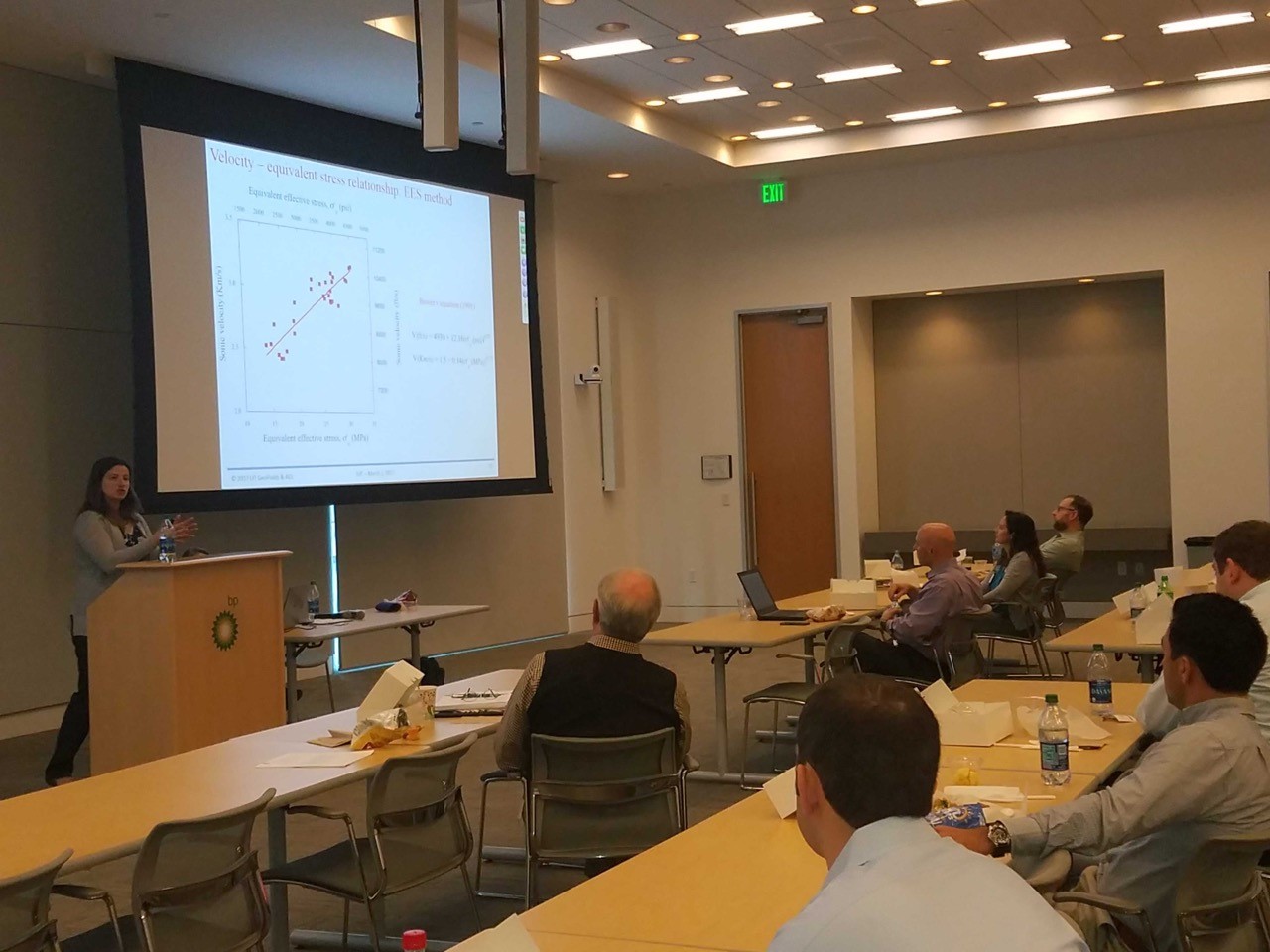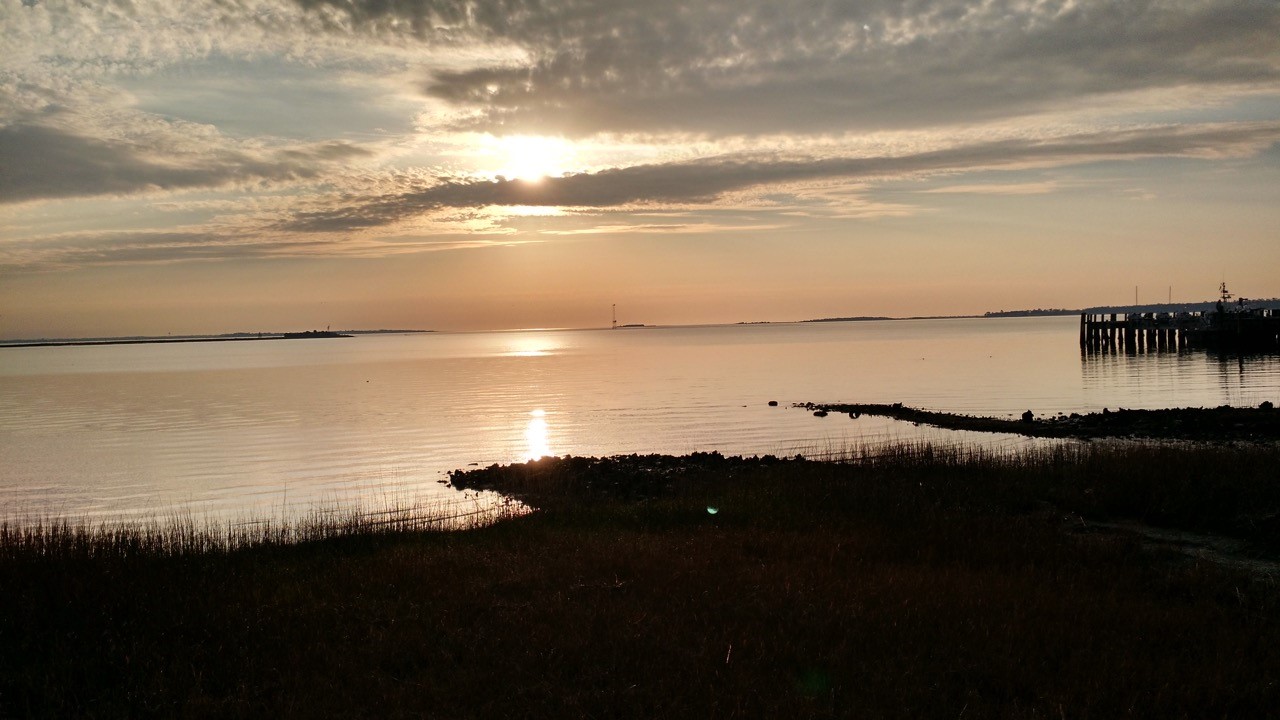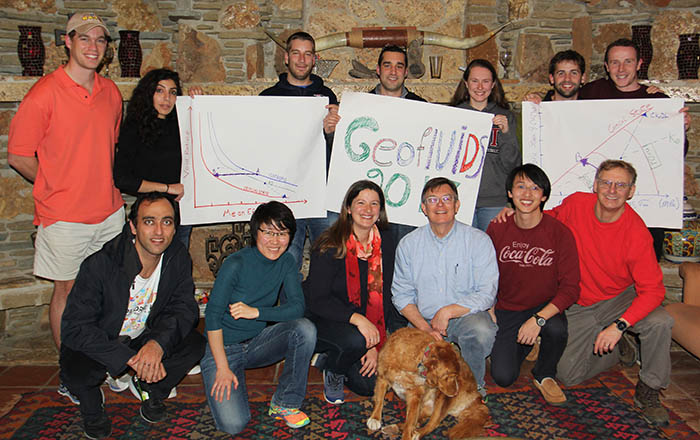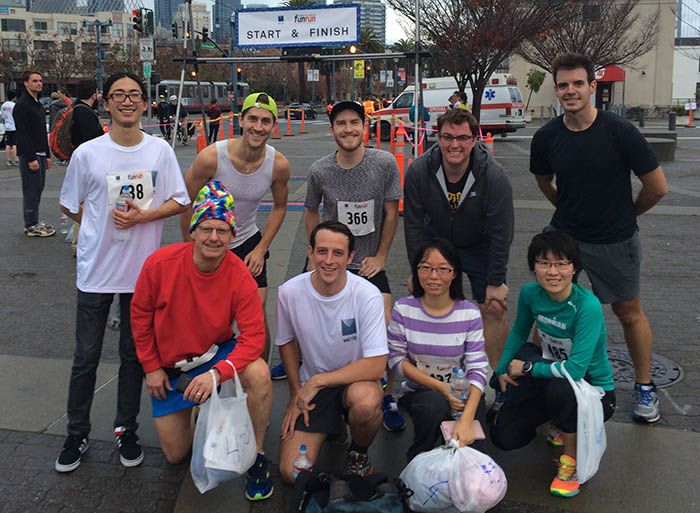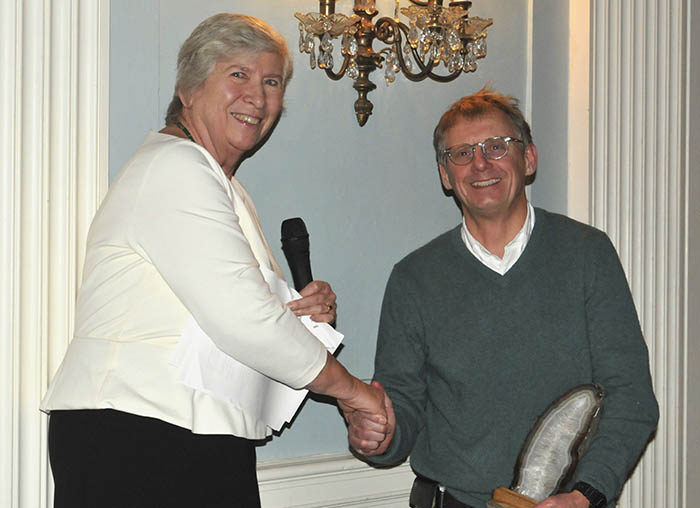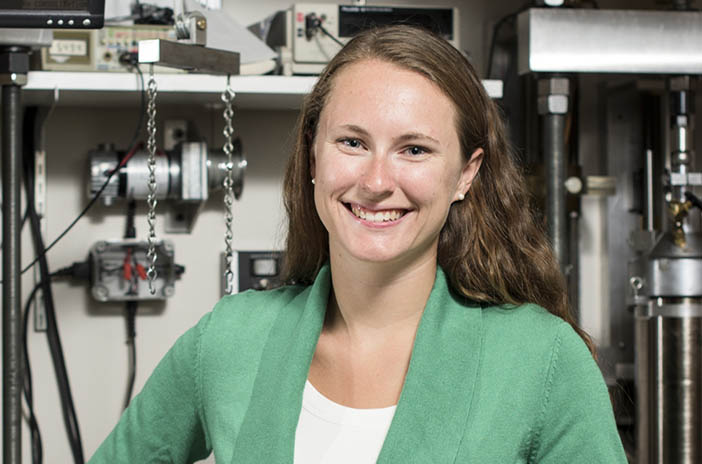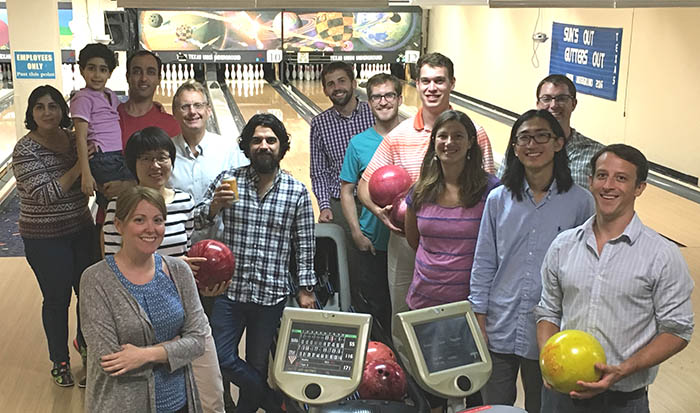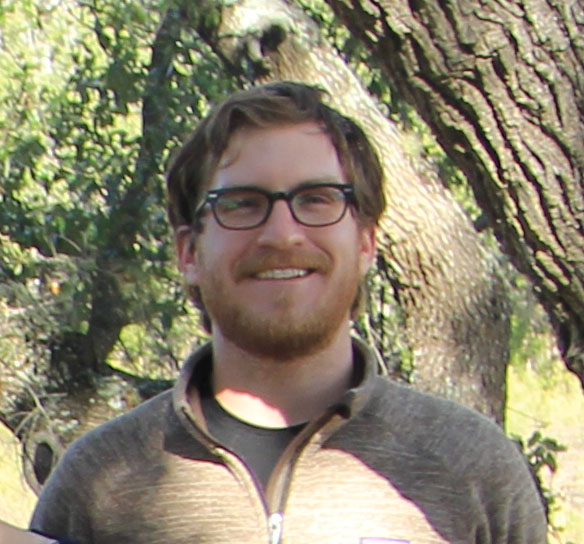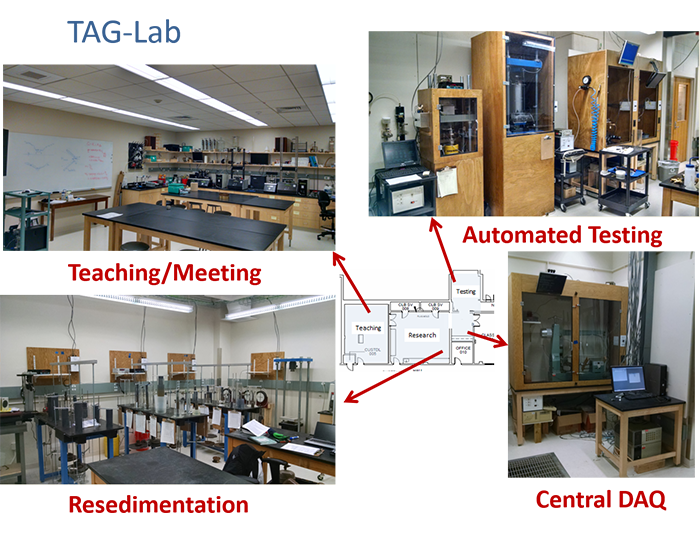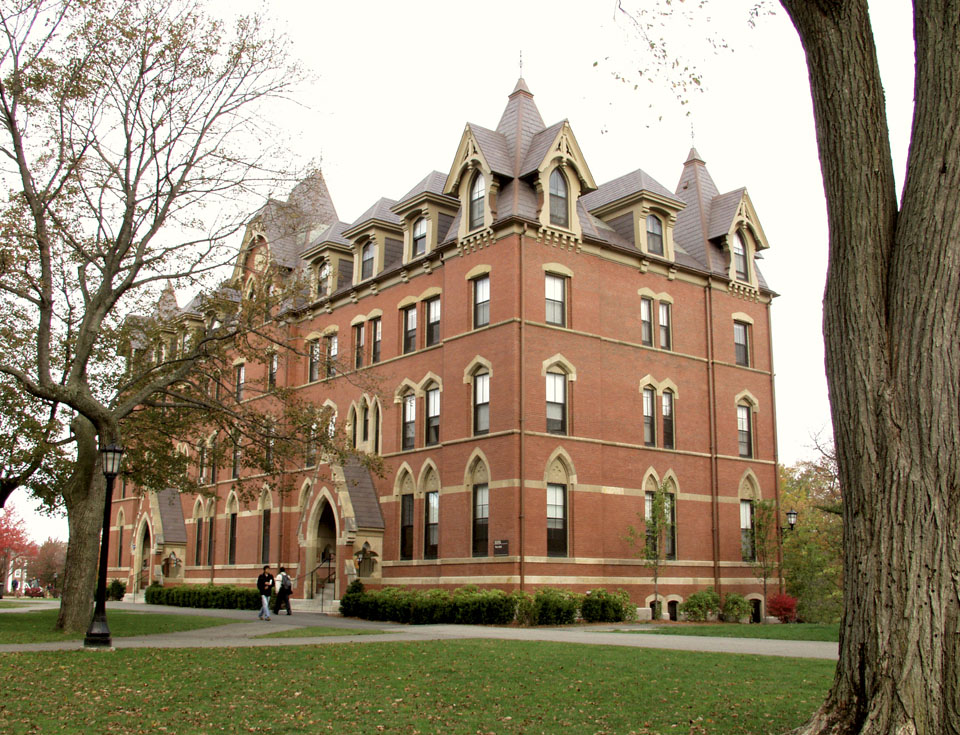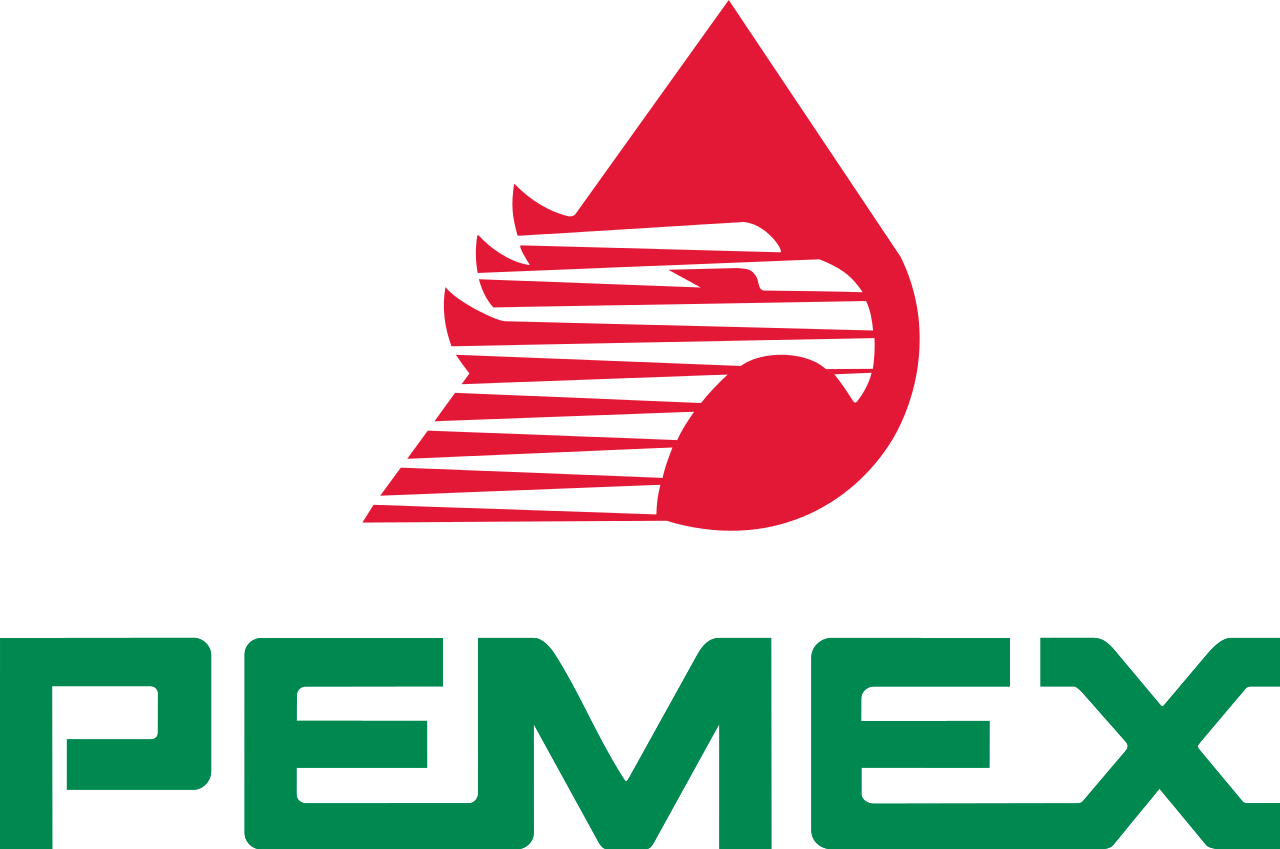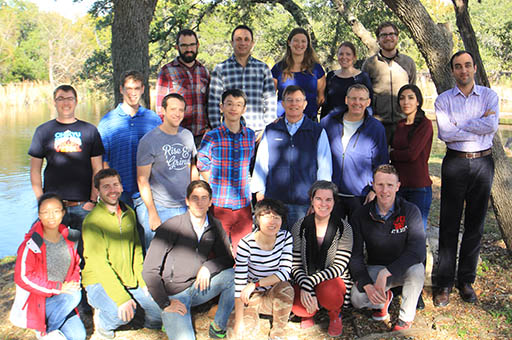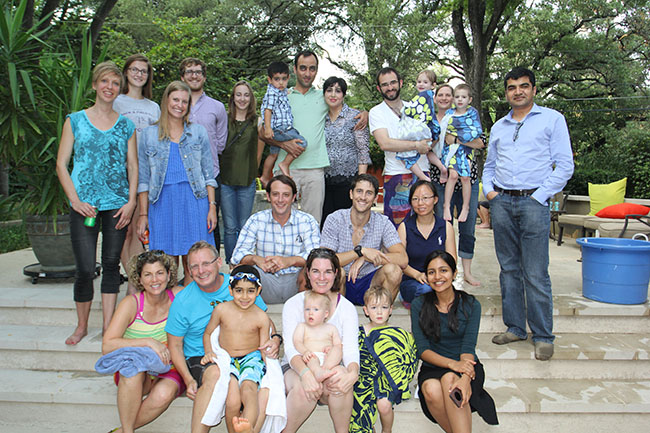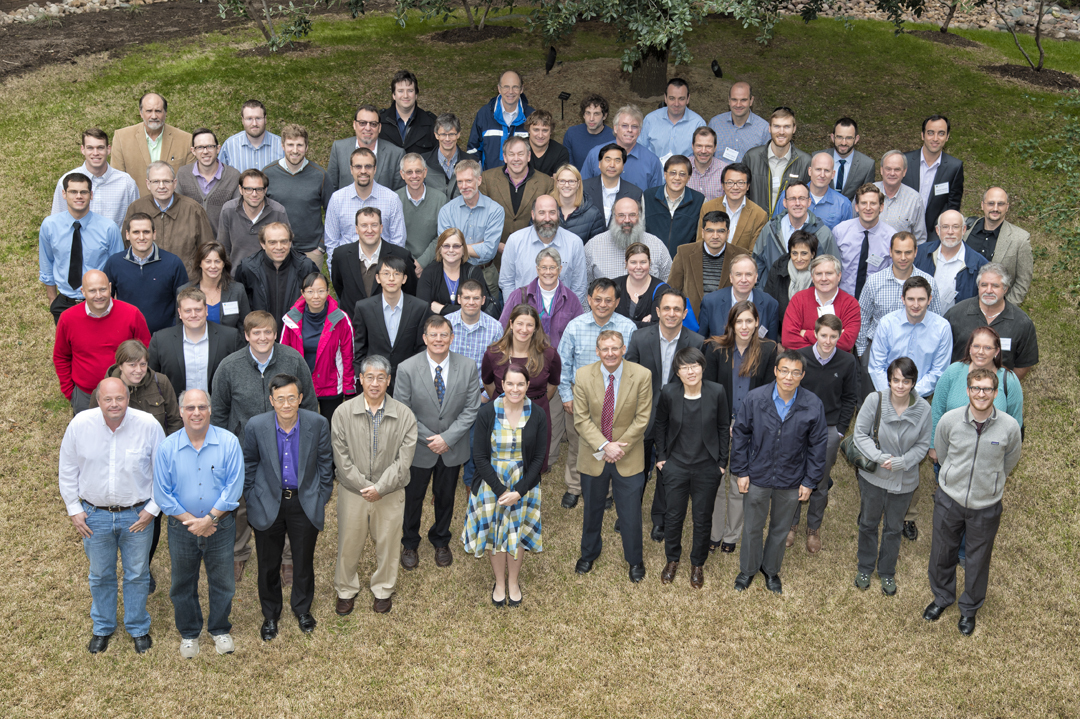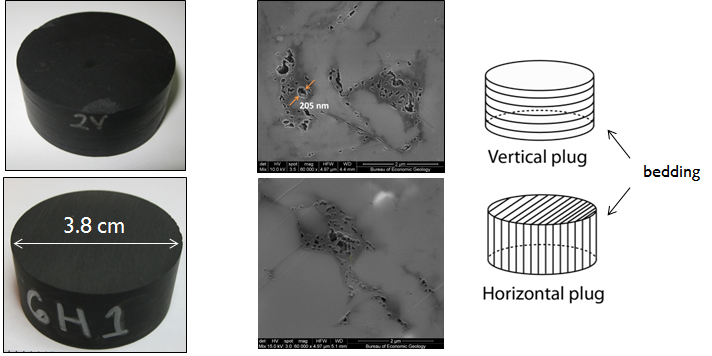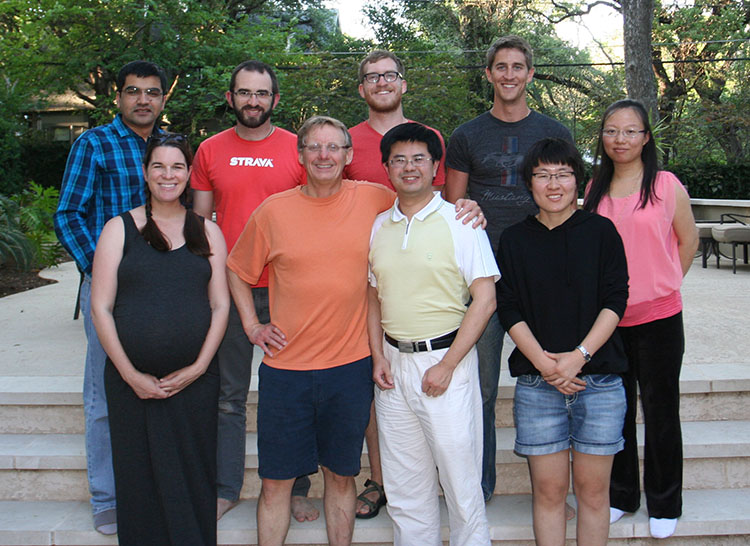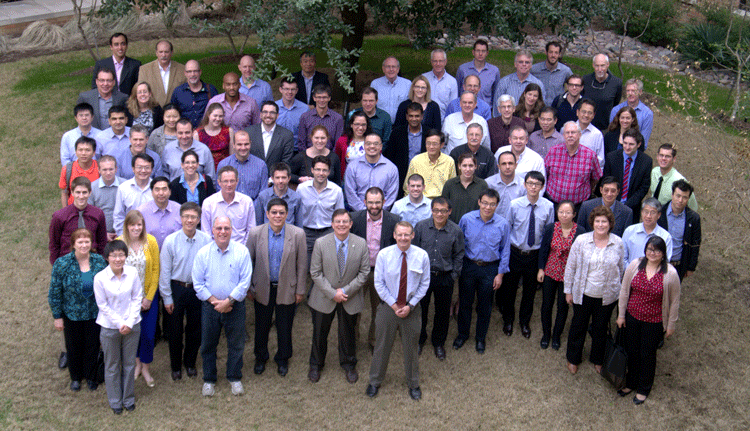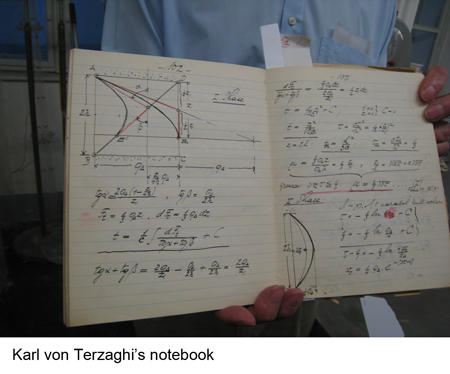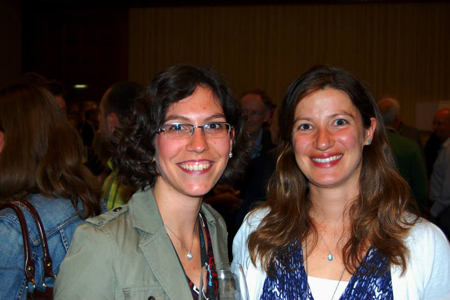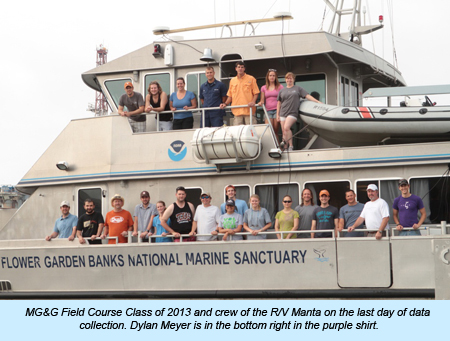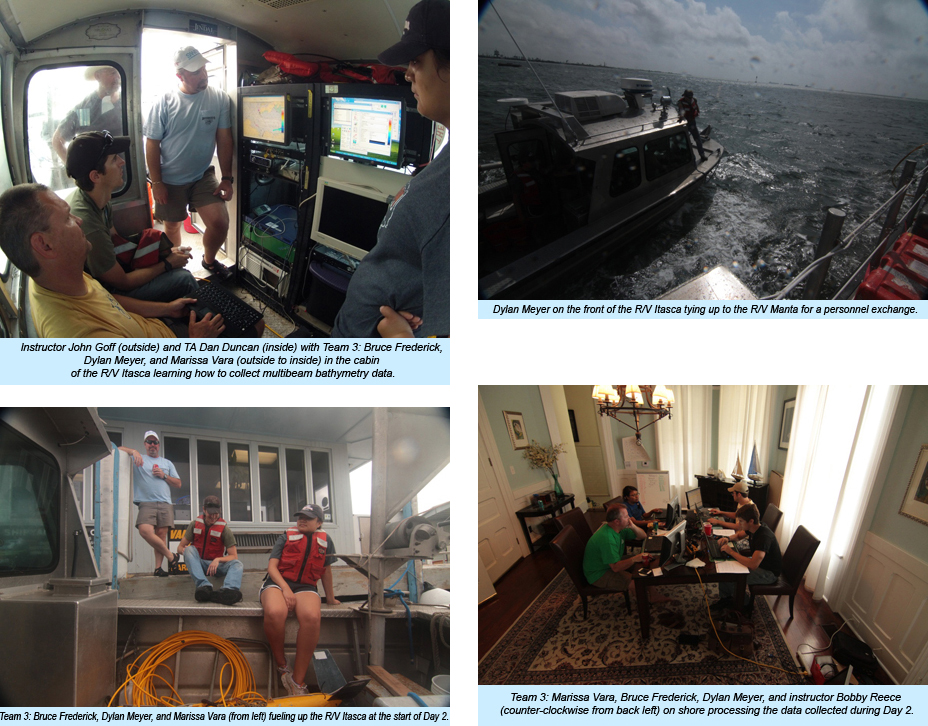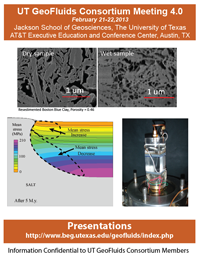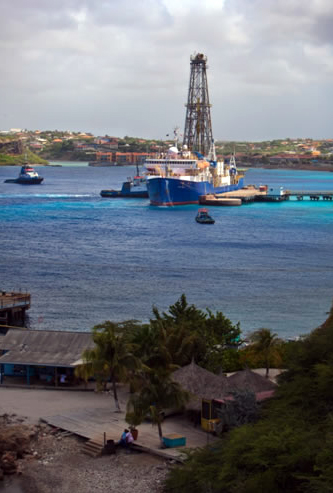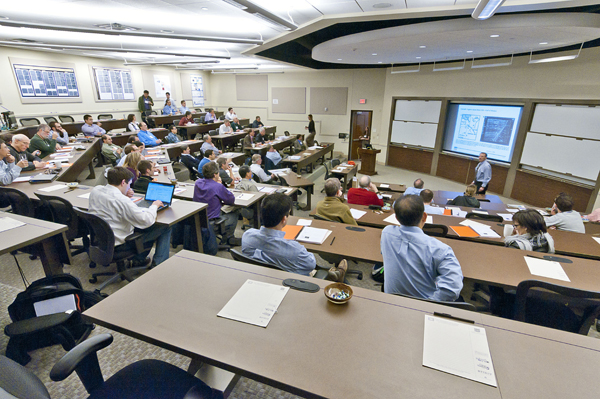UT GeoFluids News
- 2024-2025
- 2023
- 2022
- 2021
- 2020
- 2019
- 2018
- 2017
- 2016
- 2015
- 2014
- 2013
- 2012
- 2011
- 2010
- 2009
Click to enlarge.
March 7, 2025
16th UT GeoFluids Annual Meeting
Thank you to everyone who helped make our 16th UT GeoFluids Annual Meeting a success! We had a great turnout, with exciting presentations and invigorating discussion about all things geofluids. In particular, there were many insights to gain about the Biot coefficient, unloading, rock rheology, and machine learning!
Members can find talk recordings, slides and more at the UT GeoFluids members website.
The 16th UT GeoFluids Annual Meeting took place March 5, 2025 – March 7, 2025 in Austin, Texas and featured a reception and poster session, industry talks, hands-on workshop, and a group dinner. Learn more about the meeting at UT GeoFluids Annual Meetings.
Some of the 2024 summer interns (left-to-right: Sean Flournoy, Emory Russell , Daniel Woodell, Nate Stearley, Graciela Lopez Campos, Aly Sebold, and Amrita Ginne). Credit: ITASCA Minneapolis
September 17, 2024
UT GeoFluids Among Summer Interns at ITASCA Minneapolis
UT GeoFluids graduate student, Graciela Lopez Campos, was one of 9 interns at ITASCA Minneapolis this summer. At ITASCA, Lopez Campos used FLAC3D, Griddle and Rhino for slope stability and geotechnical centrifuge modeling and performed fault mesh generation for 200+ faults to be implemented in the stability analysis of an open pit mine.
ITASCA featured Lopez Campos in a brief news article about the internship.
Maria Nikolinakou. Credit: University of Texas Institute for Geophysics
September 17, 2024
Nikolinakou Becomes President of ARMA Foundation
Maria Nikolinakou has been named President of the ARMA Foundation, a non-profit sister organization to the American Rock Mechanics Association. The ARMA Foundation raises funds and adminsters funded programs that support its mission.
Learn more about the ARMA Foundation.
Landon Lockhart in action presenting a poster at UT GeoFluids Annual Meeting 2023. Credit: University of Texas Institute for Geophysics
September 17, 2024
Landon Lockhart Graduates!
Congratulations Landon Lockhart, a UT Jackson School of Geosciences graduate student, on graduating and defending his doctoral thesis! Lockhart's PhD thesis title: A Mechanistic Approach for Predicting pore pressure in the Delaware Basin was well received.
Lockhart has done elegant work exploring the thermal and mechanical impacts of unloading and incorporating this into a pressure prediction model. He has started an intership with Oxy
Emre Uyeturk at UT GeoFluids Annual Meeting 2023. Credit: University of Texas Institute for Geophysics
September 17, 2024
Emre Uyeturk Graduates!
Congratulations Tufts University graduate student, Emre Uyeturk! Uyeturk's PhD thesis was: 'Laboratory investigation and modeling of secondary compression behavior of clays.'
Uyeturk has taken a job with Keller Group, the world's largest geotechnical specialist contractor.
George McAneny presenting a poster at UT GeoFluids Annual Meeting 2022. Credit: University of Texas Institute for Geophysics
September 17, 2024
George McAneny Joins GEI Consultants
Tufts University graduate student, George McAneny has joined geotechnical consulting company GEI Consultants.
Peter Flemings receives the Robert R. Berg Outstanding Research Award at IMAGE '24. Photo: Peter Flemings.
August 28, 2024
Robert R. Berg Award: Flemings Honored by AAPG!
Peter Flemings was awarded the 2024 Robert R. Berg Outstanding Research Award at IMAGE ‘24.
The Berg Award is a top honor bestowed by the American Association of Petroleum Geologists. A news story published by UTIG in March 2024, explains the award's significance and why Flemings was selected.
August 20, 2024
Save the Date! 16th UT GeoFluids Annual Meeting
Our 16th Annual Meeting will take place March 5 – 7, 2025 in Austin, Texas. We look forward to welcoming our members for an in-person program featuring a reception and poster session, industry talks, hands-on workshop, and a group dinner. More details will be posted here soon.
See past meeting programs here: UT GeoFluids Meetings.
Graciela Lopez Campos (left) and Maria Nikolinakou at UTIG's 2024 Joint International Earthquake Symposium. Credit: University of Texas Institute for Geophysics
June 26, 2024
UT GeoFluids at ARMA's Golden 24 Symposium
Maria Nikolinakou and UT GeoFluids graduate student, Graciela Lopez Campos attended the 58th US Rock Mechanics/Geomechanics Symposium held in Golden, Colorado, USA, 23-26 June 2024. Both presented papers at the events
Nikolinakou presented Pressure and stress prediction using seismic velocities, 3D geomechanical models and the full stress tensor: Mad Dog field, deepwater GoM. Lopez Campos presented Stress Distribution in Accreting Sediments: A Geomechanical Study of Upper-Plate Faults.
May 14, 2024
Houston Visit
Peter, Maria, and Jack spent 2 days in Houston (14-15 May 2024) visiting with current and potential member companies.
Modern topography in western Texas. Credit: AAPG/Sebastian Ramiro-Ramirez
March 8, 2024
UT GeoFluids Research Published on Wolfcamp Permeability
Sebastian Ramiro-Ramirez’s study of permeability heterogeneity in the Wolfcamp and its impact on production has been published in the journal AAPG Bulletin.
UT Austin graduate student, Tolulope Agbaje, presenting his research at the 2024 UT GeoFluids annual meeting.
March 1, 2024
15th UT GeoFluids Annual Meeting
Our 2024 UT GeoFluids meeting was a great success! Nearly 50 people attended from 10 companies. Three wonderful industry talks complemented the research presented by students and members of the UT GeoFluids group. We'll soon be uploading talk recordings, slides and abstracts for UT GeoFluids members. Visit our member pages for more details.
Browse photos from the meeting at our Flickr Album.
Visit the event website: UT GeoFluids Annual Meeting.
The UT GeoFluids team hard at work at the retreat. L-R: Alejandro Cardona (UT Austin), George McAneny (Tufts grad student), Tolulope Agbaje (UT Austin grad student).
January 31, 2024
UT GeoFluids Teams Gathers at Hill Country Retreat, Advances Meeting Agenda
The UT GeoFluids team recently returned from its annual research retreat in the Texas Hill Country. Far from the distractions of everyday campus life, UT GeoFluids researchers and students engaged in intense writing, reviewing, practicing and brainstorming, all in preparation for next month's UT GeoFluids Annual Meeting. After five days, the team emerged triumphant, bursting with new research ideas and a finished agenda for this year's annual meeting.
The retreat is more than just a way to kickstart preparations for the annual meeting. The experience drives links between Tufts and UT and is a wonderful opportunity for graduate students to evolve their science and engineering.
Visit the UT GeoFluids Annual Meeting 2024 event website.
January 15, 2024
UT Austin and Oxy Begin Work on Permian Pore Pressure Prediction Study
We are excited to announce a new collaborative effort with Oxy to predict pressure in the Permian Basin of West Texas. UT Austin will work with core and downhole measurements to refine and test our pore pressure prediction workflow for unloaded basins (UT GeoFluids Talk 14.03).
Members can watch UT Austin grad student Landon Lockhart's talk on pore pressure prediction in the Delaware Basin at the UT GeoFluids members website (see talk number 14.03)
December 15, 2023
Flemings Gives Pore Pressure and Trap Integrity Workshop at Woodside
In early December 2023, Peter Flemings led a one-week workshop focusing on pore pressure and trap integrity at Woodside in Houston. Woodside Energy is a member of the UT GeoFluids consortium.
Left: Woodside employees exploring the effective stress-o-meter. This simple device illustrates the concept of effective stress. Credit: Flemings
Class photo at the course conclusion. Credit: Flemings
November 30, 2023
UT GeoFluids Visits ExxonMobil
UT GeoFluids co-director Peter Flemings and technical lead Maria Nikolinakou visited the ExxonMobil Texas campus in Spring, November 16, and met with the ExxonMobil geomechanics/pore pressure team. ExxonMobil re-joined the consortium in July 2023.
September 31, 2023
New UT GeoFluids Grad Student
Cathal Small, a graduate student with Tufts University, joined UT GeoFluids. He is performing mechanical characterization of borehole samples from the Terrebonne Basin in the Gulf of Mexico.
July 31, 2023
Save the Date! 15th UT GeoFluids Annual Meeting
Our 15th Annual Meeting will take place February 28, 2024 – March 1, 2024 in Austin, Texas. The in-person program features a reception and poster session, industry talks, hands-on workshop, and a group dinner. We look forward to your participation.
See program highlights and register at the 2024 UT GeoFluids Annual Meeting event website.
July 24, 2023
New Research on Pore Pressure in Thrust Belts
What happens when sediments get wedged between tectonic plates? New research by Maria Nikolinakou investigates the evolution of accretionary prisms and their effects on subduction zone earthquakes.
Nikolinakou simulated a subduction zone to reveal how stress and pressure evolve in the sediment wedge. She found that shear stresses are key to generating pressure, one of several unexpected findings. The paper The Evolution of Pore Pressure, Stress, and Physical Properties During Sediment Accretion at Subduction Zones is out now in American Geophysical Union (AGU)'s JGR Solid Earth. doi:10.1029/2022JB025504
July, 2023
ExxonMobil Rejoins UT GeoFluids
We are thrilled to have ExxonMobil back with us at UT GeoFluids.
June, 2023
New UT GeoFluids Grad Student
Tolulope Agbaje, a graduate student at the Jackson School of Geosciences, has joined UT GeoFluids. He is working on machine learning and pore pressure prediction.
May 22, 2023
Nikolinakou Presents Research at Inaugral 'Energy Geoscience Conference'
Maria Nikolinakou presented at the Energy Geoscience Conference (EGC1) in Aberdeen, May 16-18, 2023. EGC is a new conference series organized by the GESGB and the Geological Society of London.
Nikolinakou's talk, Stress and pore pressure in mudrocks bounding salt systems discussed how evolutionary geomechanical models help illuminate pressure and stress in mudrocks bounding salt systems.
May 22, 2023
Nikolinakou at OTC 2023
Offshore Technology Conference 2023, was held April 30-May 4. Maria Nikolinakou presented at the Pore and Fracture Pressure Risks, Technologies, and Operating Strategies Session. Her paper, 3D Mad Dog Pressure and Stress Prediction Coupling Seismic Velocities, Pressure, and Stress Measurements, was co-authored by Peter Flemings as well as Sonia Dosser and Madhur Johri from BP.
Click picture to enlarge
March 23, 2023
Thank You! 14th UT GeoFluids Annual Meeting
We had approximately 50 attendees at our UT GeoFluids Annual Meeting on March 8-10. There were vibrant discussions, particularly about interpreting leak-off pressure! Thank you for making this a success. It was an exciting and educational three days for us and we were happy to see so many take part.
The video recordings and slides are now available. Members may access these here: UT GeoFluids Presentations.
The 2023 meeting focused on the following themes:
- Roles of Creep in Rock Properties and Geopressure Prediction
- 3D Full Effective Stress Prediction from Seismic
- Pressure and Stress in Unconventionals
- Demystifying the Fracture Gradient
- New Laboratory Measurements on Velocity, Lateral Stress Ratio, and Creep Behavior.
The program featured a reception and poster session, industry talks, hands-on workshop, and a group dinner.
For more information visit UT GeoFluids 2023 Annual Meeting (14).
February 13, 2023
New Graduate Student Research
A new study by UT Jackson School of Geosciences graduate student, Landon Lockhart, gives a systematic approach for predicting pore pressure in basins with late-stage or variable erosion.
The research was published online Feb. 2023, in the journal Marine and Petroleum Geology and will feature in the April print edition. It is available online here: https://doi.org/10.1016/j.marpetgeo.2023.106159.
UT GeoFluids members may access a copy of the paper at the Member's Area Publication Site.
Click picture to enlarge
January 9, 2023
GeoFluids Annual Research Retreat
The UT GeoFluids Team recently held our research workshop in the Hill Country. For 5 days, we pored over findings, discussed geopressure and geomechanics, and prepared research presentations for the UT GeoFluids Annual Meeting in March. The Research Retreat drives links between Tufts and UT and is a wonderful opportunity for graduate students to evolve their science and engineering. We look forward to presenting our work to you on March 8-10. For more information and to register, visit UT GeoFluids Annual Meeting 2023.
September 23, 2022
Kevin Meazell Receives AAPG's Matson Award
Kevin Meazell, a doctoral student in the UT GeoFluids group was awarded the AAPG Matson award for his work on mechanical trap integrity in the WR 313 basin. This award is in recognition of the best AAPG paper presented at the previous year's AAPG meeting.
September 23, 2022
ENI Joins UT GeoFluids Consortium
Summer 2022, we were delighted to welcome ENI to the UT GeoFluids consortium. We look forward to working with our newest member!
September 23, 2022
Oxy Short Course on Geopressure
In September 2022, Peter Flemings taught a short course on Geopressure and trap integrity at Oxy.
September 23, 2022
Graciela Lopez Campos Becomes Latest UT GeoFluids Grad Student
Graciela Lopez Campos has joined UT GeoFluids as a graduate student research assistant. As of August 2022, Graciela is working on an NSF project with Maria Nikolinakou studying stress, pore pressure, and strength in subduction zones with discrete faults. Welcom Graciela!
September 23, 2022
Grad Student Landon Lockhart Joins Diamondback Internship.
Throughout Summer 2022, UT GeoFluids graduate student, Landon Lockhart, was an intern at Diamondback's Operations Team, where he worked on an analytical study of Wolfcamp B wells in the Midland Basin.
Landon said: "My work categorized non-mechanical issues (e.g., hole packing off, stratigraphic placement, etc.) as having either little/no correlation, potential correlation, or strong correlation to drilling challenges from a geological perspective. The picture was taken during a tour of one of the rigs that I got to actively monitor throughout the summer."
September 23, 2022
Nikolinakou Gives Chevron Geomechanics Seminar
In May 2022, Maria Nikolinakou gave the geomechanics seminar at Chevron, where she discussed the Role of creep on mudrock strength and overpressure generation.
Click photo to enlarge.
April 8, 2022
Thank You! 2022 GeoFluids Annual Meeting
The 13th UT GeoFluids took place April 6 — April 8, 2022, at the University of Texas Institute for Geophysics in Austin, Texas.
The hybrid (in person/virtual) program also featured a reception and poster session, industry talks, hands-on workshop, and a group dinner.
The 2022 meeting focused on these themes:
- Roles of Creep in Geopressure and Stress Prediction
- 3D Full Effective Stress Prediction from Seismic
- Pressure and Stress in Unconventionals
- Machine Learning and Sub-Surface Pore Pressure
- Roles of Creep in Geopressure and Stress Prediction
- New Laboratory Measurements on Velocity, Lateral Stress Ratio, and Creep Behavior
For more info see UT GeoFluids Meetings.
Click here for photos of the meeting.
Thank you everyone who took part, see you next year!
Updated May 3, 2022
April 12, 2022
Grad Student Landon Lockhart receives scholarship
UT Austin grad student, Landon Lockhart has received a scholarship from the East Texas Communities Foundation for the 2022-23 academic year. The East Texas Geological Society Scholarship recognizes Landon's academic record and personal achievements.
The scholarship will be formally awarded at a reception on May 2.
Congratulations Landon!
Peter Flemings leads workshop on trap integrity at Chevron
April 1, 2022
In his first onsite visit since the pandemic began, Peter led a workshop on March 1 to teach a systematic approach to predict column height by both capillary sealing and mechanical integrity.
March 31, 2022
Maria Nikolinakou Talks at Northwestern University
Maria Nikolinakou visited Northwestern University and gave the departmental seminar discussing "What can passive failure and critical state soil mechanics tell us about earthquakes?
March 31, 2022
Maria Nikolinakou at AAPG Europe
Maria Nikolinakou delivered an invited keynote talk: “How do transient geomechanical models illuminate pressure and stress in mudrocks bounding salt structures?” at the AAPG Europe - Evaporite processes and systems: Integrating perspectives conference held virtually on October 18-20, 2021.
March 17, 2022
Grad Student Publishes Paper on Fracture Gradient in Petroleum Geoscience
Mark Zablocki, a doctoral student at Tufts is a step closer to his summer 2022 graduation with the publication of his paper on fracture gradient!
The article was published online March 16, 2022, and will appear in the May print edition of Petroleum Geoscience.
UT GeoFluids members may download the paper in full (PDF) from the UT GeoFluids Member Area.
Sebastian with the Flemings research group. Click photo to enlarge
February 24, 2022
Sebastian Ramiro-Ramirez Defends PhD Project
Congratulations to Sebastian Ramiro-Ramirez, who February 18 defended his PhD project on the Integrated Stratigraphic And Petrophysical Analysis Of The Wolfcamp At Delaware Basin.
Next month, Sebastian will join Diamondback Energy as a petrophysicist.
June 27, 2021
Machine Learning Initiative
UT GeoFluids has teamed up with BP to study how data science through machine learning can expand our understanding of sub-surface pore-pressure and stress and help improve pore pressure and stress prediction.
June 27, 2021
NSF Grant Award to Fund Graduate Student Project
Maria Nikolinakou, together with Peter Flemings and Demian Saffer, was awarded $292,400 from NSF to fund a PhD student and study the "Impact of upper-plate splay faults on accreting-sediment stress state and on megathrust strength and fluid budgets".
June 27, 2021
55th Rock Mechanics Geomechanics Symposium
Maria Nikolinakou chaired this conference with Gang Han from Saudi Aramco. The conference was online June 21-25, 2021, with 600 attendees from 41 countries.
The technical program had 5 tracks (Petroleum Conventional and Unconventional, Interdisciplinary, Civil, Mining, and Geothermal) and included 76 technical sessions, 4 keynote lectures and the first ARMA DEI panel for Women in Rock Mechanics (pictured below).
Symposium papers are available through One-Petro.
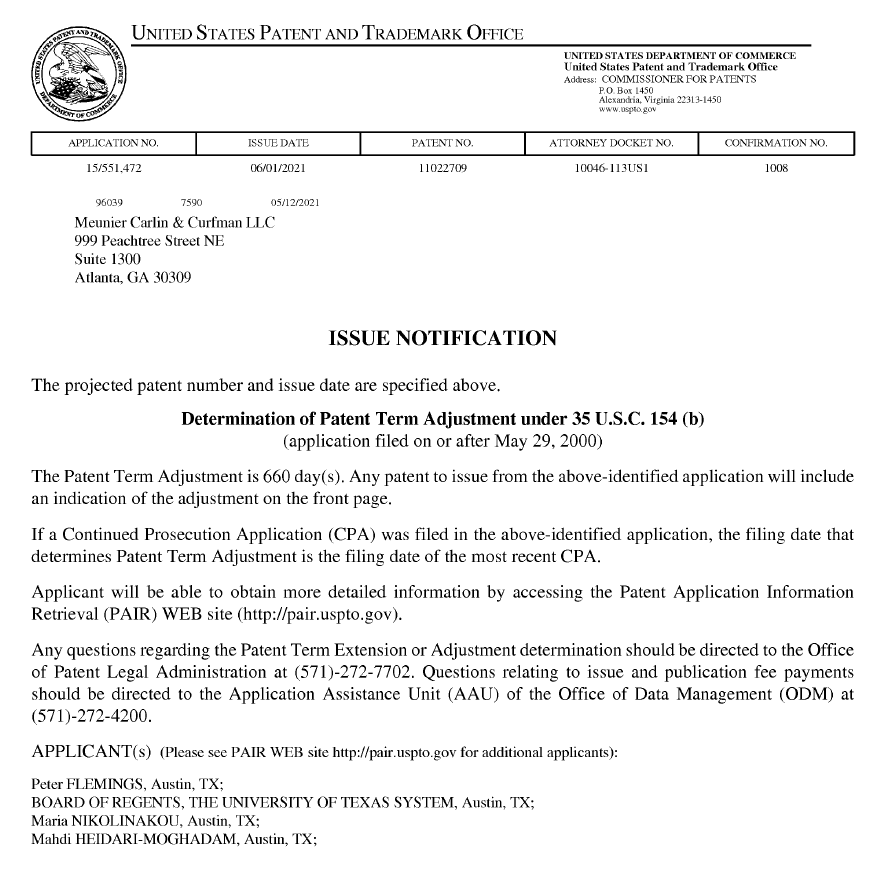
Click the image to download the patent issue letter (PDF).
June 27, 2021
Pore Pressure Prediction Patent
The UT GeoFluids FES method, "Pore-Pressure Prediction Based on Velocities Coupled with Geomechanical Modeling”, was issued U.S. Letters Patent number 11,022,709 on June 1, 2021.
The patent is available online at Google Patents.
June 27, 2021
UT GeoFluids Student Jean Joseph d’Hooghvorst Graduates
Congratulation Jean Joseph d’Hooghvorst who graduated in June 2021 with his PhD with honors (cum laude) from the University of Barcelona. His thesis “Geomechanical Study of the Tarfaya Basin, West African Coast, using 3D/2D Static Models and 2D Evolutionary Models” presents a full geomechanical approach to study the present-day and the evolution through time of the stresses and strains in salt basin systems.
June 27, 2021
UT GeoFluids Student Liam Eagle Graduates
Liam Eagle graduated from Tufts University with a Masters of Science in the Field Of Study Civil and Environmental Engineering. Congratulations Liam, and good luck in the future!
June 27, 2021
New Student Joins UT GeoFluids
Padraig Doran is a new student joining the GeoFluids group working on his masters in Civil and Environmental Engineering at Tufts University.
Click image to enlarge.
April 11, 2021
UT GeoFluids Meeting 2021
Thank you to everyone who attended our first fully online annual meeting!
GeoFluids members will find recorded talks in the consortium members' site, under the Presentations tab.
The agenda and list of participants will remain online at the archived event website.
See you all (in person, we hope) next year!
April 5, 2021
Book Published: A Concise Guide to Geopressure
Peter Flemings's book, A Concise Guide to Geopressure, is now available. To get your copy visit https://www.jsg.utexas.edu/flemings/geopressure/.
For a 20% discount code please email costa@ig.utexas.edu.
This book arose from the UT GeoFluids Consortium and it summarizes many of the concepts and case studies we have presented and you have contributed to. Read more about the origins of the book.
May 22, 2021
UT GeoFluids Student David Wiggs Graduates
Congratulations to UT GeoFluids student David Wiggs, who graduated today with a master's degree in geological sciences from the Jackson School of Geosciences.
After taking a few weeks well-earned vacation, David will be starting a new job with EOG Resources in San Antonio. We wish David all the best in the future!
February 12, 2021
UPDATE: UT GeoFluids Annual Meeting 2021 Postponed
Dear GeoFluids Colleague,
After consulting with several of you directly, we have decided to postpone the annual Geofluids meeting that was scheduled to start Wednesday, February 17. An extraordinary storm has hit Houston and Austin leaving many businesses closed, and many individuals without power and internet.
We will hold our meeting either in early March or early April and we will send a poll to get your feedback on timing.
We hope you and your family are safe and warm.
Peter Flemings
Jack Germaine
Maria NikolinakouFebruary 1, 2021
Registration is open for the 2021 UT GeoFluids Annual Meeting
The UT GeoFluids Annual Meeting will be held virtually from February 17-19, 2021 (Wednesday through Friday).
Registration is now open.February 1, 2021
UT GeoFluids Annual Meeting: Jeopardy Categories Finalized
To liven up our Virtual UT GeoFluids Annual Meeting we have added a daily Jeopardy event. The topics and scoreboard are shown below.
We urge attendees to start studying now!
January 12, 2021
New Research to be Published in Basin Research
A paper by Jean Joseph d’Hooghvorst, Maria Nikolinakou, Toby Harrold, Oscar Fernandez, Peter Flemings and Alejandro Marcuello has been accepted for publication in the journal, Basin Reseach. The paper shows how geologically constrained evolutionary geomechanical models can improve our understanding of salt diapir and basin evolution
January 8, 2021
Annual UT GeoFluids (Virtual) Retreat
The UT GeoFluids team gathered online this year for our annual retreat and workshop. The team are working hard putting the finishing touches to talks and discussing their research in preparation for the upcoming UT GeoFluids Annual Meeting in February.
We couldn’t shoot foam-tipped arrows at each other this year, so instead, we settled for a geomechanics-themed jeopardy contest!
Registration is open for the 2021 UT GeoFluids Annual Meeting
The UT GeoFluids Annual Meeting will be held virtually from February 17-19, 2021 (Wednesday through Friday).
Registration is now open.December 14-16: 3rd EAGE Workshop on Pore Pressure Prediction
Jean Joseph d’Hooghvorst attended the 3rd EAGE Workshop on Pore Pressure Prediction (online), where he presented his abstract about geologically constrained evolutionary geomechanical models of diapir and basin evolution.
Peter Flemings and Maria Nikolinakou also delivered invited keynote talks at the 3rd EAGEWorkshop on Pore Pressure Prediction.
December 1-17: Maria Nikolinakou presented at the AGU Fall meeting 2020.
She discussed the impact of splay fault initiation and evolution on the stress state in subduction-accretion complexes
December: Internship with ExxonMobil
Throughout the Fall 2020 semester, Sebastian Ramiro Ramirez interned with ExxonMobil in Houston, where he conducted object-based image analysis in Wolfcamp mudstones to quantify pore system properties.
November 10: Grad Student Landon Lockhart to take Chevron Summer Internship
We are excited to announce that GeoFluids doctoral student Landon Lockhart will be a 2021 summer intern with Chevron.
Lockhart, who has also interned with Peregrine Petroleum and last year received a Halliburton Landmark Earth Model Award, will be working with Chevron’s Geomechanics team throughout the summer of 2021.
Congratulations Landon!
October 30: Bureau Seminar Series: The origins of overpressure at the Macondo Well
Peter Flemings gave the Bureau of Economic Geology’s Seminar Series talk, sharing over a decade of research into the geologic origins of the Macondo well blowout.
Watch the recorded talk here: https://youtu.be/A1l0Hg85kfo
Abstract: The Deepwater Horizon blowout of the Macondo well began on April 20, 2010 in Mississippi Canyon block 252, deepwater Gulf of Mexico. Eleven people died and ~4 million barrels of oil leaked into the Gulf of Mexico. This human and environmental catastrophe focused the world on the incredible pressures encountered in the search for hydrocarbons. I describe the pressure and stress at Macondo and I use these observations to illustrate 3 processes that drive pressure. I first demonstrate how rapid sedimentation of clay-rich sediment generates overpressure. I then show that the regression of pressure and stress regression at the Macondo target is driven by lateral flow within the reservoir. Finally, I illustrate that the absolute pressure at the Macondo reservoir is controlled by natural hydraulic fracturing where the reservoir is structurally elevated. A better understanding of these processes will improve our ability to explore for, and produce, hydrocarbons and to store CO2.
October 26: Sebastian Ramirez Receives Equinor Fellowship
Maria Nikolinakou gave a departmental lecture at Stevens Institute of Technology on stress and pressue in salt systems
September 30: Sebastian Ramirez Receives Equinor Fellowship
Equinor has awarded a new fellowship to UT Jackson School Graduate Student, Sebastian Ramiro Ramirez. The one-year fellowship will help fund Ramirez's research until September 2021, and renews a previous $60,000 fellowship Equinor awarded him in 2019.
September 25: Brendan Casey profiled in GEOSTRATA
Brendan Casey, past member of the UT GeoFluids Team who systematically studied the stress dependency of mudrock compressibility and strength, was featured this month in GEOSTRATA, the official bi-monthly magazine of the Geo-Institute: New Faces in G-I: Brendan Casey
August 25: Kickoff Meeting for 2021 Annual Meeting
Faculty, staff, and graduate students met virtually to kickoff planning for the 2021 UT GeoFluids Annual Meeting.
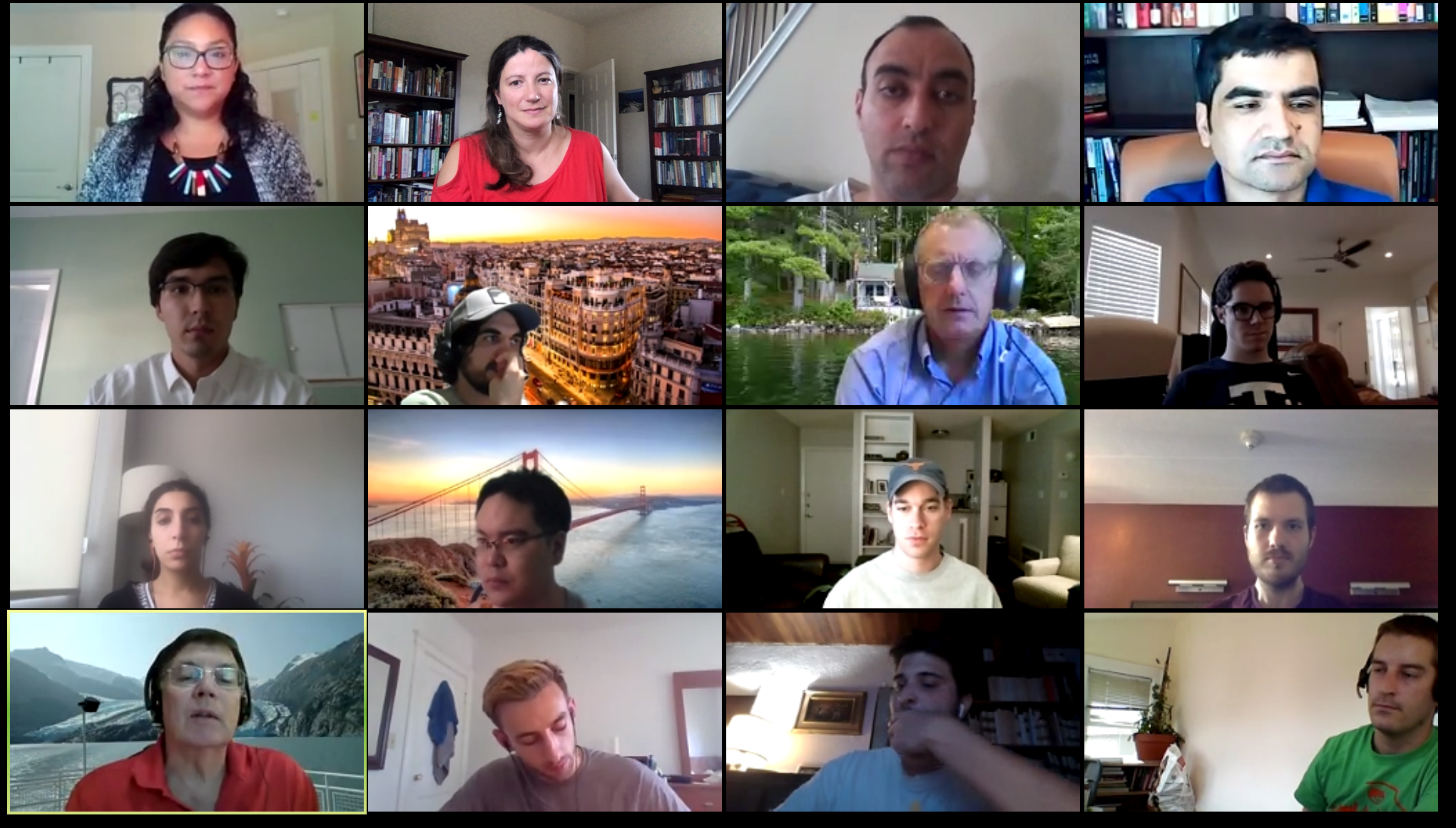
July 22: Unconventional Resources Technology Conference 2020
Sebastian Ramirez presented a paper, 'Porosity and Permeability Heterogeneity in the Upper Wolfcamp, Delaware Basin, West Texas: Implications for Production' at URTeC 2020. Due to the pandemic, URTeC 2020 was held online.
The paper has also been published online and can be accessed at: https://doi.org/10.15530/urtec-2020-2105
January 12: Landon Lockhart cuccessfully passed his qualifying exam.
Congratulations, Landon!
Paper: "Claystone porosity and mechanical behavior vs. geologic burial stress"
Russ Ewy, Jozina Dirkzwager, and Craig Bovberg published a wonderful paper entitled ‘Claystone porosity and mechanical behavior vs. geologic burial stress’ in Marine and Petroleum Geology. You can access it here until Sept. 4, 2020: Claystone porosity and mechanical behavior vs. geologic burial stress
This paper integrates decades of mudrock research at Chevron. Highlights include:
- Claystones from different basins have a common trend of porosity vs. effective stress.
- Claystones transition from soil-like to rock-like behavior with increasing burial.
- Claystones often have an apparent preconsolidation stress higher than actual.
The exploration of how rocks transition from ‘soil-like’ to ‘rock-like’ behavior is fascinating.
UT GeoFluids continues to work with Chevron to integrate our work in resedimentation with work on intact mudrocks as we strive to better understand mudrock behavior.
Graduating Students and Theses
Deniz Ranjpour also graduated with a PhD degree from Tufts. Her thesis is titled: Stiffness and Anisotropy Characterization of Mechanically-Compressed Cohesive Soils Using Directional Wave Propagation. Deniz is staying in Boston and will start working for a business company in October.
James Finnegan graduated with a MS degree from Tufts this summer. His thesis is titled: Comparison of Resedimented with Intact Mudrock Behavior. Jim has moved to California to work in construction.
Internship with Equinor
Sebastian Ramiro Ramirez completed a summer internship with Equinor in Austin. During the internship, Sebastian worked on identifying U.S. onshore analogs for the Vaca Muerta Formation, from basin to pore scale, using published literature and petrophysical information from Equinor wells
Internship with EOG Resources
David Wiggs completed an internship with EOG Resources this summer. He worked in their Artesia, New Mexico office and had the opportunity to work on a project focused on seismic inversion for identification of carbonate prospects.
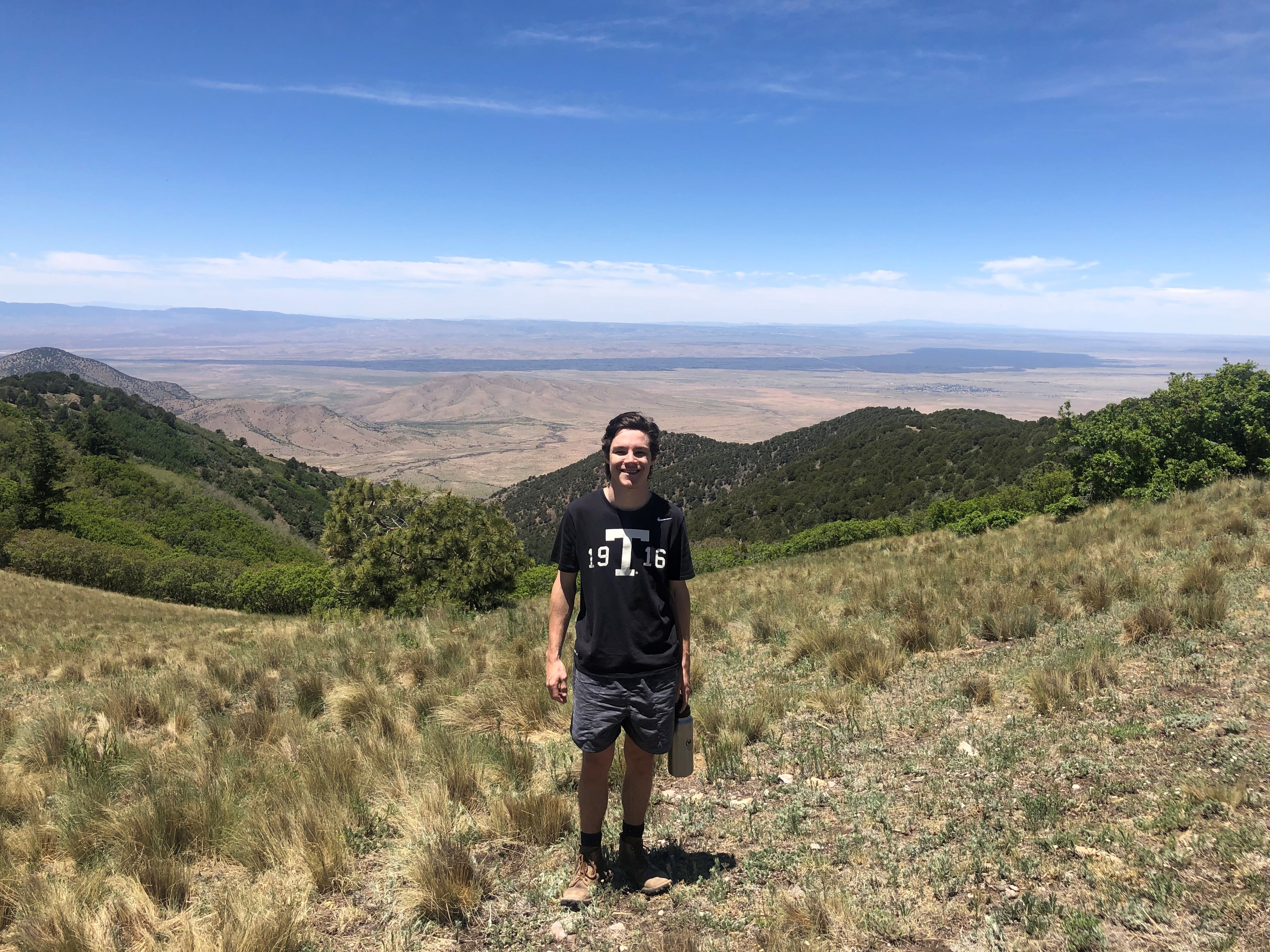
UT GeoFluids Annual Meeting 2020
Thank you to everyone who attended! UT GeoFluids members will find the recorded talks, presentations and abstracts under Presentations on the consortium member pages.
You can find the agenda and names of participants who registered for the meeting at the archived event website.
See you all next year!
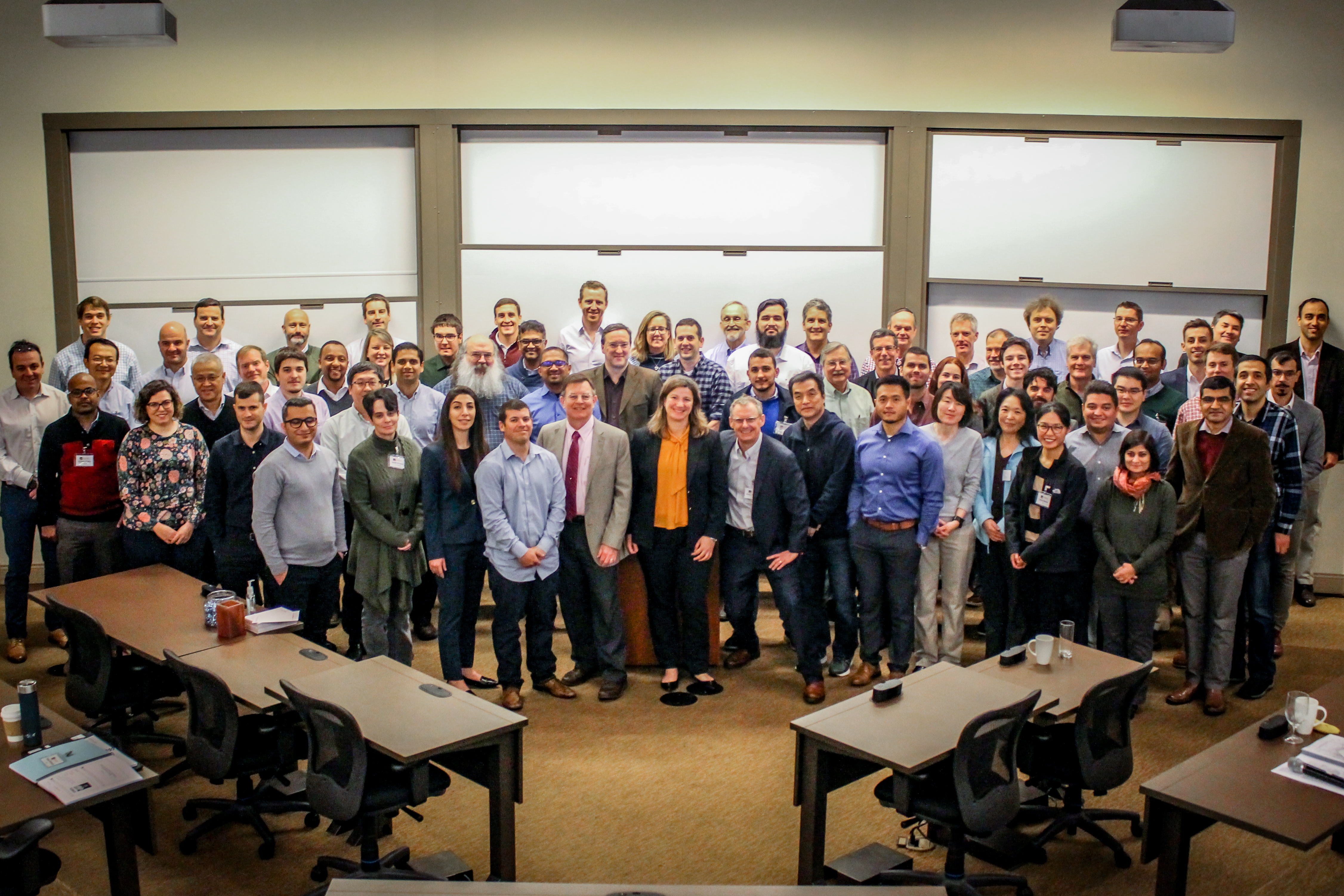
UT GeoFluids Annual Meeting 2020 Registration Now Open
Registration for the next UT GeoFluids Annual Meeting is now open. The meeting is scheduled to take place Wednesday, February 19, 2020 to Friday, February 21, 2020 at the AT&T Executive Education and Conference Center in Austin, Texas.
To register and for information about the agenda, visit the event website.
UT GeoFluids has secured a limited number of hotel rooms at a special rate. If you plan to attend, be sure to reserve your room early. Click here to reserve a room.

Annual UT GeoFluids Writing Retreat
January 7-11, 2020: The UT GeoFluids team gathered in Marble Falls, TX, for our annual writing workshop in preparation for the UT GeoFluids Annual Meeting in February. The team spent long days working on talks, discussing research, and preparing for the upcoming meeting. The team also found some time to let off a little steam playing archery tag...
UT GeoFluids at AGU
December 9-13, 2019: Maria Nikolonakou attended AGU's Fall meeting, 2019 and gave a talk on "Mechanisms generating fluid overpressure at the trench of subduction zones and implications for megathrust weakening”
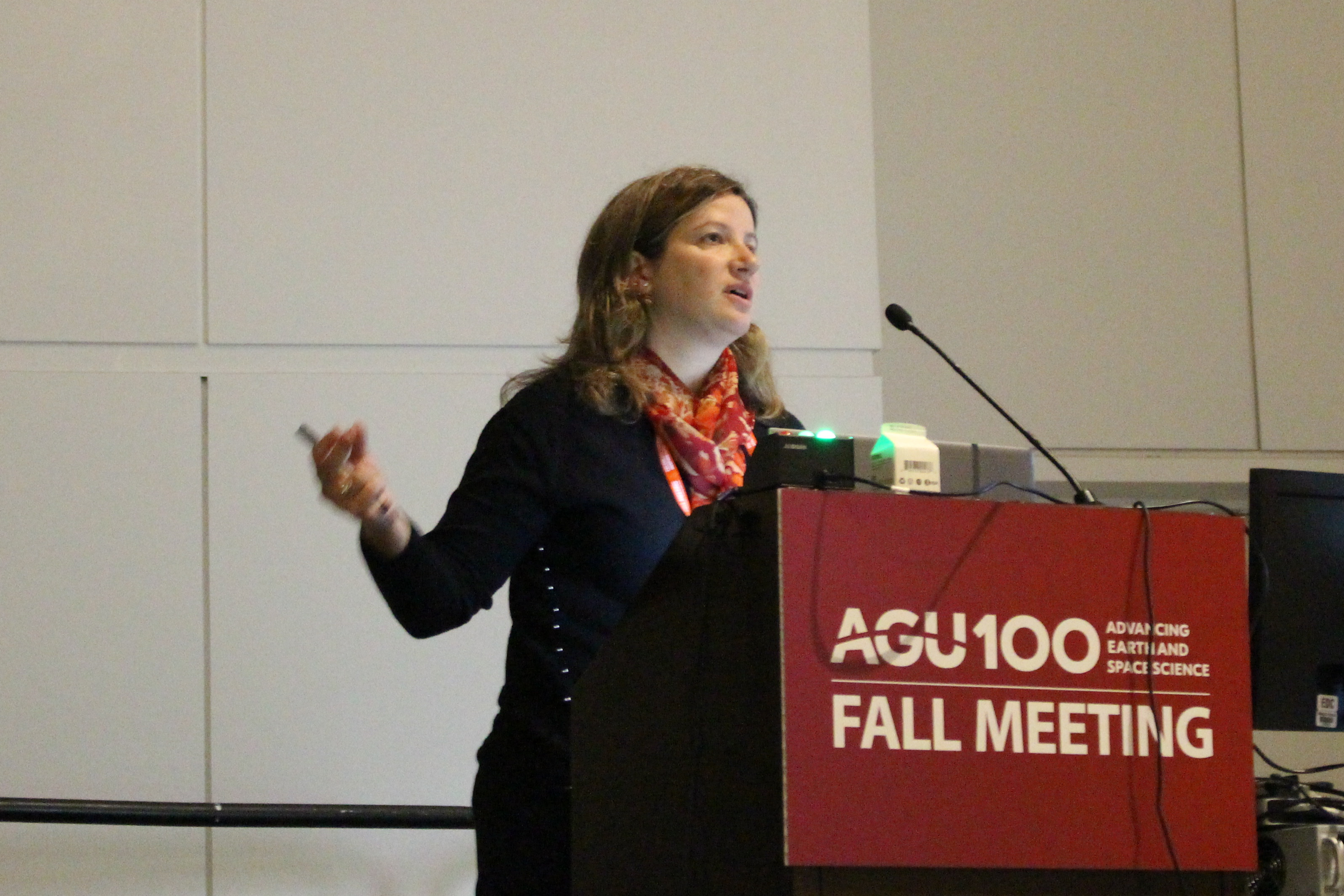
UT GeoFluids at GCSSEPM Foundation Perkins-Rosen Research Conference
December 3-6, 2019: Maria Nikolonakou attended the 2019 GCSSEPM Foundation Perkins-Rosen Research Conference in Houston, TX, and presented her talk on "Controls on styles of extensional diapir rise and fall”.

UT GeoFluids visits Shell
November 18, 2019: Peter Flemings, Maria Nikolonakou and graduate students, Landon Lockhart and Sebas Ramiro, visited Shell.

31st AGL Annual Review Meeting
November 7-8, 2019: Jean Joseph d’Hooghvorst, Maria Nikolinakou, and Mahdi Heidari contributed to the 31st annual review meeting of the Applied Geodynamics Laboratory (AGL) at the Bureau of Economic Geology in Austin, TX. Jean Jospeh presented a talk on the processes above a rising diapir in regional shortening.
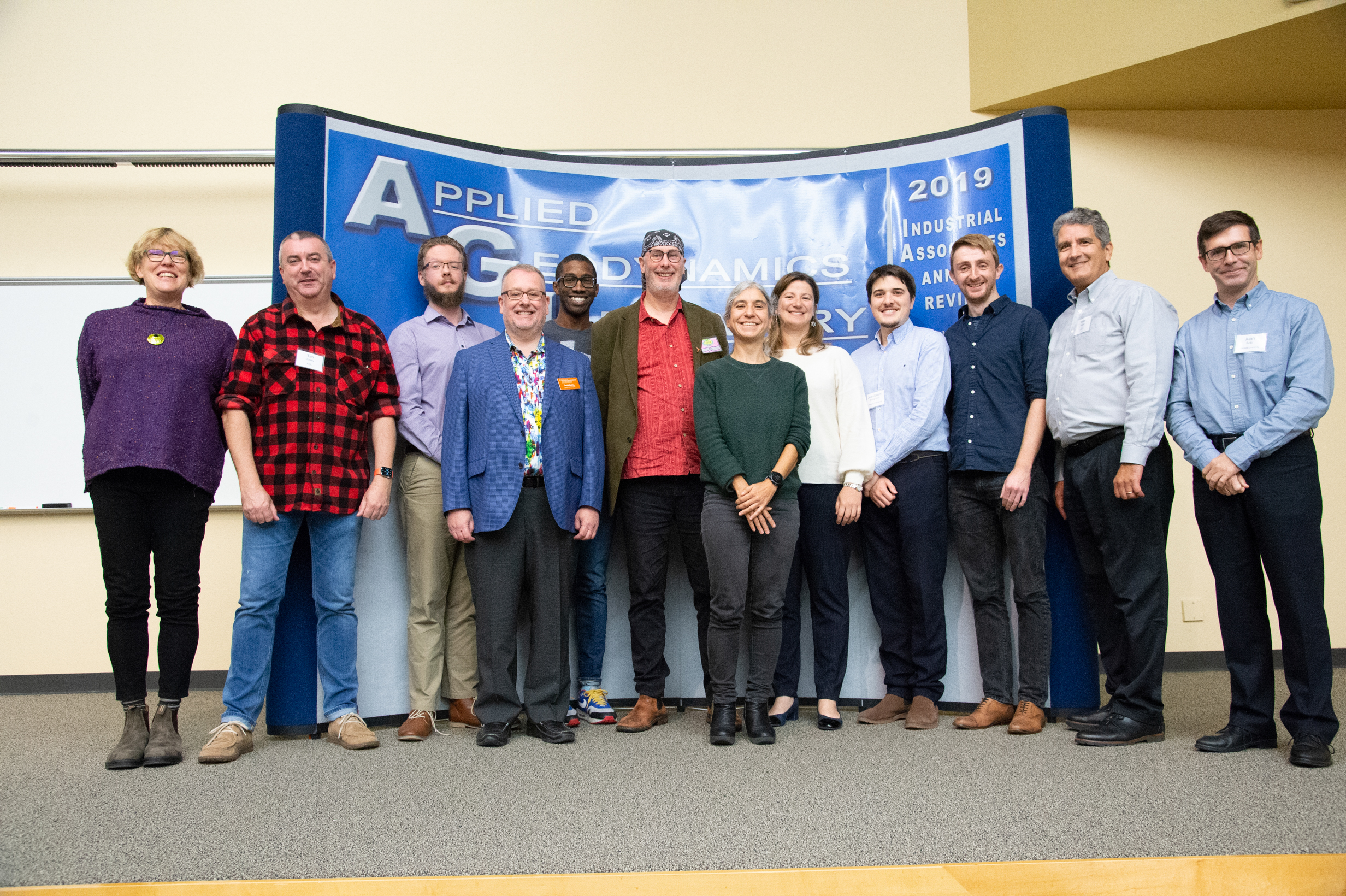
The Flemings Research Group Tested their Mettle at Urban Axes
October 26, 2019. Austin, Texas. Click here if the plugin does not load.

UT GeoFluids at the 14th International Congress on Rock Mechanics and Rock Engineering
September 13-18, 2019: Maria Nikolinakou attended the 14th International Congress on Rock Mechanics and Rock Engineering. She presented her paper titled: “Geomechanical modeling of mudrock stress-level dependency and application to a salt-sediment system”. Maria also represented the United States Rock Mechanics in the ISRM Council meeting (pictured).
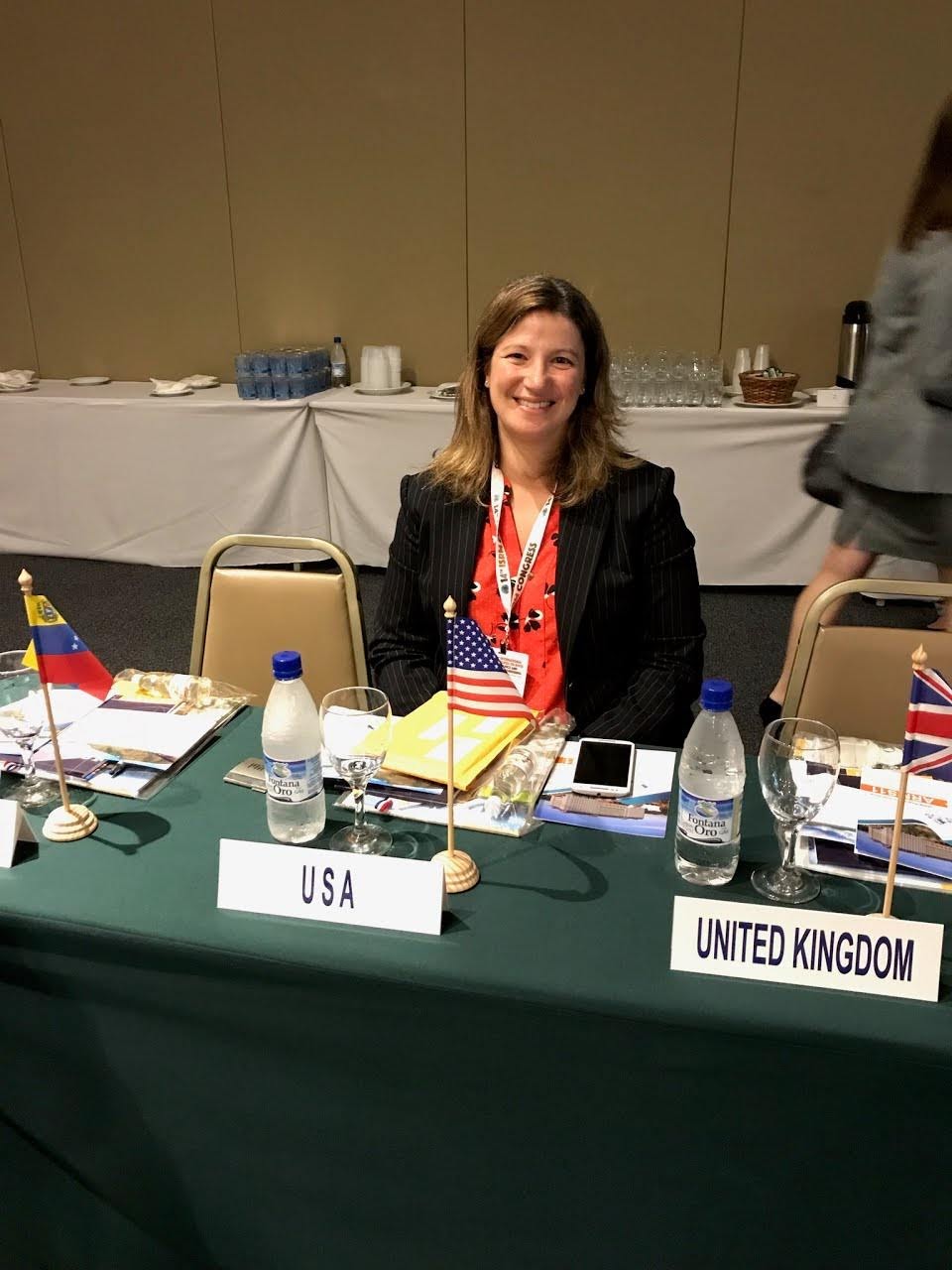
Evolutionary Geomechanical Modelling at The University of Texas at Austin
September 6, 2019: Jean Joseph d’Hooghvorst completed a two and a half month, summer visit at The University of Texas at Austin to work with Maria Nikolinakou and Peter Flemings on evolutionary geomechanical modelling.

Seminar at The University of Texas at El Paso, Geological Sciences
August 26, 2019: Maria Nikolinakou visited the Geological Sciences department at UTEP and was the first seminar speaker for the Fall 2019 semester. Maria also spent time with students from the salt groups of Dr. Giles and Dr. Langford.
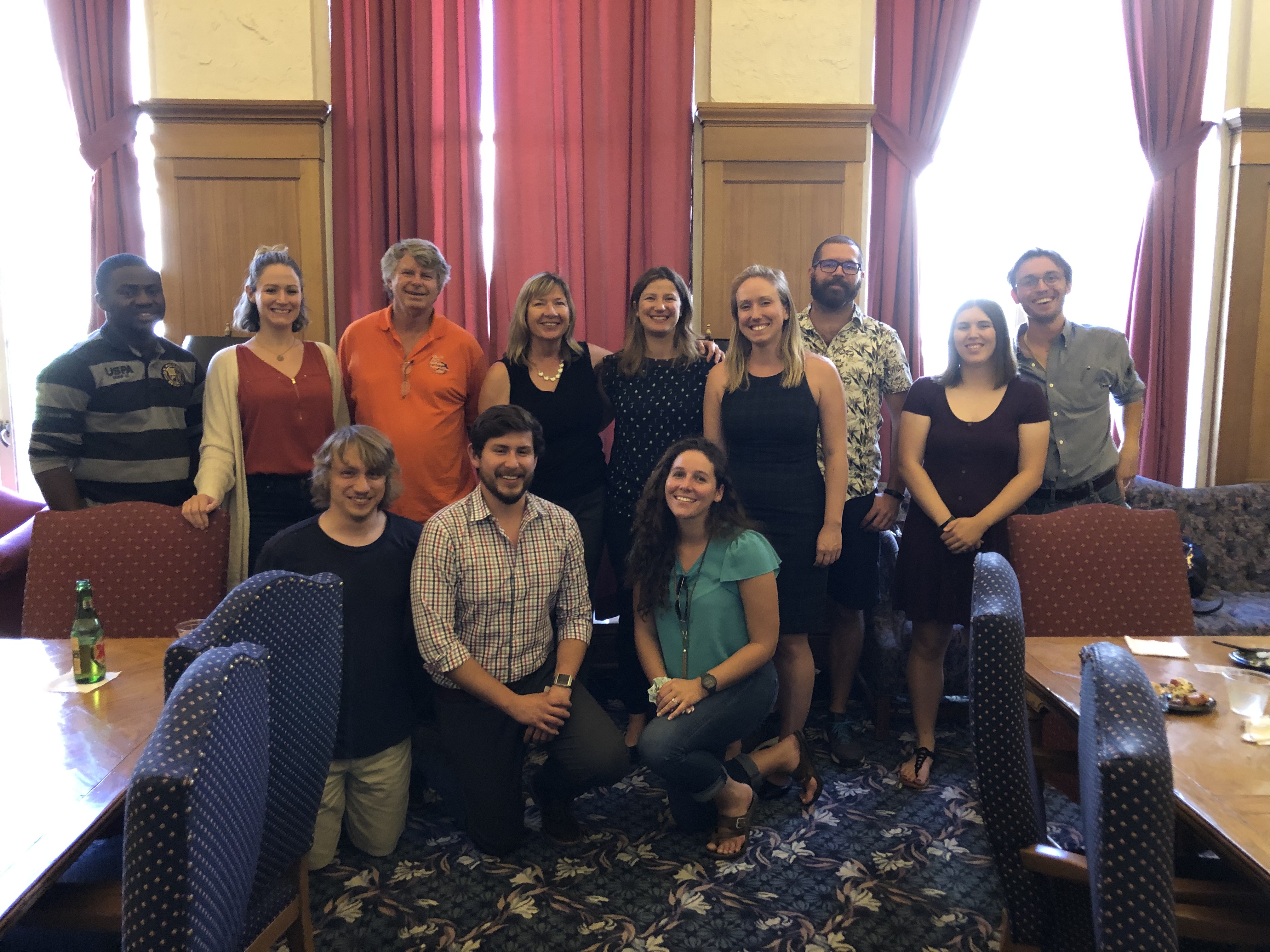
New paper in Petroleum Geoscience
August 23, 2019: a paper by Jean Joseph d’Hooghvorst, Toby Harrold, Maria Nikolinakou Oscar Fernandez and Alejandro Marcuello shows the comparison of stresses in 3D vs 2D geomechanical modelling of salt structures in the Tarfaya basin (West African coast), published in Petroleum Geoscience. https://doi.org/10.1144/petgeo2018-095

New Thematic Set on the Mechanics of Salt Systems
August, 2019: Maria Nikolinakou, Rajesh Goteti (Saudi Aramco), and Mahdi Heidari have put together a thematic set on "Mechanics of salt systems: state of the field in numerical methods”.
The first of two volumes in the set is now published in the August issue of Petroleum Geoscience.
The August issue is special in that it celebrates 25 years of Petroleum Geoscience and among other features marking the journal's anniversary, introduces a new series of papers on the theme of energy geoscience.

PetroBras becomes a UT GeoFluids Member
July 26, 2019: We are very pleased to announce that PetroBras has joined the UT GeoFluids consortium. Welcome PetroBras!
Save the Date! UT GeoFluids 2020 Annual Workshop
The UT GeoFluids 2020 Annual Meeting will take place February 19-21, 2020, at the AT&T Conference Center, Austin TX.
Agenda and registration details to follow soon.
ARMA Symposium
June 23-27, 2019: UT GeoFluids attended the 53 US Rock Mechanics Geomechanics Symposium (ARMA) in Brooklyn, New York. Maria Nikolinakou presented a paper on geomechanical modeling of sediment stress-level dependency with application to a salt system. Maria also chaired a session on Constitutive behavior in geomechanics: experiments, simulations and applications, and was member of the organizing committee.
Jean Joseph d’Hooghvorst presented a paper on insights from sensitivity analysis of geomechanical modelling of a salt structure offshore west Africa.
AAPG ICE Conference
May 19-22, 2019: Maria Nikolinakou and Mahdi Heidari presented at the 2019 AAPG ICE Conference.
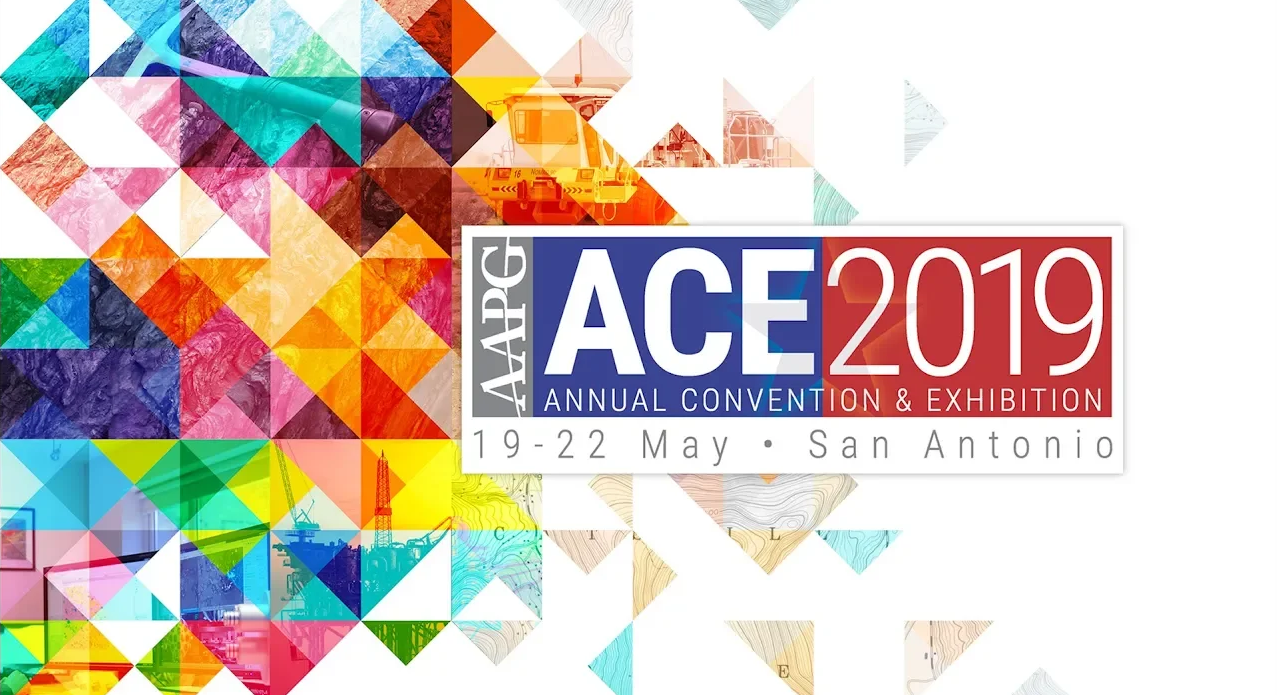
2nd EAGE Workshop
Jean Joseph d’Hooghvorst attended the 2nd EAGE workshop on pore pressure prediction in Amsterdam (Netherlands). He presented a 2D vs 3D geomechanical modelling comparison to influence pore pressure and fracture gradient analysis..
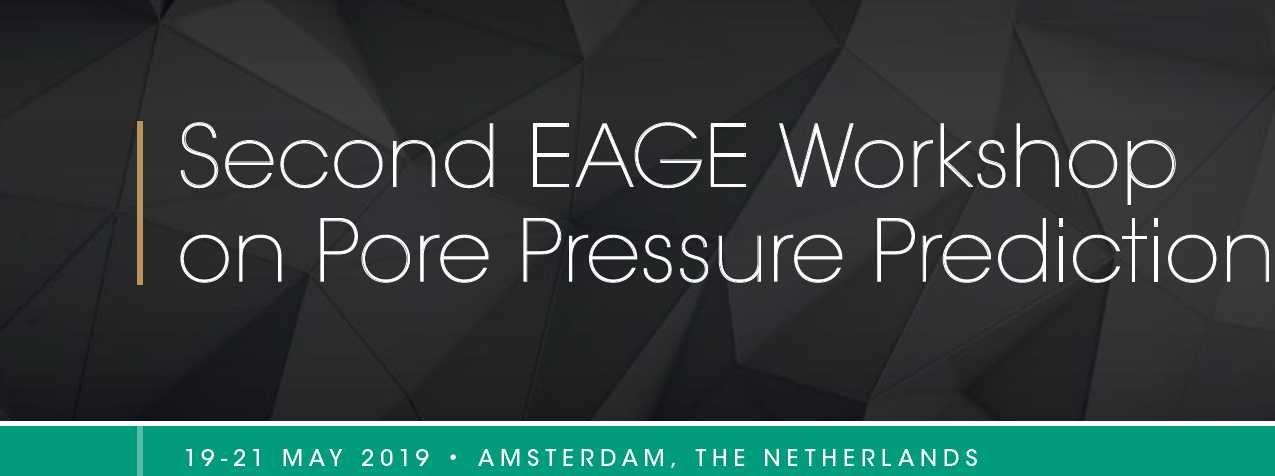
Chevron Geomechanics Workshop
May 19, 2019: Maria Nikolinakou presented at Chevron’s Geomechanics workshop
BP Visit
May 15, 2019: Peter Flemings and Maria Nikolinakou visited BP
GeoFluids 2020 Update
We are pleased to announce that Anadarko is the first company to pay its GeoFluids 2020 invoice! Thank you Anadarko!
Press: Complex Geology Contributed to Deepwater Horizon Disaster. New Study Finds
May 7, 2019: A paper by Will Pinkston and Peter Flemings reveals the complex geologic conditions that contributed to the Deepwater Horizon disaster. Read the news release.
Hess Visit
May 7, 2019: Maria Nikolinakou visited Hess to present her work in geomechanical modeling.
NIU Seminar
April 19, 2019: Maria Nikolinakou visited NIU at DeKalb, Illinois to give the Geology and Environmental Geosciences departmental seminar.

UT GeoFluids2020 update
In April, 2019, two further energy companies, Andarko and Hess, signed the GeoFluids2020 MOA amendment. Their addition takes the total number of confirmed industry members for UT GeoFluids2020 to nine. Learn more.
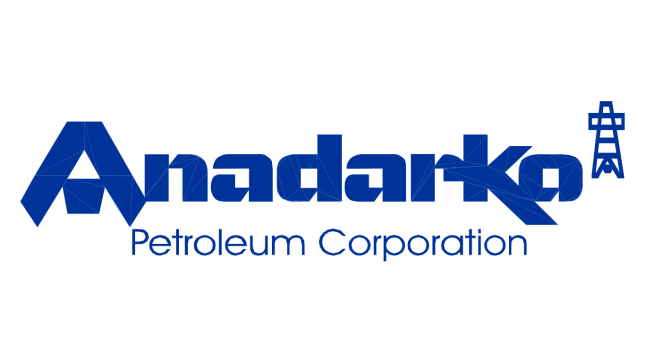
UT GeoFluids Meeting
February 20-22, 2019: UT GeoFluids held a meeting in Austin for sponsors. During a workshop on "Exploring shear-induced pore pressure generation", Dr. Germaine demonstrated the developmsent of effective stress on a sand specimen by applying a negative head of water.
Annual UT GeoFluids Workshop
January 8-12, 2019: The UT GeoFluids team gathered in Marble Falls, TX, for our annual workshop to review our research and prepare for the UT GeoFluids Meeting to be held in February 2019. We spent long days working on talks, discussing science, and preparing for the upcoming meeting. In our spare time we practiced skeet shooting.
Visit to Petrobras
December 1-9, 2018: Maria Nikolinakou visited PetroBras in Rio de Janeiro, Brazil.
Visit to Universitat Autònoma de Barcelona
November 15, 2018: Barcelona: Jean Joseph d’Hooghvorst gave a talk at the Universitat Autònoma de Barcelona about geomechanical modeling of salt basins. The talk was hosted by SEM-CAT.
Visit to BHP Bilton
November 15, 2018: Peter Flemings and Maria Nikolinakou visited BHP Billiton in Houston, TX.
Visit to George Washington University
September 17, 2018: Maria Nikolinakou visited George Washington University, D.C., and presented at the CEE department seminar.
Visit by ConocoPhillips
Sept. 12, 2018: Philip Heppard and Michael Merrell from ConocoPhillips visited GeoFluids to discuss a project to predict pore pressure during unloading in unconventional basins.
Visit to Repsol
July 9-10, 2018: Peter Flemings visited Repsol in Madrid, Spain
ARMA 2018
June 17-20, 2018: Maria Nikolinakou, Mahdi Heidari, and Yi Fang participated in the 52nd US Rock Mechanics Geomechanics Symposium (ARMA) in Seattle, WA. Yi Fang was elected as member of the ARMA Future Leaders. Mahdi Heidari is also a member.
Maria Nikolinakou with the ARMA Future Leaders
From left to right in the photo: Maria Nikolinakou and Derek Elsworth.
GeoFluids 2020: the next decade
Shell hosted 'GeoFluids 2020: the next decade' where Peter Flemings, Jack Germaine, and Maria Nikolinakou presented the GeoFluids research proposal for the next ten years.
Visit to Pemex
May 15-16, 2018: Peter Flemings and Maria Nikolinakou visited Pemex at Ciudad de Carmen, MX
AAPG European Regional Conference
May 2-3, 2018: Lisbon. At the AAPG European Regional Conference, Jean Joseph d’Hooghvorst presented part of his PhD research in Geomechanical modeling for exploration wells, a 2D vs 3D comparison in a case study from the West African Coast.
Celebrating Kris Darnell's PhD Defense
Marble Falls, Tx: The GeoFluids Retreat
Top row, left to right: Manasij Santra, Chunwei Ge, Stephen Lambert, Jack Germaine, Amanda Parry
Bottom row, left to right: Mahdi Heidari, Steve Phillips, Maria Nikolinakou, Landon Lockhart, Deniz Ranjpour, Peter Flemings, Mark Zablocki, Jean Joseph d'Hooghvorst.
Nankai Trough
January 2018: Baiyuan Gao on the drillship Chikyu
6th Biot Conference
July 9-14, 2017
Athma Bhandari and Maria Nikolinakou attended the 6th Biot Conference on Poromechanics, in École des Ponts, ParisTech and IFSTTAR, in Paris, France.
From left to right in the photo: Maria Nikolinakou, Igor Shovkun (PGE), Athma Bhandari, Espinoza D. Nicolas (PGE).
Pemex
May 18, 2017: Villahermosa, MX: Maria Nikolinakou visited Pemex and discussed geomechanical modeling of salt systems.
Fugro
May 12, 2017; Houston: Maria Nikolinakou visited Fugro.
Operators Pore Pressure Forum
May 12, 2017; Woodlands, TX: Maria Nikolinakou discussed pore pressure prediction in salt systems at the Operators Pore Pressure Forum.
Anadarko
May 11, 2017; Woodlands, TX: Maria Nikolinakou visited Anadarko and discussed geomechanical modeling of salt systems.
U.S. Science Support Program Workshop
April 11-13, 2017; Dallas: Maria Nikolinakou participated in the USSSP-sponsored workshop, "Drilling strategies for assessing links between Quaternary Gulf Stream dynamics, pore pressure evolution, and slope stability on the Western North Atlantic Margin: An IODP proposal development study”
American Association of Petroleum Geologists
April 2-5, 2017; Houston, AAPG annual convention & exhibition. Maria Nikolinakou presented a poster on Stress, deformation and failure associated with salt-sheet emplacement.
Petroleum Geo-Services
March 9, 2017; Houston: Maria Nikolinakou visited PGS and discussed geomechanical modeling of salt systems.
Society for Underwater Technology
March 2, 2017; Houston: Maria Nikolinakou gave a talk at the Society for Underwater Technology: Stress, deformation and pressure prediction near salt. The talk was hosted by BP and was well attended by in-room and online audience.
Posted July 2017
American Rock Mechanics Association 2017
Feb. 3, 2017: Maria visited Charleston, SC for the ARMA Board meeting.
Posted July 2017
UT GeoFluids Workshop 2017
UT GeoFluids personnel gathered in Marble Falls, TX, for the annual GeoFluids workshop. The students and staff worked hard on presentations, posters, and the workshop for the upcoming 2017 UT GeoFluids Consortium Meeting.
Posted January 2017
GeoFluids Group Competes in AGU Fun Run
Members of GeoFluids competed in the 2016 American Geophysical Union Fall Meeting Fun Run in San Francisco. Congratulations to all the finishers!
Posted December, 2016
Peter Flemings receives 2016 Joseph C. Walter Jr. Excellence Award
Peter Flemings received the 2016 Jackson School of Geosciences Joseph C. Walter Jr. Excellence Award, in recognition of the GeoFluids Team's outstanding service and special contributions to teaching and research programs. Congratulations Peter!
Posted December, 2016
Amanda Parry Receives 2016-2017 Fellowship
Amanda Parry has been named the inaugural recipient of the Linda M. Abriola Graduate Fellowship in engineering. She was selected for the fellowship as one of the most promising graduate applicants to the Tufts School of Engineering interested in research in the Department of Civil and Environmental Engineering. Congratulations Amanda!
Posted November, 2016
Registration Open for 2017 UT GeoFluids Consortium Meeting
We will hold the 2017 UT GeoFluids Consortium Meeting Wednesday, February 22, 2017 to Friday, February 24, 2017 on the main UT campus at the AT&T Executive Education and Conference Center. We hope you will consider attending the 2017 meeting. Details can be found on the event website.
When:
Wednesday, February 22 - Friday, February 24, 2017
The meeting opens with a poster session reception on Wednesday evening. Talks begin Thursday and run through Friday at 1 pm.Where:
The University of Texas at Austin
AT&T Executive Education and Conference Center, 1900 University Ave, Austin, TX 78705RSVP:
Registration is open; please respond at the event website. We look forward to your response.Hotel:
The AT&T Executive Education and Conference Center room block is open. This year's rate is $185 per night. To guarantee this rate, you must make your room reservation before January 21, 2017. The room block sells out quickly, so to guarantee a room we suggest you make your reservation early.Booking website: https://resweb.passkey.com/go/GEOFLUI217
We hope to see you at UT GeoFluids 2017!
Posted October 2016
Baiyuan Gao Receives Travel Award
Baiyuan Gao received a travel award from the National Science Foundation to attend the Subduction Zone Observatory Workshop in Boise, ID, from Sept 29 - Oct 1. Congratulations, Baiyuan!
Posted September 2016
UT GeoFluids Group Research Day
On August 23, the UT GeoFluids group had a day-long meeting reviewing our research advancements over the summer. The group has had a successful summer! Afterwards, we celebrated with pizza and bowling.
Posted August 2016
Kris Darnell receives Spring 2017 Fellowship
Congratulations to Kris Darnell for receiving a Ewing/Worzel Fellowship for spring 2017. He was awarded this fellowship for demonstrating meritorious progress in pursuit of his graduate degree.
Posted August 2016
Kris Darnell receives Best Paper Award
Congratulations to Kris Darnell for receiving the Jackson School of Geosciences Best Paper Award for a graduate student publication in 2015. Kris's paper was submitted by the MG&G theme and was selected as the top paper from amongst those submitted by all themes. His paper is entitled Transient seafloor venting on continental slopes from warming-induced methane hydrate dissociation, and is available for download on the Member Area Publication Site.
Posted May 2016
New Laboratory at Tufts University
The Tufts Advanced Geomaterials Laboratory (TAG-LAB) is where Jack Germaine built his new laboratory, with upgraded space and technology.
Posted April 2016
Deniz Ranjpour and Anthony J. Hanley Awarded Scholarships for World Tunnel Congress
Tufts graduate students Deniz Ranjpour and Anthony J. Hanley were each awarded a scholarship to attend WTC 2016 being held in San Francisco April 22-28. Congratulations to both of them!
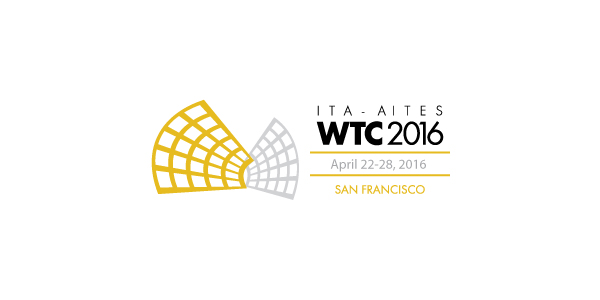
Posted April 2016
Mahdi Heidari Promoted to Research Associate
We'd like to congratulate Mahdi Heidari for his promotion to Research Associate at The University of Texas at Austin. He has made a significant impact in geomechanical modeling.
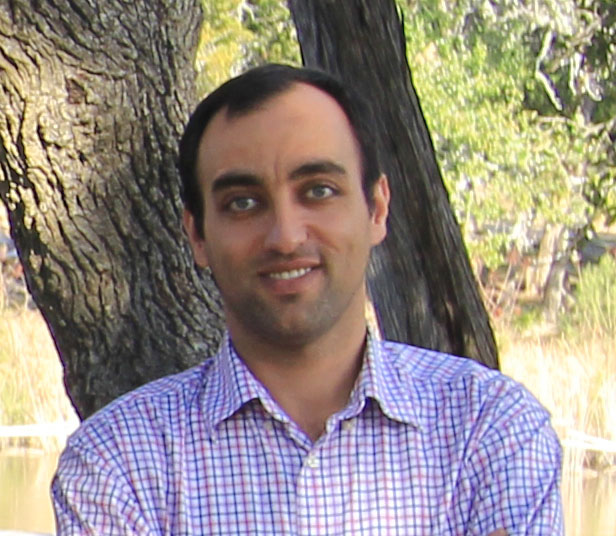
Posted April 2016
UT GeoFluids 2016 Annual Meeting
The 2016 Annual UT GeoFluids Consortium Review Meeting was enthusiastically attended by approximately 80 representatives from 13 companies. We held a poster session, gave 22 presentations, taught a workshop on flow focusing and gas entrapment, and had many discussions and recommendations for future work. The PowerPoint presentations, posters, and workshop materials from the 2016 meeting are available for download in the Members' Area of the UT GeoFluids website.
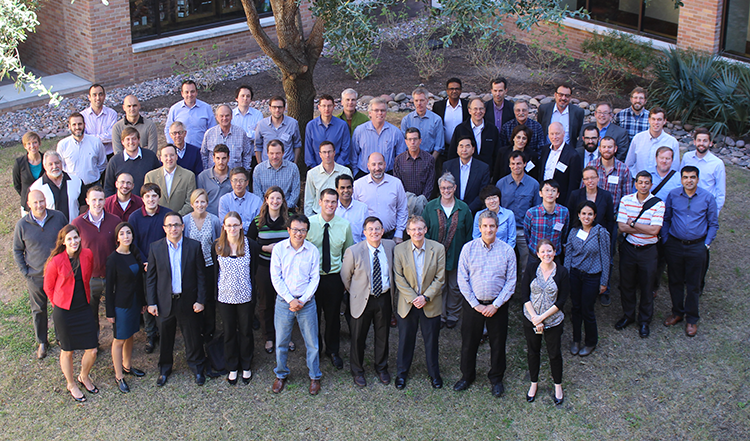
Posted March 2016
Jana Marjanovich Awarded Doctoral Degree
Jana successfully defended her dissertation in December 2015, entitled Stiffness Characterization of Mechanically-Compressed Cohesive Soils Using Wave Propagation. Jana is currently looking for job opportunities on the West Coast.
Posted January 2016
Pemex Joins UT GeoFluids
We are excited to welcome Pemex to the UT GeoFluids Consortium. We look forward to working with Pemex.
Posted January 2016
Jack Germaine Gives First Charles C. Ladd Memorial Lecture
Jack Germaine, co-director of UT GeoFluids, gave the first Charles C. Ladd Memorial Lecture, in November 2015, entitled Trends in Mechanically Compressed Sediment Behavior with Stress and Plasticity. Please see the Boston Society of Civil Engineers Section (BSCES) website for more information.
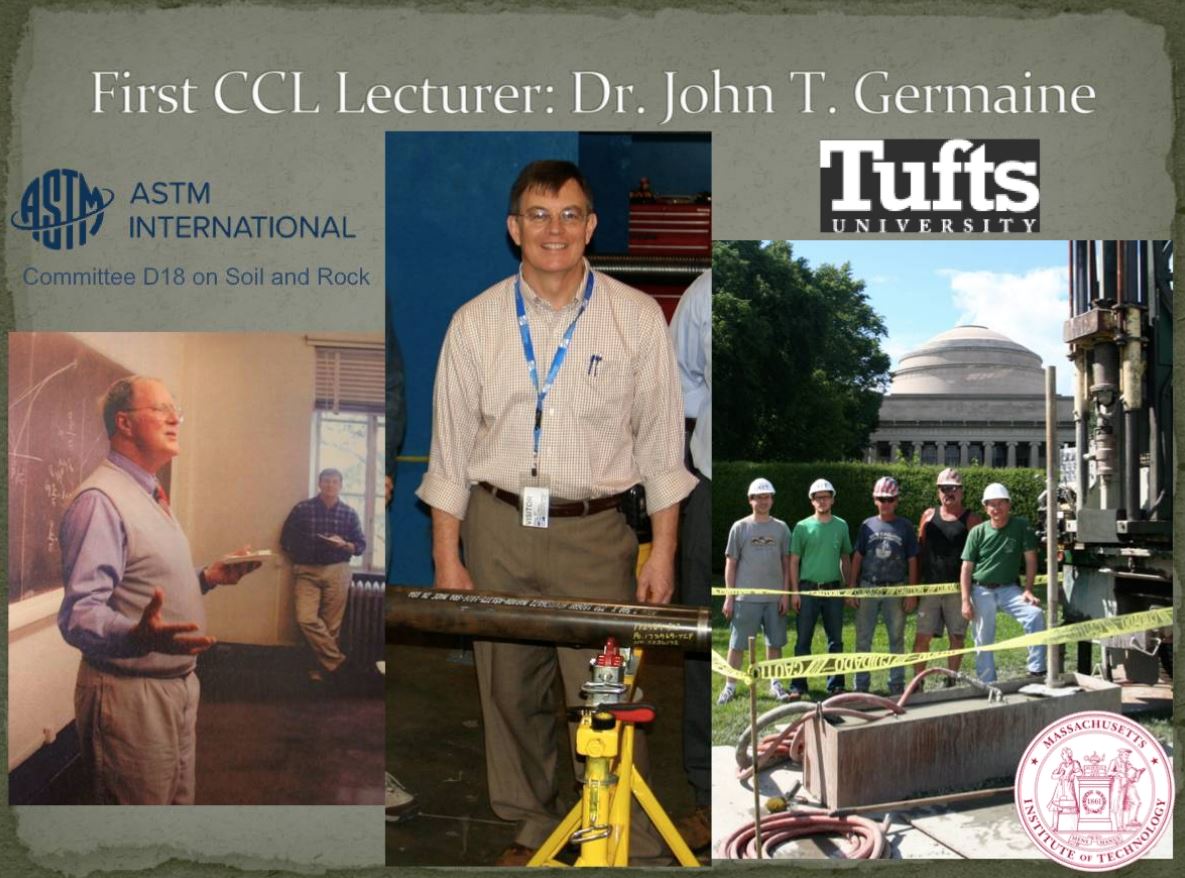
Posted January 2016
UT GeoFluids Workshop 2016
January 2016 UT GeoFluids personnel gathered in Marble Falls, TX, for the annual GeoFluids workshop. The students and staff worked hard on presentations, posters, and the workshop for the upcoming 2016 UT GeoFluids Consortium Meeting.
Registration is open for the 2016 GeoFluids Consortium Meeting. Meeting details can be found on the event website.
Posted January 2016
Registration Open for 2016 UT GeoFluids Consortium Meeting
We will hold the 2016 UT GeoFluids Consortium Meeting Wednesday, March 2, 2016 to Friday, March 4, 2016 on the main UT campus at the AT&T Executive Education and Conference Center. We hope you will consider attending the 2016 meeting. Details can be found on the event website.
When:
Wednesday, March 2, 2016 - Friday, March 4, 2016
The meeting opens with a poster session reception on Wednesday evening. Talks begin Thursday and run through Friday at 1pm.Where:
The University of Texas at Austin
AT&T Executive Education and Conference Center, 1900 University Ave, Austin, TX 78705
RSVP:
Registration is open; please respond at the event website. We look forward to your response.Hotel:
The AT&T Executive Education and Conference Center room block is open. This year's rate is $185 per night. To guarantee this rate, you must make your room reservation before March 2, 2016. The room block sells out quickly, so to guarantee a room, we suggest you make your reservation early.Booking website: https://resweb.passkey.com/go/UTGEOF0216
We hope to see you at UT GeoFluids 2016!
posted October 2015
Amer Deirieh Successfully Defends Doctoral Thesis
Please join us in congratulating Amer Deirieh for completing his doctoral thesis entitled 'From Clay Slurries to Mudrocks: A Cryo-SEM Investigation of the Development of the Porosity and Microstructure.' Dr. Deirieh will begin his post-doctoral work at Tufts University.
Posted October 2015
UT GeoFluids Group Research Day
On August 15th, the UT GeoFluids group had a day-long meeting reviewing our research advancements over the summer. The group has been hard at work! Afterwards, we celebrated in Peter’s back yard.
posted August 2015
UT GeoFluids 2015 Annual Meeting
The 2015 Annual UT GeoFluids Consortium Review Meeting was enthusiastically attended by approximately 95 representatives from 13 companies. We held a poster session, gave 24 presentations, taught a fluid flow workshop, and had many lively discussions and recommendations for future work.
The PowerPoint presentations, posters, and workshop materials from the 2015 meeting are available for download in the Members’ Area of the UT GeoFluids website. http://www.beg.utexas.edu/geofluids/g4/g4talks.php
Posted March 2015
UT GeoFluids Workshop 2015
January 2015 UT GeoFluids personnel gathered in Marble Falls, TX for the annual GeoFluids workshop. The students and staff worked hard on presentations, posters, and the workshop for the upcoming 2015 UT GeoFluids Consortium Meeting.
Registration is open for the 2014 UT GeoFluids Consortium Meeting. Details can be found here: http://www.cvent.com/d/j4qb49
Posted January 2015
Polito Gives Talk at Workshop in France
Peter Polito gave a talk entitled, “Characterizing matrix permeability and porosity in Barnett Shale” at The Challenge of Studying Low Permeability Materials workshop at Université de Cergy-Pontoise on 1 December 2014. This workshop provided an opportunity for experimentalists, theorists, and field-based scientists to discuss the state of the low-permeability field and lay the groundwork for a benchmark study, which will involve the collaboration of over twenty-five international laboratories.
For more information on the workshop see thier flyer here: http://www.cfmr-roches.org/sites/default/files/manifestations/flyer-LowPermeabilityMaterials-Workshop-Cergy-2-3dec2014.pdf
posted December 2014
Registration Open for 2015 UT GeoFluids Consortium Meeting
We will hold the 2015 UT GeoFluids Consortium Meeting Wednesday, February 25, 2015 to Friday, February 27, 2015 on the downtown UT Campus at the AT&T Executive Education and Conference Center. We hope you will consider attending the 2015 meeting. Details can be found on the event website here: http://www.cvent.com/d/j4qb49.
WHEN:
Poster session reception: Wednesday, Feb. 25
Meeting sessions:Thursday, Feb. 26 - Friday, Feb. 27
Workshop: Friday, Feb 27
WHERE:
The University of Texas
AT&T Executive Education and Conference Center, 1900 University Ave, Austin, TX 78705
RSVP:
Registration is open. Please respond at the event website . We look forward to your response.
Hotel:
The AT&T Executive Education and Conference Center room block is open. This year's rate is $179 per night. To guarantee this rate you must make your room reservation before January 26, 2015. However the room block sells out quickly so to guarantee you have a room we suggest you make your reservation early.
Booking website: https://resweb.passkey.com/go/UTGEOF0215
We hope to see you at UT GeoFluids 2015,
Peter Flemings
Co-Director UT GeoFluids
pflemings@jsg.utexas.edu
Jack Germaine
Co-Director UT GeoFluids
jgermain@mit.edu
Tessa Green
Project Manager
tessa.green@jsg.utexas.eduposted November 2014
Dylan Meyer at Sea on R/V Endeavor
Dylan Meyer is currently on board the R/V Endeavor participating in the Eastern North American Margin Community Seismic Experiment (ENAM CSE) offshore Cape Hatteras. He and the rest of the scientific crew are working on deploying short-term ocean bottom seismometers (OBS) in time for the active-source seismic portion of the experiment. Information about the experiment and a blog concerning the experiment’s progress can be found at the links below.
Image: Research scientists and graduate students of the scientific party aboard the R/V Endeavor. From left to right - Pamela Moyer, Jennifer Harding, Afshin Aghayan, Dylan Meyer, Kathryn Volk, Brandon Dugan, Harm van Avendonk, and Gard Linkevich. (Photo Credit: Gary Linkevich)
http://www.geoprisms.org/enam.html
http://enamseismic.blogspot.composted September 2014
Maria Nikolinakou attends 48th US Rock Mechanics/Geomechanics Sympossium
June 1 - 4, Maria Nikolinakou Attended the 48th U.S. Rock Mechanics/Geomechanics Symposium, in Minneapolis MN, and presented the talk: "Comparison of evolutionary and static modeling of stresses around a salt dome: The importance of modeling the past.” (paper 14-7027). Maria was co-organizer for the career center and student trivia contest events, as well as the “how to give an effective presentation” workshop. She represented the ARMA Future Leader during the Board meeting. She also participated in the Soudan Mine technical tour.
posted August 2014
Gang Luo Leaving UT GeoFluids
Gang Luo has accepted a professorship in Beijing, China. This is wonderful news for him. However, this means he will be leaving our group at the end of May. We have greatly enjoyed working with him and are sad to see him go. We gathered at Peter's house to celebrate the contributions Gang has made to the GeoFluids group.
posted May 2014
Dear UT GeoFluids Colleague,
The 2014 Annual UT GeoFluids Consortium Review Meeting was enthusiastically attended by approximately 92 representatives from 11 companies. We held a poster session, gave 23 presentations, taught a Modeling workshop, and had many lively discussions and recommendations for future work.
The PowerPoint presentations, posters, abstracts, and workshop materials from the 2014 meeting are available for download in the Members’ Area of the UT GeoFluids website. http://www.beg.utexas.edu/geofluids/g4/g4talks.php
You will be prompted for a Log in and Password. Enter your company’s 2014 username and password. This information was provided in your booklet. If you don’t know these, please contact Tessa Green (tessa.green@jsg.utexas.edu)
Dates for the 2015 meeting are set so please mark your calendar: February 25 – 27, 2015
The reviews of the meeting were general positive and can be found here: http://www.beg.utexas.edu/geofluids/g4/Meetings/Meet14/2014_Evaluation_Results.pdf. From these reviews we interpret the following guidance for next year: 1) we will try another place for dinner that is a little quieter; 2) Peter and Jack will present on the achievements, state, and direction of the consortium; 3) we will emphasize linking our experimental work with our geomechanical modeling.
Thank you as always for participating in UT GeoFluids. Your support is critical to our effort,
Peter Flemings, Jack Germaine, & Tessa Greenpflemings@jsg.utexas.edu
jgermain@mit.edu
tessa.green@jsg.utexas.eduposted March 2014
Register for 2014 Consortium Meeting
Dear UT GeoFluids Consortium Members,
The 2014 GeoFluids Consortium meeting will be held Feb. 19 (evening poster session), Feb 20, & 21. We currently have 79 participants registered. We have terrific representation from most of our companies (http://www.cvent.com/d/wcqtf4/3A). However, we have room for more, if you would still like to sign up.
An executive summary of the meeting is available here: http://www.cvent.com/d/wcqtf4/3K?cpc=M4N3MSJHMHC Highlights of the meeting include:
- Modeling: Geomechanical modeling of stress and pressure around evolving salt domes with illustrations of how conventional pore pressure prediction fails near salt domes.
- Experimental: Presentation of a Gulf of Mexico rock property model and a comparison of model behavior to intact behavior
- Field Study: Testing centroid pressure predictions at Bullwinkle and exploring column height at Mad Dog
- Workshop: On Friday afternoon (12:30-2:30) we will present a modeling workshop to drive home some of the practical applications of our work. We will summarize three applications:
- UTCENDROID: is an online package to calculate an area-based and a permeability based centroid. We will demonstrate the software and have participants pursue an exercise.
- PRESSURE-STRESS COUPLING: UT GeoFluids developed an excel spread sheet to illustrate how pore pressure impacts horizontal and vertical stresses around dipping structures.
- Salt-Induced Stress Perturbation: It is now routine to use complicated numerical models to predict stress near salt. We will review and practice core conceptual outcomes of these models.
Links:
1. The list of attendees can be found on the attendees tab: http://www.cvent.com/d/wcqtf4/3A
2. To view the current agenda with abstracts: http://www.cvent.com/d/wcqtf4/6X
3. If you haven’t yet registered and plan to attend the meeting please do so today: http://www.cvent.com/d/wcqtf4/4W
4. Please remember that the meeting is at the UT campus (downtown Austin): http://www.cvent.com/d/wcqtf4/1K
With best regards
Peter Flemings & Jack Germaine
Peter Flemings
Co-Director UT GeoFluids
pflemings@jsg.utexas.edu
Jack Germaine
Co-Director UT GeoFluids
jgermain@mit.eduposted February 2014
Michael Cronin Wins Best Poster Award at 3rd Annual Jackson School Student Research Symposium
Each spring semester the Jackson School hosts a research symposium where student present their research in a poster competition. Congratulations to Michael Cornin, who recieved the 2nd place Late-Career M.S. Best Poster Award for his poster titled: "Core-scale heterogeneity and dual-permeability pore structure in the Barnett Shale." Michael presented his poster at the 3rd Annual Jackson School Student Research Symposium January 25th.
For more details on the symposium please visit http://www.jsg.utexas.edu/research_symposium/.
posted January 2014
UT GeoFluids Workshop 2014
January 7-11 the UT GeoFluids personnel gathered in Burnett TX for the annual GeoFluids workshop. The students and staff worked hard on presentations, posters, and the workshop for the upcoming 2014 UT GeoFluids Consortium Meeting.
Registration is open for the 2014 UT GeoFluids Consortium Meeting:
AGENDA: The meeting agenda with talk/poster titles and workshop details can be found here http://www.cvent.com/d/wcqtf4/6X.
Regrets
HOTEL: Now is the time to book your hotel room. A room block has been set up at the AT&T Executive Education and Conference Center. The rate is $174 per night. To guarantee this rate you must make your room reservation no later than January 20, 2014. However the room block is quickly filling up so please book your room early.
UT GeoFluids hotel booking website: https://resweb.passkey.com/go/GEOSCI0114
REGISTRATION: Registration is open for the 2014 UT GeoFluids Consortium meeting. If you have not already done so, please register today here:
Register: http://www.cvent.com/d/wcqtf4/4W
Posted January 2014
2013 annual conference for the Society of Petrophysicists and Well Log Analysts (SPWLA) attended by Dylan Meyer
UT GeoFluids student Dylan Meyer attended the 2013 annual conference for the Society of Petrophysicists and Well Log Analysts (SPWLA) in New Orleans, LA from June 23 – 25th this year. Along with making many important contacts within the industry, Dylan presented his work on a method for determining the thermodynamic state of hydrate systems in the student poster symposium on the 25th of June.
Poster Title: "In situ gas hydrate saturation and salinity of hydrate-bearing sediments through well log analysis"
Posted October 2013
MIT Students Chunwei Ge and Taylor Nordquist Join UT GeoFluids Group
Chunwei is a graduate student seeking SM at MIT. He graduated from University of Minnesota - Twin Cities with a B.S. degree in Civil Engineering December 2012. While at UMN, Chunwei, did UROP research on damage detection in sandstone by acoustic emission with Prof. Labuz. After graduating from UMN, Chunwei worked for a central A/C install company in China. Chunwei joined the UT GeoFluids group in 2013 and will be doing some basic material characterization testing and researching on the possibility of resedimentation and semectite/illite transformation
Taylor is a Masters student studying Geotechnical Engineering at MIT. While earning a BS degree in Civil Engineering from Brigham Young University, he spent summers doing lab & quality assurance testing for a small consulting firm in Utah, Applied Geotechnical Engineering Consultants. He joined the UT Geofluids group in 2013, and plans to work with permeability & resistivity anisotropy in resedimented clays.
Posted September 2013
Maria Nikolinakou Invited Speaker for the 3rd Geoqus Conference
This August 21-23, 2012 Maria Nikolinakou was an invited speaker for the 3rd Geoqus conference in Potsdam, Germany. Her talk was titled: "Geomechanical modeling of stresses and pore pressures in mudstones adjacent to salt bodies"
Posted August 2013
Maria Nikolinakou Attends 5th Biot Conference on Poromechanics
This July 9-12, Maria Nikolinakou attended the 5th Biot Conference on Poromechanics, in Vienna, Austria, and presented the talk: "Pore pressure and stress around dipping structures". The conference was a reunion of sorts for the poromechanical community, as it marked the 50 year anniversary of Karl von Terzaghi's death. Maria particularly enjoyed a visit to the Geotechnical Lab of the Technical University of Vienna, where Terzaghi spent some years between the 2 world wars. Housed here are Terzaghi's original device on measuring pore pressure during triaxial loading, and his original notes on the theory of consolidation.
Also, congratulations are in order for Maria Nikolinakou. This July she became a member of the MIT Educational Council for Central Texas
Posted July 2013
Flemings and Nikolinakou Present at 47th U.S. Rock Mechanics/Geomechanics Symposium
This June 23-27 Peter Flemings and Maria Nikolinakou attended the 47th U.S. Rock Mechanics/Geomechanics Symposium in San Francisco, CA. Peter was an invited speaker and gave the opening talk titled "The Science of Pore Pressure Prediction in the Deepwater". Maria Nikolinakou presented her talk: Geomechanical modeling of the Mad Dog salt, Gulf of Mexico. Maria was also a member of the organizing committee for ARMA 2013, chair of the paper awards committee, and co-organizer for the career center and student trivia contest events. She also participated in "The Geysers" technical tour.
Posted June 2013
GeoFluids Student Dylan Meyer Attends MG&G Field Course
Dylan Meyer attended the Marine Geology and Geophysics (MG&G) Field Course offered this summer 2013 semester. The MG&G Field Course consists of three, one-week long intensive components: week one in the classroom, week two at the field site, and week three post-processing and interpretation of data. The MG&G Field Course 2013 took place during the end of May and into early June and focused on Galveston Bay and Heald Bank (approx. 20nm offshore Galveston). While at the field site, the class collected data at Boliver Roads, the Bolivar Peninsula shoreface, the Bolivar Peninsular washover fan, the salt dome south of Bolivar Roads, and Heald Bank, a buried barrier island system.
Dylan's team spent a total of three days on the Manta, one day on the Itasca, and one day onshore. During their time in the field they worked with a variety of equipment, including the box core, and processed the data that was collected. After returning from Galveston, Dylan's team was assigned the data from Heald Bank and spent the next six days interpreting that data. They used DecisionSpace and Fledermaus to pick seismic lines from both the MCS and CHIRP data, create time-thickness surface maps, and produce 3-D visualizations maps. These were used to produced a professional presentation covering the study site and results.
This field course provided Dylan with an inarguably unique opportunity to work with some of the most sophisticated scientific equipment available and a better understanding of how this equipment can be used to produce quality results.
Posted June 2013
Pore Pressure Prediction and Modeling (Anadarko 2013)
Welcomed by custom made posters Peter Flemings and Maria Nikolinakou were honored as they arrived at Anadarko. May 7th Peter and Maria traveled to Anadarko offices in Houston to present talks around pore pressure prediction and modeling. The talks were well received by a large audience.
Talk titles:
"Predicting Reservoir Overpressure: Implications for Trap Integrity and Wellbore Design" (Flemings)
" Modeling Stress Evolution Around a Rising Salt Dome" (Nikolinakou)
" Fundamentals of Pore Pressure Prediction and Geopressure" (Flemings)
Posted May 2013
Statoil Fellowships Awarded to Baiyuan Gao and Michael Cronin
International energy company Statoil awarded fellowships to two of our GeoFluids students, Baiyuan Gao and Michael Cronin. These fellowships were awarded based on proposals submitted by the students and their advisor, Peter Flemings. This was a competitive field and we congratulate Baiyuan and Michael for their hard work at writing quality proposals. This money will go to fund their research at UT Austin.
Baiyuan Gao:
Statoil Fellowship – "Trap integrity in salt basins; sub‐salt imaging and seal vs. pore pressure challenges"Michael Cronin:
Statoil Fellowship – "Multi-scale Pore Structure at the Core Scale in Shales: Experimental and Numerical Investigation of Mass Transport Implications"Posted April 2013
Mark your calendar for UT GeoFluids 2014
Dear GeoFluids Members,
The 2013 UT GeoFluids Consortium Meeting, held Feb. 2013, was well received as evident by the evaluation responses. If you would like to read this year’s evaluations we have compiled and posted them here
http://www.beg.utexas.edu/geofluids/g4/Meetings/Meet13/2013_Evaluation_Complete_to_members.pdf
To those of you that were able to join us this year, we appreciate your attendance and participation in the meeting. For those that were not able to join we hope you will join us in 2014. The dates of our 2014 meeting are set, please put these on your calendar. You will see that this year we have blocked off three dates. Based on feedback at the 2013 meeting we will have a session on the evening of Feb. 19th to kick off the meeting.
UT GeoFluids 2014 Consortium Meeting
Feb. 19-21, 2014
University of Texas Campus at the AT&T Executive Education and Conference Center, 1900 University Ave, Austin, TX
The PowerPoint presentations, and abstracts from the 2013 UT GeoFluids Consortium meeting are available for download on the UT GeoFluids 2013 meeting website http://www.beg.utexas.edu/geofluids/Meetings/meet2013.php
Data available to Consortium members can be found on our data site http://www.beg.utexas.edu/geofluids/g4/g4database.php
You will be prompted for a Log in and Password. Enter your company’s 2013 username and password. If you don’t know these, please contact Tessa Green (tessa.green@jsg.utexas.edu)
Finally, each year many of you are disappointed that you do not get a room in the AT&T conference center. We urge you to book early (and cancel later if you can’t join us). Tessa will send out hotel details as soon as the room block is available so keep an eye on your email.
Thank you,
Peter Flemings & Jack Germaine
Posted March 2013
UT GeoFluids Consortium Meeting 2013
The 2013 UT GeoFluids Consortium Review Meeting, held February 21 – 22, was enthusiastically attended by approximately 90 representative from 11 different companies. We had 26 presentations and many lively discussions and recommendations for future work.
The PowerPoint presentations from the 2013 UT GeoFluids Consortium Annual meeting are now available for download in the Members' Area of the UT GeoFluids website. Visit the UT GeoFluids 2013 meeting site.
You will be prompted for a Log in and Password. Enter your company's 2013 username and password. This information was provided on the second page of your booklet. If you don't know these, please contact Tessa Green (tessa.green@jsg.utexas.edu)Mark your calendar for the 2014 meeting Feb. 20 and 21, 2014 on the downtown U.T. Campus at the AT&T Executive Education and Conference Center.
Flemings, P.B., Germaine, J.T., Adams, A., Alberty, M., Betts, W., Bhandari, A.R., Casey, B., Coleff, D., Deirieh, A., Fahy, B., Gao, B., Hermanrud, C., Hurd, G., Luo, G., Marjanovic, J., Merrell, M., Meyer, D., Nikolinakou, M., Reece, J.S., and You, Y., 2013, UT GeoFluids annual report to Industrial Associates for 2013: slide set 4, annual report prepared for Anadarko, BHP, BP, Chevron, ConocoPhillips, ExxonMobil, Hess Corp, Schlumberger, Shell, Statoil, Total The University of Texas at Austin, Bureau of Economic Geology.
Posted February 2013
UT GeoFluids Workshop 2013
January 13-19 the UT GeoFluids personnel gathered in Burnett TX for the annual GeoFluids workshop. Lots of progress was made in preparation for the upcoming 2013 UT GeoFluids Consortium Meeting. Students were able to practice their talks and work on current projects.
Registration is open for the 2013 UT GeoFluids Consortium Meeting:
WHEN:
Thursday, February 21 - Friday, February 22, 2013
View Agenda
WHERE:
The University of Texas
AT&T Executive Education and Conference Center, 1900 University Ave, Austin, TX 78705
Travel & Hotel Logistics
RSVP:
Please register for the 2013 meeting HERE
Regrets
Posted January 2013
Brendan Casey Winner of the 2012 Northeast Geotechnical Research Symposium Abstract Competition
The Geotechnical Engineering Group at the University of Massachusetts Amherst, in collaboration with Geosyntec Consultants, hosted the 2012 Northeast Geotechnical Engineering Graduate Research Symposium at UMass Amherst on Friday, 26 October 2012. Graduate students at all stages of research were invited to submit abstracts providing an overview of their research and the anticipated contribution to the geotechnical and geoenvironmental engineering industry. UT GeoFluids student Brendan Casey won the 2012 award with his abstract "Liquid Limit as a Predictor of Fine-Grained Soil Strength."
Posted November 2012
Registration is open for the 2013 UT GeoFluids Consortium Meeting
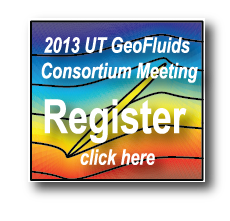
2013 UT GeoFluids Consortium Meeting
Registration is open for the 2013 UT GeoFluids Consortium meeting and workshop Feb. 21 and 22, 2013 on the downtown U.T. Campus at the AT&T Executive Education and Conference Center.
Posted October 2012
Andrew Smith Joined Successful Mission for AMGG Research School
Andrew Smith is currently working with Juergen Meinert and Stefan Buenz in the arctic marine geology and geophysics group at the University of Tromsø. He recently participated in scientific cruises to acquire high-resolution 3D seismic and multi-component data using University of Tromsø's research vessel FF Helmer Hanssen. Below is a picture of Andrew on his voyage. For more information on the cruise visit the University of Tromso site.
Posted August 2012
Peter Polito gives talk on JR field test of Downhole tools
On June 27th Peter Polito gave a talk titled "Curacao to Bermuda to the Jersey Slope to Central Park: The trials and tribulations of developing IODP technologies" to the researchers and staff of the Bureau of Economic Geology.
Summary: Over the past decade the GeoFluids group has been developing and testing a penetrometer and corresponding delivery system to be deployed on the JOIDES Resolution. Over the past year we have undergone an extensive stretch of land based bench testing in preparation for sea trials. For two weeks in May and June we were deployed on the JR in preparing for our tests while the ship transited from Curacao to Bermuda to our test site. For 48 hours straight we ran a series of tests on the New Jersey Slope with some success, a healthy dose of humility, and an education on working at sea. On June 8, at approximately 4pm I sat in Central Park, exhaled, and had a beer.
You can view Polito's powerpoint presentation here.
Visit http://www.ig.utexas.edu/research/facilities/downhole/ for more information on the Down-hole Technologies for Ocean Drilling
Posted July 2012
New Data Posted: Compression and permeability behavior of resedimented Nankai - Silt mixtures
Julia Schneider Reece performed an experimental study similar to the one on Boston Blue Clay (BBC) - Silt mixtures. However, here Julia used a marine, deepwater mudstone from offshore Japan, that was drilled during Integrated Ocean Drilling Program (IODP) Expedition 322, as the baseline mudstone instead of BBC. Then she added the same silt-sized silica to the Nankai mudstone in five varying proportions in order to analyze how grain size and also mineralogy affect compression and permeability behavior over a large range in stress (up to 21 MPa). The mineralogy of the Nankai mudstone is significantly different from BBC. The Nankai mudstone consists of almost 50% of smectite (weight %).
Julia prepared these homogeneous mudstone mixtures in the laboratory using the resedimentation technique. After pre-loading the samples to 100 kPa in the resedimentation tests, she conducted constant-rate-of-strain consolidation tests to a maximum vertical effective stress of 21 MPa, equivalent to about 2 km of burial under hydrostatic conditions. Microstructure and fabric of all samples were analyzed at two different stress states in scanning electron microscope images.
Find all UT GeoFluids data on the Member's Data Page.
Posted July 2012
Andrew Smith Awarded Master's Degree
On May 19th Andrew Smith was awarded his Master's degree. His thesis was entitled "Observations and Models of Venting at Deepwater Gulf of Mexico Vents". Andrew's work focused on the process of venting and associated hydrate formation at deepwater vents in the Gulf of Mexico. After completing his MS, he will join the marine geology and geophysics research group at the University of Tromsø in Norway as a Fulbright scholar. We wish Andrew the best of luck in his new adventure.
Posted June 2012
Athma Bhandari Joins UT GeoFluids Group
We are excited to welcome Athma Bhandari to the UT GeoFluids group as a postdoctoral fellow. Athma earned his Ph.D. from University of Southampton, and M. Eng degree in Civil Engineering from the University of Tokyo. Athma's main research interests lie in experimental geomechanics, more specifically, laboratory study of deformation and flow in geomaterials (soils and rocks). During his PhD, he developed a novel digital image-based deformation measurement system for triaxial tests and used it to study the initiation and evolution of failures in a naturally locked sand. He examines the underlying mechanics of observed macro-scale behavior of geomaterials. In his work with UT GeoFluids Athma will will focus on measuring and interpreting mass transport in low permeability shales.
Posted May 2012
Andrew Smith Awarded Best Student Presentation at the Gordon Research Conference on Natural Gas Hydrate Systems 2012
The 2nd Annual Gordon Research Conference on Natural Gas Hydrates was held March 18-23 in Ventura, CA. Andrew Smith presented his poster titled "Multiphase heat and salt transport at a deepwater gulf of Mexico vent." Andrew was honored with the Best Student Presentation Award.
Abstract:
Deepwater vents in the Northern Gulf of Mexico are actively releasing water and hydrocarbons. They are ubiquitous across the continental slope, and we focus on one in the Ursa Basin at lease blocks MC852/853. The vent is elevated ~75 meters relative to the surrounding seafloor, and its core is ~1.6 km in diameter. It is bounded by a strong negative polarity seismic reflection. We interpret that this reflection records a negative impedance contrast marking the boundary between hydrate above and gas below: it is the Bottom Simulating Reflector (BSR). This BSR rises sharply at the boundaries of the vent and is horizontal within a few meters of the seafloor beneath the vent edifice. High temperature gradients and elevated salinities are present within the vent (Ruppel et al., 2005; Paull et al., 2005). We model the coexistence of elevated temperature gradients, saline fluids, and an uplifted BSR by assuming that warm, salty fluids are sourced from depth and expelled vertically through the vent conduit. We show that both the observed temperature gradients and salinities cannot be reconciled with a single-phase flow model. They can, however, be reconciled if gas and water are flowing upwards together, and if the flux of gas is large relative to the flux of water. A better understanding of the hydrogeological processes at vents is important for estimating the fluxes of water and gas from vents and for understanding the conditions under which deep-sea biological communities exist at vent locations.Related References:
Smith, A. J., Flemings, P.B., Fulton, P.M. , in review, Hydrocarbon flux from natural deepwater Gulf of Mexico vents, SciencePosted April 2012
UT GeoFluids Consortium Meeting
The 2012 UT GeoFluids Consortium Meeting, held February 16 – 17, was enthusiastically reviewed by approximately 70 attendees representing 10 different companies. Some of the meeting highlights included preliminary observational and modeling results from the new field study at Mad Dog, the first demonstration of experimental capability in resistivity measurements, and a synthesis talk on our work on resedimented mudstones around the world.
The newly developed experimental database for consortium members was launched at this years' meeting. This database gives members immediate access to laboratory test results, analysis and scanning electron microscope (SEM) images of the various substrates tested within the GeoMechanics Laboratory.
Presentation are available to consortium members on the 2012 meeting site.
Mark your calendar for the 2013 meeting Feb. 21 and 22, 2013 on the downtown U.T. Campus at the AT&T Executive Education and Conference Center.
Peter B. Flemings presentation to 2012 Consortium MembersPosted March 2012
UT GeoFluids Workshop
January 10 - 14 the UT GeoFluids personnel gathered in Burnett TX for the annual GeoFluids workshop.
Posted January 2012
Julia Schneider Awarded Doctoral Degree
On December 3rd Julia Schneider was awarded her doctoral degree. Her dissertation was entitled "Compression and permeability behavior of natural mudstones". Julia will continue her research with the UT GeoFluids Consortium as a Postdoctoral Fellow. We are excited to have her stay on and look forward to her talks at the upcoming UT GeoFluids Consortium Meeting.
Posted December 2011
Recent Publications
Gang Luo and Maria Nikolinakou have two upcoming publications in the AAPG Bulletin on geomechanical modeling and pore pressure response in salt-sediment systems. You may access their publications at the following links with your company log in.
Luo, G., Nikolinakou, M.A., Flemings, P.B., Hudec, M.R., Geomechanical modeling of s tresses adjacent to salt bodies: 1. Uncoupled models, AAPG Bulletin, (in press)
Nikolinakou, M.A., Luo, G., Hudec, M.R., Flemings, P.B., 2011, Geomechanical modeling of stresses adjacent to salt bodies: 2. Poro-Elasto-Plasticity and Coupled Overpressures, AAPG Bulletin (in press).Posted November 2011
Andrew Smith Attends ICGH
In July 2011, Andrew Smith traveled to Edinburgh, Scotland to present ongoing research on a gas vent in the Gulf of Mexico at the 7th International Conference on Gas Hydrates. His oral presentation focused on identifying the hydrogeological process of gas venting and the associated hydrate formation. He discussed his research with experts in the field of natural gas hydrates and received invaluable feedback that will help him as he completes his Master's thesis this year.
Posted July 2011
Congratulations to Julia Schneider
Julia received an ‘Outstanding Student Paper Award’ from the Mineral and Rock Physics Section of AGU. Her poster was presented at the Fall 2010 AGU meeting in San Francisco and was entitled “Experimentally derived model to predict permeability behavior of mudstones.”
Posted April 2011
Yao You Receives 'Best Poster' Award
Congratulations to Yao You (Doctoral Candidate) for receiving a 'Best Poster' award for his presentation "Coupling of the evolution of pore pressure and the retrogressive slope failure during breaching " at the recent SIAM Conference on Mathematics & Computational Issues in the Geosciences held in Long Beach California.
Posted March 2011
New Consortium Member
Statoil has joined the UT GeoFluids consortium and will attend the 2011 consortium meeting. We are excited to welcome Statoil to the UT GeoFluids Consortium.
Posted February 2011
UT GeoFluids Workshop
On Jan 12 - 16, the GeoFluids Team had a research workshop at Canyon of the Eagles on Lake Buchanan. They practiced presentations, worked on research, and spent quality time as a group.
Posted January 2011
Derek Sawyer Awarded Doctoral Degree
Derek Sawyer was awarded his doctoral degree from The University of Texas December 4, 2010. His dissertation was entitled "Failure mechanics, transport behavior, and morphology of submarine landslides".
Derek studied sedimentation, deformation, and fluid flow on continental margins. His study area was the Mars-Ursa region outboard of the Mississippi River on the upper Mississippi Fan, Gulf of Mexico. Rapid Pleistocene sedimentation of a sand-rich basin-floor fan, two channel-levee systems, and numerous submarine landslides created a fascinating hydrodynamic system. He participated on Integrated Ocean Drilling Program Expedition 308 as a shipboard sedimentologist and has had summer internships at BP and Shell as a graduate student.
Derek has joined ExxonMobil in Houston, Texas in the Operations Geology group.
Posted December 2010
Message from the Director
UT GeoFluids Update: GEOFLUIDS MEETING Feb. 17-18, 2011 in Austin TexasThis is an update on the UT GeoFluids Consortium. We have been hard at work here in Austin Texas!
- Our annual meeting will be held on February 17-18, 2011 in Austin, Texas. Please hold the date. Details will be forthcoming
- As always, our website can be found here: http://www.beg.utexas.edu/geofluids/. There is a 'members only' button that you can access with your companies username and password. If you don't know the username and password, please contact me (pflemings@jsg.utexas.edu) and I will forward it to you.
- I am very pleased to announce that Tessa Green has accepted a position as Program Coordinator for UT GeoFluids. Many of you will meet her in person or by email.
- Recent publications:
- Our online software (Frac, McFrac, and Pstar) have been modified to work on the web and may be accessed here: http://www.beg.utexas.edu/geofluids/g4/software.php
- Student news:
Please drop me a note if you have any questions.
I look forward to seeing many of you in February.
Peter B. Flemings
Jackson Professor of GeoSystems
Jackson School of Geosciences
http://www.ig.utexas.edu/research/projects/basin/
pflemings@jsg.utexas.edu
tel: 512-475-9520Posted November 2010
Flemings Presents Talk at BEG Seminar
Dr. Peter Flemings presented a talk entitled Deep pore pressures and seafloor venting in the Auger Basin, Gulf of Mexico as part of the Bureau of Economic Geology seminar series. You can view the streaming video of the presentation online at: http://www.beg.utexas.edu/abs/Flemings_040910.php
Abstract: Pore fluid overpressures in four reservoir sandstones in the Auger Basin, deepwater Gulf of Mexico, are similar across the basin, suggesting that these sandstones are hydraulically connected over distances >20 km. Small overpressure gradients within them suggest upward flow rates between 1 and 20 mm/yr. At the crest of these sandstones, pore pressure equals or exceeds the least principal stress, and we interpret that high fluid pressure is fracturing the caprock and driving flow vertically. A well drilled into the crest of the Auger sandstones confirmed the presence of extreme overpressures that converge on both the least principal stress and the overburden stress. Above these zones, spectacular mud volcanoes are venting fluids today. Overpressured aquifers with significant structural relief may drive fluid vents and mud volcanoes around the world.Posted May 2010
2010 Consortium Meeting
The UT GeoFluids Annual Meeting 1.0 was held on February 11-12, 2010 at the University of Texas at the Pickle Research Campus. More than 40 industry attendees represented the 10 members of the consortium. The UT team presented more than 20 talks on their cutting-edge research. A special thank you to Neil Braunsdorf and Brent Couzens of Shell for also giving presentations. For more information on the meeting, including the presentations and attendees, please see the meeting website at the link above.
Posted March 2010
October 16, 2009 - Following are the abstracts for the papers that have been accepted from UT GeoFluids researchers for the upcoming 4th International Symposium of Submarine Mass Movements and Their Consequences in Austin, Texas, November 7 – 12, 2009.
For more information on this conference, visit http://www.beg.utexas.edu/indassoc/dm2/Conference2009/home.htm
Subaqueous Landslides in Clay-Rich Systems
Derek E. Sawyer, Peter B. Flemings, David MohrigWe simulated subaqueous landsliding within sedimented beds of clay-rich material. We deposited beds inside a flume and gradually increased the bed angle until failures developed. In a preliminary experiment, localized debris flows developed at bed angles of ~25° in a thin (2 cm thick) bed of kaolinite clay (60% by weight) and silica silt (40% by weight). Failure surfaces were confined to the upper 0.5cm. In one flow we observed outrunner blocks that accelerated away from the main flow and created linear grooves along the upper bed surface. In future experiments we aim to understand: 1) how landslide rates and styles vary as a function of material properties (clay mineralogy, grain size, and presence of thin interbeds of sand); and 2) the process of retrogression by measuring pore pressure in several locations behind retrograding headscarps. This work will illuminate the processes that drive subaqueous landsliding on continental slopes.
Exploring the Origin and Characteristics of Mass Transport Deposits
Ursa Basin, Gulf of Mexico
Hilary E Strong, Peter B Flemings, Ruarri J. Day-Stirrat, Derek E. Sawyer, Julia SchneiderSeismic, core, and logging data from Integrated Ocean Drilling Program (IODP) Expedition 308 record multiple Mass Transport Deposits (MTDs) within the upper 600 meters below seafloor (mbsf) of the Ursa Basin, northern Gulf of Mexico. The most prominent, MTD-2, is 35 to 100m thick, spans all three drill sites – U1324, U1323 and U1322 – and is located approximately 100 mbsf. MTD-2 is seismically imaged with a positive, low-amplitude top reflection, and negative, high-amplitude basal reflection. MTD-2 is identified in core and logging data as a low porosity, high bulk density, zone. At U1324, the basal sediments of MTD-2 are 7 porosity units less than those immediately below, while at U1322, the basal sediments are 10 porosity units less. This decline in porosity corresponds to a 5% increase in bulk density from overlying bounding sediments to MTD-2. We hypothesize that MTD densification is a result of sediment remolding during debris flow. Remolding is defined as shearing sediment at unaltered water content, thus removing the original fabric and resulting in weaker, more compressible material. We also suggest that the arrested flow is buried and consolidated under uniaxial strain. Initial high resolution X-ray texture goniometry (HRXTG) fabric analysis shows greater basal plane alignment of smectite and chlorite in a MTD specimen, compared to a non-MTD specimen. Mercury Injection Capillary Pressure (MICP) tests confirm a reduction in pore throat size within the MTD-2; however this is a function of decline in porosity, not position within the MTD. Consolidation curves from initial uniaxial experiments show that at a given porosity, a synthetically remolded specimen has on average a 2MPa lower vertical effective stress than the original intact specimen. Pre-consolidation effective stresses measured for Constant Rate of Strain (CRS) consolidation tests on 11 MTD and 13 non-MTD Ursa specimens suggest that the pre-consolidation stresses are approximately the same whether within or outside of an MTD. We further explored these hypotheses through CRS tests on 3 intact Ursa core specimens above MTD-2 (75mbsf), below MTD-2 (125mbsf) and within MTD-2 (115mbsf). Our results show (1) Weaker consolidation curves for MTD vs. non-MTD specimens; (2) Decreased sediment compressibility correlating with decline in porosity, irrespective of location within MTD vs non MTD; (3) Slightly higher permeability within the MTD, but still within the range of Ursa mudstones; and (4) No distinction in linear pre-consolidation stress trend between MTD and non-MTD specimens. Ultimately, MTDs pose a hazard because it takes longer for suction anchor piles and jetted conductors – installed for production platforms – to penetrate MTDs relative to bounding sediment.
History of pore pressure build up and slope instability in mud-dominated
sediments of Ursa Basin, Gulf of Mexico continental slope
Roger Urgeles, Jacques Locat, Derek E. Sawyer, Peter B. Flemings, Brandon Dugan4 and Nguyen Thi Thanh BinhThe Ursa Basin, at ~1000 m depth on the Gulf of Mexico continental slope, contains numerous Mass Transport Deposits (MTDs) of Pleistocene to Holocene age. IODP Expedition 308 drilled three sites through several of these MTDs and encompassing sediments. Logs, sedimentological and geotechnical data were collected at these sites and are used in this study for input to basin numerical models. The objective of this investigation was to understand how sedimentation history, margin architecture and sediment properties couple to control pore pressure build-up and slope instability at Ursa. Measurements of porosity and stress state indicate that fluid overpressure is similar at the different sites (in the range of 0.5 to 0.7) despite elevated differences in sedimentation rates. Modeling results indicate that this results from pore pressure being transferred from regions of higher to lower overburden along an underlying more permeable unit: the Blue Unit. Overpressure started to develop at ~53 ka, which induced a significant decrease in FoS from 45ka, especially where overburden is lower.
Failure caused by breaching in subaqueous sand
Yao You, Peter B. Flemings, David MohrigSubmarine failures can be divided into two categories: liquefaction failure and breaching failure. During liquefaction failure the sediment matrix contracts while during breaching failure the sediment matrix dilates. Dilation causes the pore pressure in the sediment deposit to decrease, thereby temporarily increasing its shear strength. The tangent of failure angle increases in proportion with the ratio of effective stress to total stress: . Degree of dilation is greatest near the failure front and decays quadratically with distance away from failure. Finer sand or poorly sorted sand creates a higher failure angle and slower erosion rate during breaching because of stronger dilative response and lower diffusivity. In preliminary experiments we have documented pressure drawdown and identified the fraction due to dilation and the part due to change in stresses. We will present recent results from laboratory experiments and a numerical model that characterize how the behaviors of the dilative failures vary with different sand compositions.
Posted October 2009
June 10, 2009 - Hilary Strong, an M.S. student with the UT GeoFluids Consortium, received third place in the AAPG student poster competition for her Poster entitled, Consolidation Characteristics of Mass Transport Deposits in Ursa Basin, Northern Gulf of Mexico
ABSTRACT: Seismic, core, and logging data from Integrated Ocean Drilling Program (IODP) Expedition 308 record multiple Mass Transport Deposits (MTDs) within the upper 600 meters below seafloor (mbsf) of the Ursa Basin, northern Gulf of Mexico. The most prominent, MTD-2, is 35 to 100m thick, spans all three drill sites – U1324 U1323 and U1322 – and is located approximately 100mbsf. MTD-2 is seismically imaged with a positive, low-amplitude top reflection, and negative, high-amplitude basal reflection. MTD-2 is identified in core and logging data as a low porosity, high bulk density, zone. At U1324, the basal sediments of MTD-2 are 7 porosity units less than those immediately below, while at U1322, the basal sediments are 10 porosity units less. This decline in porosity corresponds to a 5% increase in bulk density from overlying bounding sediments to MTD-2. We hypothesize that MTD densification is a result of sediment remolding during debris flow. Remolding destroys the original chaotic fabric, resulting in shear-aligned grains that have lower porosity. We also suggest that the arrested flow is buried and consolidated under uniaxial strain. Initial high resolution x-ray texture goniometry (HRXTG) fabric analysis shows greater basal plane alignment of smectite and chlorite in a MTD specimen, compared to a non-MTD specimen. Consolidation curves from initial uniaxial experiments show that at a given porosity, a synthetically remolded specimen has on average a 2MPa lower vertical effective stress than the original intact specimen. Pre-consolidation effective stresses measured for Constant Rate of Strain (CRS) consolidation tests on 11 MTD and 13 non-MTD Ursa specimens suggest that the pre-consolidation stresses are approximately the same whether within or outside of an MTD. We will further explore these hypotheses through HRXTG fabric analysis and CRS tests on natural and synthetically remolded Ursa core specimens. If our hypotheses are correct, we expect (1) weaker consolidation curves for MTD vs. non-MTD specimens; (2) Similar consolidation curves for MTD and remolded specimens; (3) No distinction in linear pre-consolidation stress trend between MTD and non-MTD specimens; and (4) Chaotic fabric in non-MTDs, and shear-aligned fabric in remolded and MTD specimens. Ultimately, MTDs pose a hazard because it takes longer for suction anchor piles and jetted conductors – installed for production platforms – to penetrate MTDs relative to bounding sediment.
Posted June 2009












